
IN THIS ISSUE...
FALL 2020 VOLUME 66 NUMBER 3
PLANT SCIENCE
BULLETIN
A PUBLICATION OF THE BOTANICAL SOCIETY OF AMERICA
Getting Started in Tropical Field Research,
by Kadeem Gilbert...p. 243
Diversity and Inclusion in the Sciences,
by Beth Ginondidoy Leonard .... p. 191
The Shapes of Botany, by BSA President
Cynthia Jones...p. 174
What Have We Learned?
Lessons and Strategies
from the Chaos
By Dr. Bryan
Dewsbury
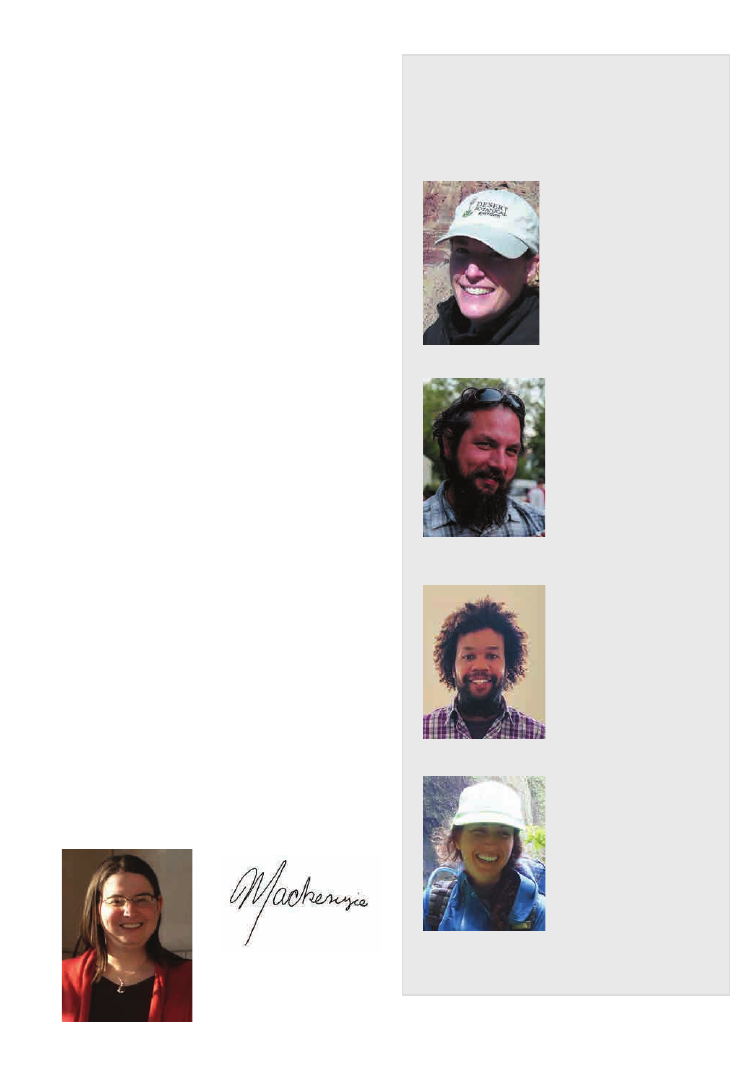
Fall 2020 Volume 66 Number 3
PLANT SCIENCE BULLETIN
Editorial Committee
Volume 66
From the Editor
Shannon Fehlberg
(2020)
Research and Conservation
Desert Botanical Garden
Phoenix, AZ 85008
sfehlberg@dbg.org
David Tank
(2021)
Department of Biological
Sciences
University of Idaho
Moscow, ID 83844
dtank@uidaho.edu
James McDaniel
(2022)
Botany Department
University of Wisconsin
Madison
Madison, WI 53706
jlmcdaniel@wisc.edu
Seana K. Walsh
(2023)
National Tropical Botanical
Garden
Kalāheo, HI 96741
swalsh@ntbg.org
Greetings,
This final 2020 issue of PSB comes at what feels like
an unprecedented moment. As I write this, the U.S.
Presidential election is essentially over. However,
due to pending recounts, litigation, and spreading
disinformation, the transition of power is shaping
up to be, at minimum, chaotic. At the same time,
the world is still in the midst of the COVID-19
pandemic and the U.S. has just posted a record
number of cases reported on a single day and a
record number of hospitalizations. When I’m not
teaching twice as much as usual to accommodate
both my students who are meeting in person and
my students who are in quarantine, I find myself
“doom-scrolling” the latest news and opinions.
Since its first issue, PSB has been the place where
members of the Society can confront current
events and acknowledge current problems in
science, academia and education. In this issue,
we present an article by BSA President Cindi
Jones that reflects on “The Shape of Botany” and
demonstrates how we can learn from the past
and act for the future. These themes are also
highlighted in articles by Bryan Dewsbury and
Beth Ginondidoy Leonard that specifically address
issues of diversity and inclusion. How do we, as a
community of scientists and educators, address the
inequality and systematic oppression engrained in
our institutions and promote equity and justice?
In the student section, we check in on the ongoing
impact of the pandemic on our student members.
I hope that you find the articles in this issue timely
and motivating. I send warm wishes to all as 2020
draws to a close.
Sincerely,
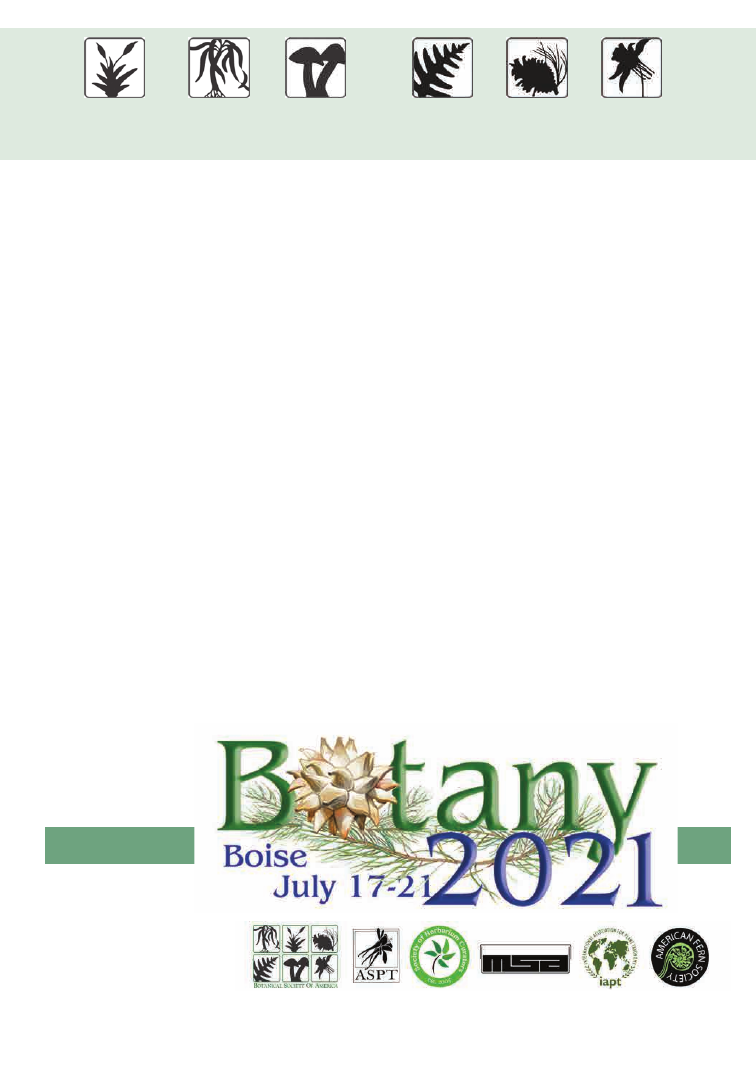
173
TABLE OF CONTENTS
SOCIETY NEWS
The Shapes of Botany..........................................................................................................................................174
Advocate for Botany and Science! ................................................................................................................185
SPECIAL FEATURES
Diversity and Inclusion in the Sciences: Relationships and Reciprocity ..................................191
What Have We Learned? Lessons and Strategies from the Chaos .........................................198
The Teaching Botanist: William F. Ganong and the Botanical Society of America...........206
SCIENCE EDUCATION
BSA Awarded $3.9m Grant for PlantingScience....................................................................................231
STUDENT SECTION
Shifting Gears: Fieldwork, Benchwork, and Greenhouse Studies during COVID-19 .......236
Getting Started in Tropical Field Research..............................................................................................243
ANNOUNCEMENTS
In Memoriam - Brian Joseph Axsmith (1963–2020) ..........................................................................250
MEMBERSHIP NEWS ...................................................................................................................................
254
BOOK REVIEWS ...............................................................................................................................................
255
Looking forward to
meeting with these
premier scientific societies!

174
SOCIETY NEWS
This article by BSA President Cynthia Jones is
based on her BSA Incoming President Address
at Botany 2020.
For most of my career, my research has
focused on the evolution, development,
and functional significance of leaf shape:
physical, tangible forms in space. However,
in this essay, I’m not going to address leaf
shape, but instead leverage some of the
other 14 definitions of shape (https://www.
merriamwebster.com/dictionary/shape) to
reflect on where I see the BSA today, on our
“national aspirational capacity for botanical
education” at the undergraduate level, and on
teachable moments for botanists presented
by the human emotional need for plants in a
pandemic.
The BSA was formally established in 1893 to
“unify and subserve the botanical interests of
the country” (Diggle, 2013). A scroll through
the Past Presidents on the BSA website shows
that the Society elected its first President in
1894. Between 1984 and 1972, only 3 out of
78 presidents were women. Since 1972, the
percentage of women serving in this role has
gone up by an order of magnitude relative
to the period preceding 1972 (Fig. 1). Why
focus on 1972? In 1972, Title IX became law.
Title IX stated that no person could be denied
participation in, or reap benefits from, or be
subjected to, discrimination in any educational
program or activity receiving federal assistance
on the basis of their sex. Shortly after, in 1973,
the Supreme Court decision Roe v. Wade gave
women rights associated with reproductive
choice. Both of these events accompanied a
new phase of the women’s movement and the
BSA responded. Clearly, intention and effort
can change scientific societies, even if it takes
50 years!
Recent events have led to heightened
reflection on the role of race and ethnicity
in perpetuating inequities, and the BSA is
owning its part in this situation. We intend
to create a more equitable and welcoming
Society. We will make every effort possible
to fight discrimination against people who
are black, indigenous, or persons of color. We
acknowledge that we have a lot of work to do:
optional responses to this year’s membership
form show what we all already know: over
50% reported as white (Fig. 2), and the actual
The Shapes of Botany
By Cynthia S. Jones
Department of Ecology and
Evolutionary Biology
University of Connecticut,
Storrs, CT 06269 USA
ACKNOWLEDGMENTS
I thank Marsh Sundberg for generously
sharing his data files. I am also
grateful to Charlie Henry for combing
through 154 college catalogs on-line
to document their course offerings in
basic plant biology.
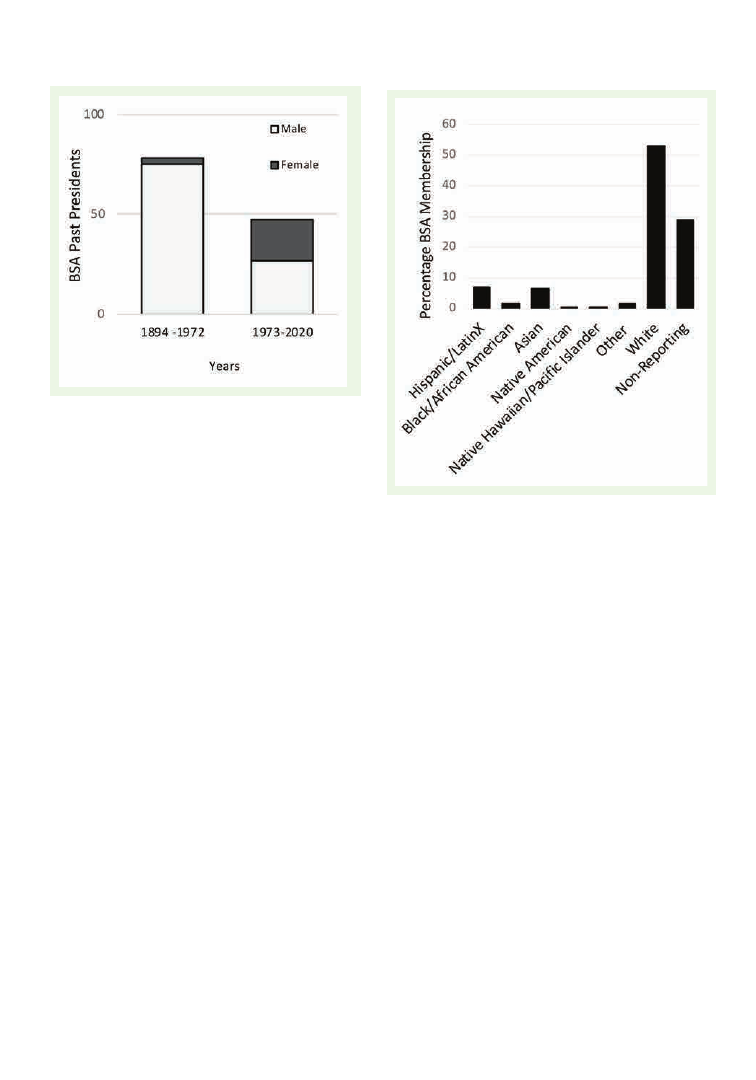
PSB 66 (3) 2020
175
percentage is likely higher as some if not most
of the 30% who declined to report may be
white. We will strive harder to become more
diverse, such that we become a scientific
society where the contributions of BIPOC
members are welcomed, recognized, and
celebrated.
What actions is the BSA taking? This Fall, the
BSA is embarking on a new strategic plan that
will define the Society’s priorities for the next
five years. Diversity, Equity and Inclusion (DEI)
will be one of four pillars of this plan. In the
shorter term, BSA staff and the BSA Board of
Directors and the Committee on Committees
will undergo training in Diversity, Equity and
Inclusion. At Botany 2020 Virtual, we hosted
our first BIPOC Mixer for members and their
allies, and we also hosted an open forum on
diversity. The Executive Director is working
with the BSA Committee on Diversity, Equity
and Inclusion on new tracking metrics that will
allow us to tell if our initiatives are working,
and beginning this Fall we will revamp the
process of selecting candidates for leadership
positions and membership on committees
with the goal of making these processes
as equitable, accessible, and transparent
as possible. Finally, the BSA will support
initiatives, such as Black Botanists Week, that
are independent of the BSA but that support
and encourage BIPOC researchers, educators,
and others who are passionate about plants.
Changing themes of this essay, I want to relate
a story. In the late 1990s, I had a student in
a course who seemed unhappy. The second
week, I mentioned that I had noticed her
demeanor. She responded that she didn’t
really “like” plants, but that she was a senior
and she needed the course to fill a graduation
requirement. We talked about strategies for
approaching the course and in the end she
did well. As she turned in her final exam, she
Figure 1. Past Presidents of the BSA. Prior to
1972, 4% were female; since then, 43% have
been female.
Figure 2. Percentage of members reporting race
and ethnicity data based on BSA 2020 mem-
bership renewal.
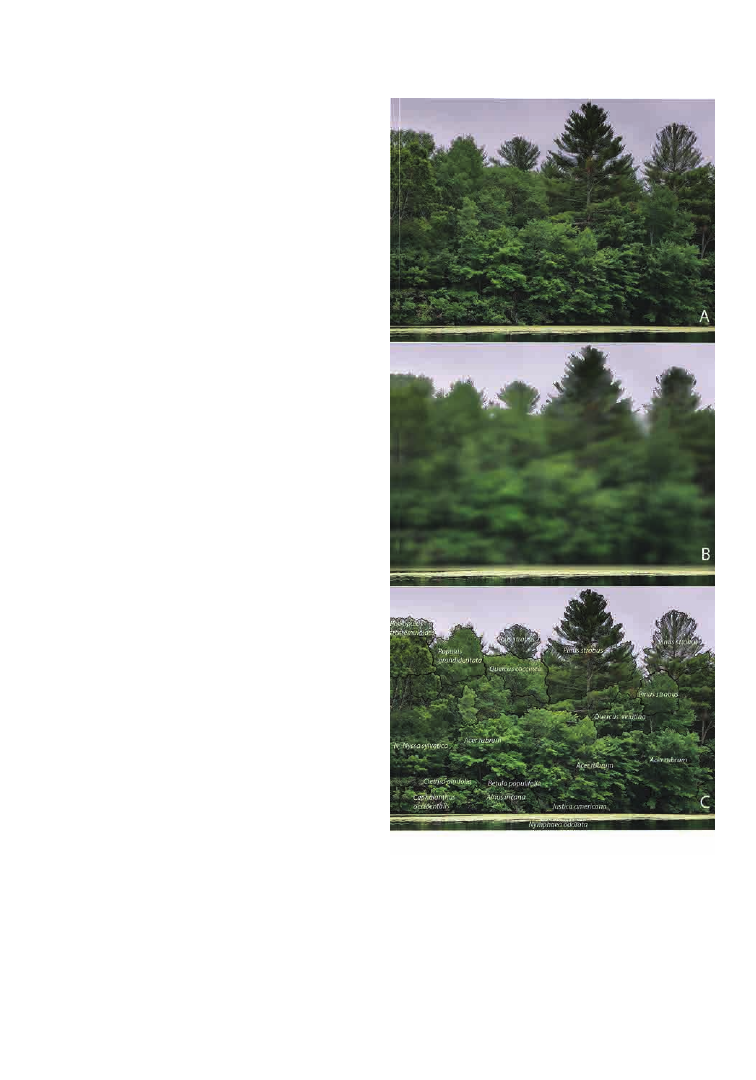
PSB 66 (3) 2020
176
said, “I don’t know if I should thank you or
not.” I was surprised and responded that I
had been under the impression she liked the
course. She replied, “Well, yeah, but life was
less complicated when I looked at the side
of the road and just saw a lot of green.” Now,
“I see individual plants… it makes my brain
work too hard.”
This conversation was my first realization that
when many people, including students, view a
scene with vegetation such as Fig. 3A, they are
seeing something more like in Fig. 3B: a smear
of green. It is worth noting that seeing a smear
of green isn’t bad. Color phycologists will tell
you that most people report feeling calm and
restored after seeing green (Elliot and Maier,
2014). In fact, one of the first publications
describing the “moral associations” of humans
to color was by Johann Wolfgang von Goethe,
translated into English by C. L. Eastlake in
1840 (Goethe, 1810). In his treatise Theory of
Colours, Goethe wrote of green that “the eye
experiences a distinctly grateful impression
from this colour” (p. 316). But as botanists,
we don’t see a smear of green: we see diversity
(Fig. 3C). We see shapes, colors, interactions,
and species. We study how diversity evolved,
how it is maintained, and how diversity will
respond to climate change. We know that
plant diversity forms the cornerstone of
ecosystem stability and resilience (e.g., Tilman
et al., 2014; Anderegg et al., 2018).
Given the importance of plant species
diversity in terms of ecosystem responses
to climate change, I wondered whether the
concept of diversity had yet infiltrated how
botany is presented in what I think of as
mainstream information. The answer is
“not really.” Googling “botany” brought up
five sites at the top of the page. The first is a
definition of botany. The second is Wikipedia,
Figure 3. A, New England forest on the edge of
Echo Lake, Mansfield Center, CT. Photo taken
by the author. B, The author’s impression of
what students see. C, What botanists see.
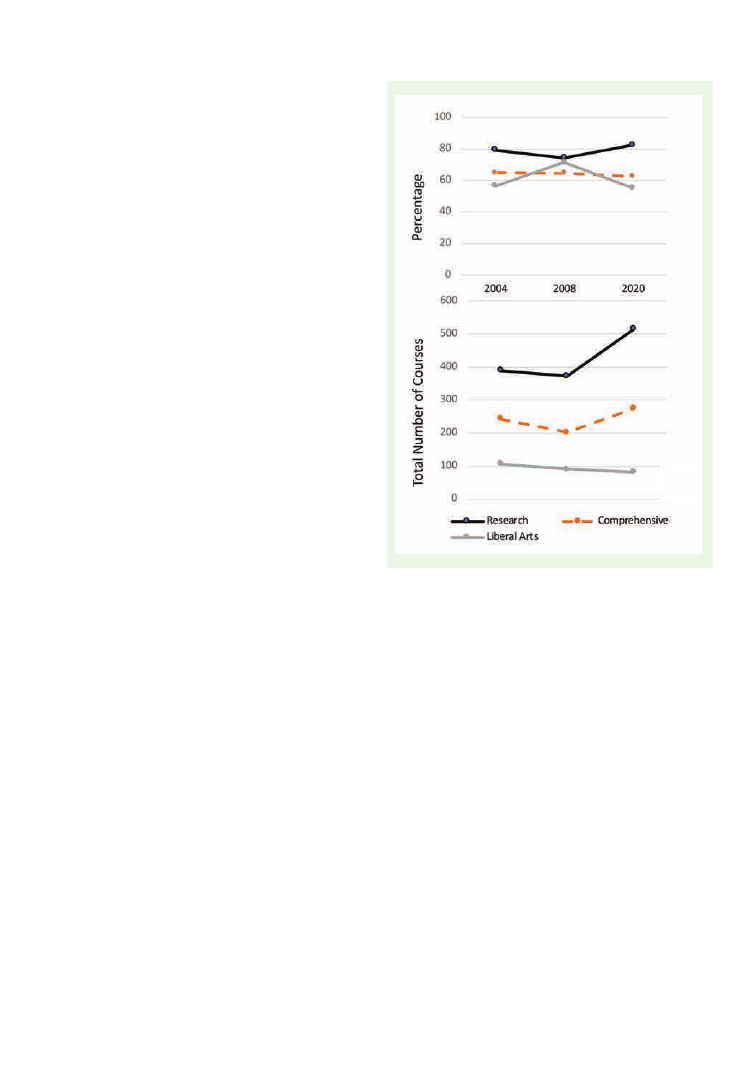
PSB 66 (3) 2020
177
which mentions biodiversity in the last line
at the end of the fourth paragraph. An entry
in Britannica follows that does not mention
diversity. Fourth is the BSA site that mentions
major groups of plants. The fifth site describes
careers in environmental science (https://www.
environmentalscience.org/). The introduction
to Botany at this latter site makes no mention
of diversity, but does include a statement I
questioned: “Many of the top universities have
botany degrees, but there has been a decline in
recent years of students taking botany in favour
of other environmental and natural sciences.”
Is this true? Do many of the top universities
have botany degrees? Has there been a decline
in recent years in students taking botany?
While not addressing these questions directly,
surveys of course catalogs of institutions
of higher learning provide some insights.
Marsh Sundberg (2004) published one such
survey that provides baseline data. In 2008,
Sundberg revisited the same course catalogs
and updated the information for a talk
he presented at Botany 2008 (http://2008.
botanyconference.org/engine/search/index.
php?func=detail&aid=194). Using the
Sundberg 2008 data set as a starting place,
we revisited course catalogs of the same
154 institutions. We searched for Botany
Departments or any department with
Botany in its name. I assumed the number
of departments with “Botany” in the name
would be correlated with the numbers of
departments that award degrees in botany,
with the caveat that some institutions that
had removed Botany from the name of their
department could retain a botany degree.
Even in 2004, with a few exceptions,
only Research Universities had Botany
departments. Of those surveyed in 2004,
41% had departments with Botany in the
name. By 2020, that number had dropped to
12%, indicating that in fact “most of the top
universities” no longer offer botany degrees.
The second issue raised on the “Environmental
Science Introduction to Botany” website was
that there has been a decline in the number
of students enrolling in botany courses. I did
Figure 4. Data based on course catalogs from
154 institutions of higher education. A, Per-
centage of institutions offering freshman level
courses. B, Total number of courses beyond
freshman level offered in each category. Num-
bers of institutions included in the study: in
2004, 58 research institutions, 60 comprehen-
sive institutions, and 55 liberal arts colleges; in
2020, 57 research institutions, 48 comprehen-
sive institutions, and 49 liberal arts colleges.
B
A
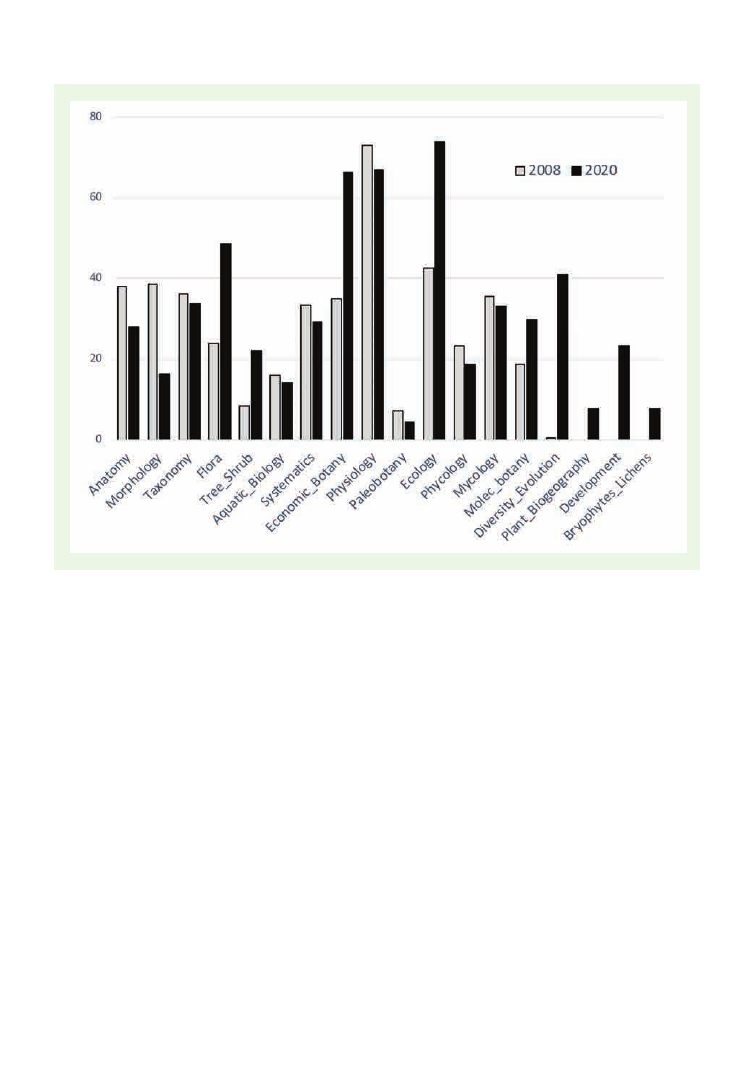
PSB 66 (3) 2020
178
not investigate enrollment numbers, but we
were able to record courses offered in course
catalogs. More generally, I was interested in
whether the decline in “Botany” departments
translated to a decline in botanical education
at the collegiate level. Assuming that
institutions of higher learning update their
catalogs periodically and drop (most) courses
no longer offered, and assuming that these
institutions do not continue to support
courses with low enrollments, we looked
at the percent of these 154 schools offering
courses that were primarily focused on basic
plant biology as a proxy for enrollments. We
found that at the freshman level, there has
been very little change in the number of the
introductory courses focused on botanical
instruction (Fig. 4A). The very good news
is that there also has been no decline in
the numbers of courses offered above the
freshman level (Fig. 4B). In other words, our
“national aspirational capacity” for instruction
in the fundamental biology of plants appears
to be as strong today as it was 16 years ago,
despite the dramatic decrease in the number
of botany departments! Considering different
types of courses, the general distribution
is roughly the same (Fig. 5), although new
courses (e.g., Plant Development or Evolution
and Diversity) have been added as others (e.g.,
Morphology) have declined.
Botany classes are especially important
because our labs satisfy many criteria for
creating excellent learning opportunities (e.g.,
Nilson, 2010). They are multimodal, active,
Figure 5. Percentage of institutions offering courses in various botanical disciplines and areas of
student. Grey = 2008, black = 2020.
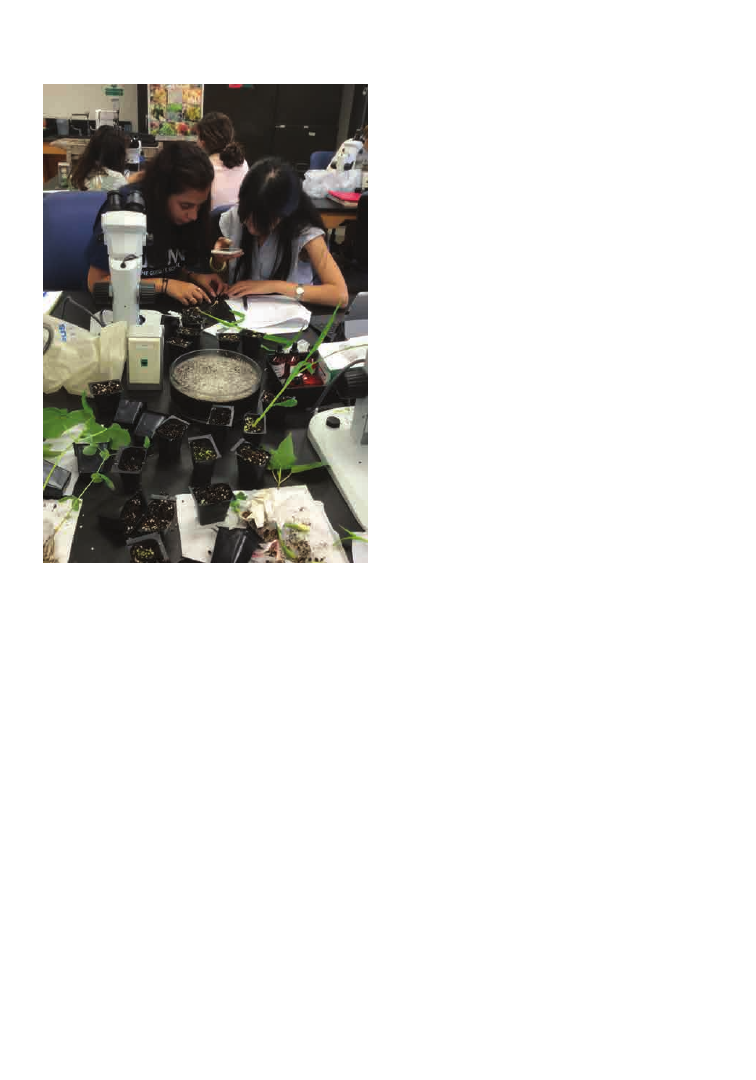
PSB 66 (3) 2020
179
and engage multiple senses and incorporate
many of the skills necessary for STEM
education, such as graphing, data analysis,
and observation-based hypothesis testing
(Fig. 6). Our labs also present plant diversity
in ways that images and lectures cannot
accomplish. Often not appreciated, our labs
have the potential for unusually high levels
of student engagement because they include
living material, as compared to most modern
animal-oriented courses.
Providing living material comes with a fairly
high cost, especially if the material is provided
by greenhouses. Greenhouses are expensive
to build and to maintain, and we periodically
hear examples of universities that make the
decision not to continue to support them,
Figure 6. Botany labs provide engaged learning
opportunities.
especially if the greenhouses are not tied to
research. Data always help make the case to
administrators that greenhouses are critical
to basic plant biology education, but I’ve
never seen any multi-institutional data on
greenhouse use or support. (Please contact
me if you know of any!) To address this data
gap, I published a survey in the February 2020
issue of the BSA’s monthly e-mail newsletter. I
also submitted the survey to the Association
of Research and Educational Greenhouse
Curators. In total, about 100 valid surveys were
returned. Although that is a fairly low return
rate, each of the valid responses was from a
different institution. Seventy-three percent of
responses were from institutions in the U.S. or
a U.S. protectorate. Eighty percent of responses
were from public institutions, and half of
those had more than 20,000 undergraduates.
Only 10% were from respondents who
described their institutions as “primarily
applied,” as opposed to “primarily basic” or
“combined.” The survey results were similar so
all institutions were combined. Ninety-seven
percent of respondents teach courses in basic
plant biology, and of those, 95% viewed the
use of living plants for teaching as extremely
important or very important.
Eighty-eight percent of the respondents
indicated that they have greenhouses that are
used for teaching, outreach, or undergraduate
research. The modal number of plant species
used primarily in teaching was between 50
and 200 species (Fig. 7A), although a fair
number of institutions use more than 200
species per year. Most respondents indicated
that between 100 and 500 undergraduate
students are taught per year, although in some
institutions the number is much higher (Fig. 7B).
Also relevant to the question of institutional
support for greenhouses is, who paid for their
construction? Greenhouse sizes are generally
between 1000 and 10,000 square feet (Fig. 7C),
Construction was funded most commonly
by the educational institution, or by some
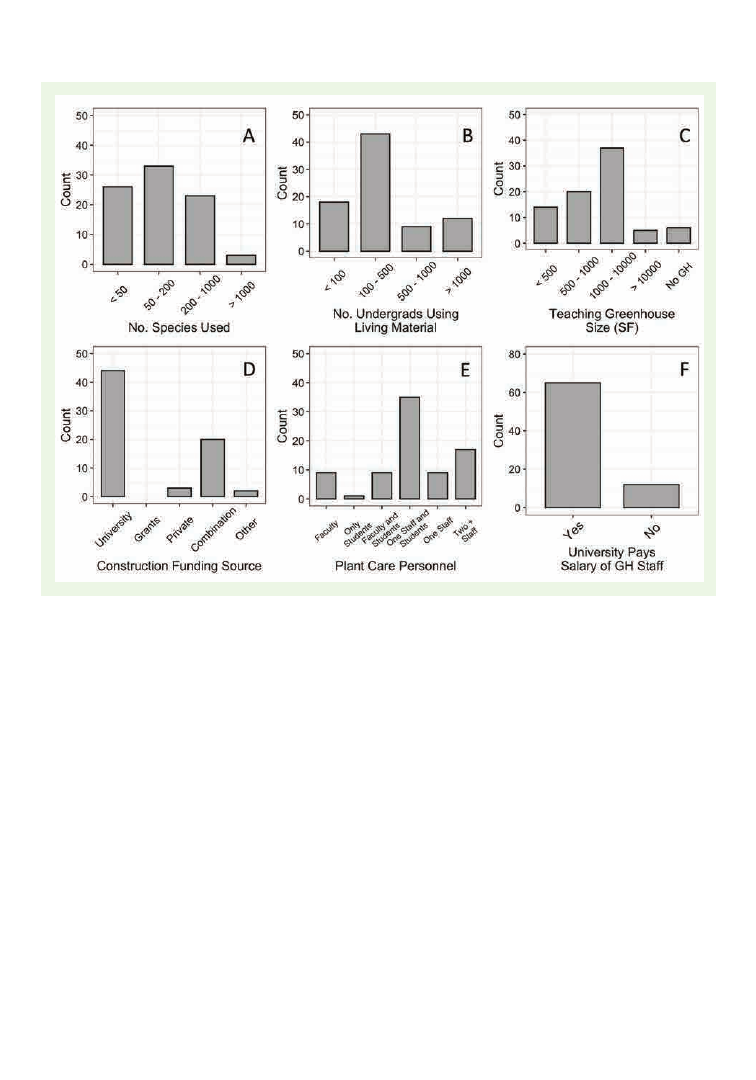
PSB 66 (3) 2020
180
Figure 7. Results from Survey of Greenhouse Use and Support. A, Numbers of plant species from
greenhouses and outdoor space used for teaching. B, Number of undergrads using living materi-
als. C, Size of greenhouses used for undergraduate teaching or research. D, Categories of funding
sources for greenhouse construction. E, Categories of plant care personnel. F, Source of salary for
plant care personnel.
combination of funding sources (Fig. 7D).
Most respondents indicated that greenhouses
are staffed by a paid staff member, as well as
students, and of those institutions with paid
staff, most are funded by the institution (Fig.
7E, F). This represents significant financial
investment in greenhouses that support
undergraduate teaching and research.
Perhaps the most interesting finding of the
study was that 61% of teaching and 48% of
research greenhouses are more than 20 years
old, with a significant proportion of those older
than 30 years (Fig. 8). Traditional greenhouses
have a life span of about 30 years, so if these
data are nationally representative, more than
50% of greenhouses used for teaching should
be replaced in the next 20 years. Given the
current cost of constructing greenhouses and
declining state support for public institutions
of higher learning, the current age of more
than half of the greenhouses used nationally
for teaching presents a serious threat to our
ability to continue to provide immersive
learning experiences in basic plant biology,
a threat I perceive as especially dire given
the critical role of plants in mediating Earth’s
response to climate change.
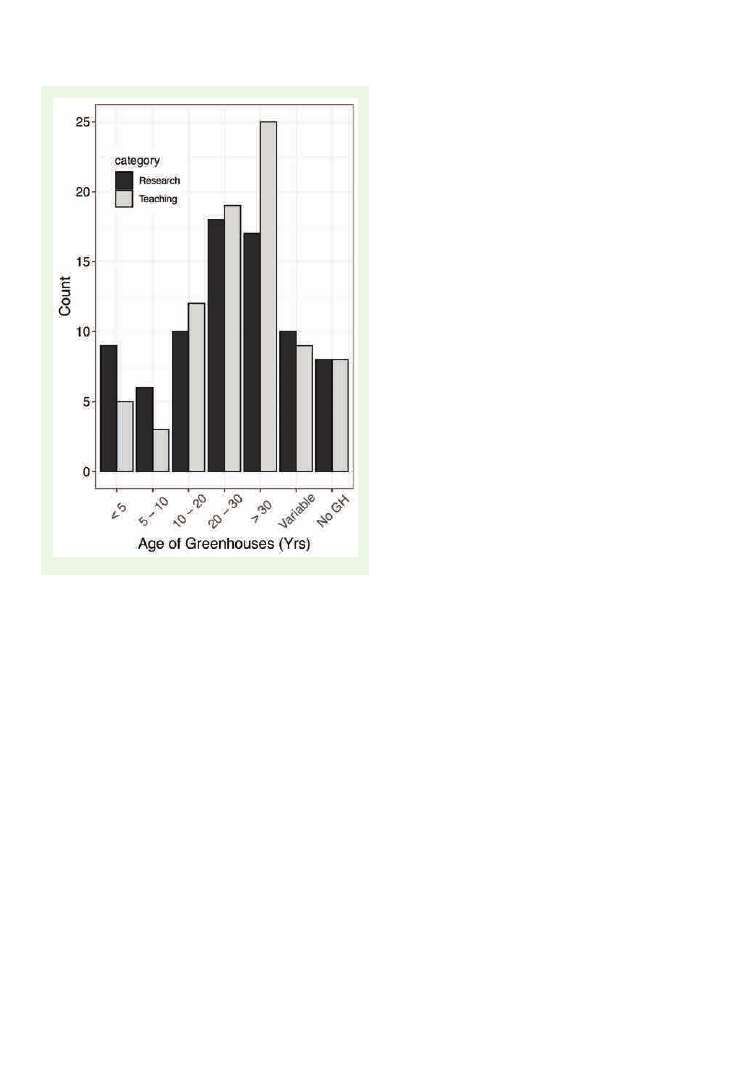
PSB 66 (3) 2020
181
Perhaps the single most important thing we can
do now is to recognize this looming threat and
form a collective voice. In addition to making
our federal agencies aware of this potential
national decline in our ability to provide high-
quality education in basic botanical education,
there are several possible actions those of us
currently facing greenhouse replacements
are familiar with: inviting governmental
representatives to view the greenhouses and
how they are used, educating administrations
on the critical role of plant biology relative to
sustainability and climate change, aligning
our greenhouses with the strategic plans of
the universities, and identifying opportunities
to involve the greenhouses in campus-wide
initiatives.
In addition to these approaches, we also can
and should emphasize to administrators the
important role of plants and greenhouses
as well as spending time in nature for the
mental health of students. Numerous studies
are showing that spending time in nature is
beneficial to health (Lai et al., 2019; Robbins,
2020). The idea that academic greenhouses
could contribute toward improving mental
health was first brought to my attention when
I learned of a program called NatureRx@</p>
Cornell. A group of Cornell faculty and
administrators recognized that today’s
college-age students experience stress,
depression, anxiety, and other mental health
issues at unprecedented levels. At the same
time, this group was aware of recent research
showing that there are many positive mental
and physical health outcomes associated with
spending time in nature. Relative to college-
aged students, time in nature reduces stress,
anxiety, depression, and aggressive feelings, as
well as leading to increased happiness and life
satisfaction and increased social connection,
especially if nature is experienced with a
friend. College students may be especially
interested in studies showing that spending
time in nature improves concentration,
recall, and immune function. NatureRx@</p>
Cornell is a program in which mental health
providers write prescriptions for students to
spend time in natural areas on or near campus
and is described in detail in a book by Dan
Rakow and Greg Eells, two of the founders of
NatureRx@Cornell (Rakow and Eells, 2019).
(For a list of steps to start a NatureRx program
at your institution, see Box 1.)
For general background on the history of
ideas and scientific literature demonstrating
the mental health benefits of spending time
in nature, I recommend The Nature Fix
(Williams, 2017). This well-researched book
Figure 8. Ages of greenhouses used for under-
graduate teaching and research (grey) and re-
search only (black).

PSB 66 (3) 2020
182
reviews the hypotheses behind why spending
time in nature makes us feel better, but to date,
the actual mechanisms remain unclear (Lai
et al., 2019). Two of the first researchers in
this field, Rachel and Stephen Kaplan (1989),
proposed, what is now known as Attention
Restoration Therapy. This hypothesis states
that prolonged use of directed attention, which
by definition is voluntary (e.g., many jobs,
academic study), causes mental fatigue and
stress. Even brief periods in the natural world
provide a level of involuntary fascination
that allows directed focus to rest and recover.
Ulrich et al. (1991) subsequently proposed the
Stress Reduction Theory, arguing that nature
lowers stress immediately, and lowering of
stress then allows recovery. Research from
BOX 1
Steps for starting a
NatureRx Program at your
institution
(from Rakow and Eells, 2017;
used with permission)
1. Organize a committed
group.
2. Secure the support of the
Administration.
3. Inventory green spaces on
campus.
4. Engage the students.
5. Partner with campus health
services.
6. Develop an app or website.
7. Impact the academic program.
8. Develop an approach to
evaluation.
9. Identify and overcome the
challenges.
10. Model the behavior.
Japan has shown that phytoncides, volatile
organic compounds produced by some plants
(e.g., pines, oaks, onions), reduce sympathetic
nerve activity, and therefore blood pressure,
and boost immune activity when taken in
through our nasal passages (Li et al., 2009).
Many psychologists also subscribe to the
idea of “Biophilia” originally proposed by
Eric Fromm and later reiterated in a slightly
different form by E. O. Wilson (1984), which
is the idea that humans have an “innate” (i.e.,
genetically predisposed) emotional affiliation
with other living organisms.
In addition to the simple fact that being
around plants is beneficial, and by extension
that being in a greenhouse is beneficial, there
is need for more research on the link between
botanical education and mental health effects.
We already know from decades of research
that educating children outdoors increases
academic performance in a range of areas.
What we do not know is how the mental
health benefits of being in nature interact
with the stress associated with memorizing a
fact. Are the positive effects of phytoncides
achieved if attention is directed, for example,
to learning a species name? Is it possible
that simply because our botany labs use
living materials, compared to labs based on
non-living material, our students are more
engaged, successful, happier, or creative?
This connection between mental health and
plants extends beyond the classroom. If there
is any silver lining in this horrible pandemic,
it is that people are turning to plants for
comfort! Seed companies sold out this year
(e.g., Pierre-Louis, 2020), gardening supply
stores are seeing high volumes, people are
sharing photos of their house plants, and local
parks have closed early in the day because
they are so crowded. How can we turn this
rekindled connection to plants into curiosity

PSB 66 (3) 2020
183
about them? Even during this pandemic, there
are many possibilities and we should share
ideas. We can volunteer to lead fall “flower
walks” for the public, or within universities
consider activities that link botany to mental
health and offer socially distanced tours of
the greenhouses or natural areas near campus
to small groups, or as instructors, conduct as
many labs outside as possible. A recent study
conducted at UC Santa Cruz (Beltran et al.,
2020) demonstrated that students from four
demographic categories (underrepresented
minority students, first-generation, students
from families with low income, and gender)
benefit from participation in field courses.
Over five years, this participation was linked to
higher gains in self-efficacy, higher retention
in ecology and evolutionary biology majors,
and higher rates of graduation as compared
to lecture-based courses. In other words,
students who choose these courses benefitted
significantly beyond the knowledge gained
from course content.
The main points of this essay can be
summarized by two quotes from Goethe,
both from Theory of Colours. In the preface to
the book, he wrote, “Every act of seeing leads
to consideration, consideration to reflection,
reflection to combination, and thus it may be
said that in every attentive look to nature, we
already theorize”
(p. xx).
To me, this quote
encapsulates the essence of teaching. The
second quote speaks to the second part of
this essay: “And thus as we descend the scale of
being, Nature speaks to other senses – to known,
misunderstood, and unknown senses: so speaks
she with herself and to us in a thousand modes”
(p. xviii). This year, more than a quarter of
members in the BSA are students. This is a
remarkable achievement and is essential for
the future of the Society. The Society is in good
shape and we have a very bright future. With
intention, we can change. We can become a
more diverse Society that supports botanical
endeavors from multiple perspectives.
LITERATURE CITED
Anderegg, W. R. L., A. G. Konings, A. T.
Trugman, K. Yu, D. R. Bowling, R. Gabbitas,
D. S. Karp, et al. 2018. Hydraulic diversity of
forests regulates ecosystem resilience during
drought. Nature 561: 538-541.
Beltran, R. S., E. Marnocha, A. Race, D. A.
Croll, G. H. Dayton, and E. S. Zavaleta. 2020.
Field courses narrow demographic achieve-
ment gaps in ecology and evolutionary biol-
ogy. Ecology and Evolution 10: 5184-5196.
Diggle, P. 2013. Learned societies - Past,
present and future? Plant Science Bulletin 59:
150-157.
Elliot, A. J., and M. A. Maier. 2014. Color
psychology: effects of perceiving color on
psychological functioning in humans. Annual
Review of Psychology 65: 95-120.
Goethe, J. W. v. 1810. Goethe’s Theory of
Colors: Translated from the German, with
Notes by Charles Lock Eastlake, R.A., F.R.S,
Retrieved 20 September 2020 via Internet ar-
chive. John Murray, London, England U.K.
Kaplan, R., and S. Kaplan. 1989. The Experi-
ence of Nature: A psychological perspective.
Cambridge University Press, New York, NY.
Lai, H., E. J. Flies, P. Weinstein, and A. Wood-
ward. 2019. The impact of green space and
biodiversity on health. Frontiers in Ecology
and the Environment 17: 383-390.

PSB 66 (3) 2020
184
Li, Q., Y. Wakayama, R. Inagaki, M. Katsu-
mata, Y. Hirata, T. Shimizu, T. Kawata, et al.
2009. Effect of phytoncide from trees on hu-
man natural killer cell function. International
Journal of Immunopathology and Pharma-
cology 22: 951-959.
Nilson, L. B. 2010. Teaching at its best: A re-
search-based resource for college instructors,
ed 3, pp. 3-15. Jossey-Bass, Wiley Imprint.
Pierre-Louis, K. 2020. Panic buying comes
for the seeds. The New York Times, New York,
New York, USA.
Rakow, D. A., and G. T. Eells. 2019. Na-
tureRx: Improving College-Student Mental
Health. Cornell University Press, Ithaca, New
York.
Robbins, J. 2020. Ecophychology: How im-
mersion in nature benefits your health, Ya-
leEnvironment360. Yale School of the Envi-
ronment, New Haven, CT.
Sundberg, M. D. 2004. Where is botany go-
ing? Plant Science Bulletin 50: 2-6.
Tilman, D., R. Isbell, and J. M. Cowles. 2014.
Biodiversity and ecosystem functioning. An-
nual Review of Ecology and Systematics 45:
471-493.
Ulrich, R. S., R. F. Simons, B. D. Losito, E.
Fiorito, M. A. Miles and M. Zelson. 1991.
Stress recovery during exposure to natural
and urban environments. Journal of Environ-
mental Psychology 11: 201-230.
Williams, F. 2017. The Nature Fix. W. W.
Norton & Company, New York, NY.
Wilson, E. O. 1984. Biophilia. Harvard Uni-
versity Press, Cambridge, MA.

PSB 66 (3) 2020
185
JOIN #TEAMBUCKWHEAT
By Naomi Fraga
Eriogonum tiehmii Reveal (Tiehm’s buckwheat,
Polygonaceae) is endemic to the Silver Peak
Range in Esmeralda County, Nevada, about
halfway between Reno and Las Vegas. This
species is at risk of extinction because its
entire global population is located within the
boundary of a proposed industrial lithium
and boron mine. If approved, the mine would
extirpate more than 60% of all the known
plants (~28,000 of 44,000 plants known)
and up to 30% of the total occupied habitat.
Further, in a devastating turn of events, it
was discovered in September 2020 that up
to 40% of the global population of E. tiehmii
was damaged or destroyed as the project
awaits environmental review. This newly
documented threat is currently undergoing
investigation, but illustrates the extreme
vulnerability of E. tiehmii.
As a part of the coordinated
effort to support conservation
of E. tiehmii, I along with
the Center for Biological
Diversity launched a plant
conservation campaign on
social media to urge the
botanical community to
“join #Teambuckwheat to
save Tiehm’s buckwheat.”
In July 2020, over 80
#TeamBuckwheat supporters
showed up to the 3.5-hour
workshop, and over 100
The joint BSA Public Policy and ASPT
Environmental and Public Policy Committees
strive to connect membership to relevant
public policy resources, actions and activities.
Join the BSA Slack #public_policy channel
to learn about late-breaking public policy
issues and ways that you can get involved to
advocate for plants and science! Get started
at https://botany.org/home/membership/
bsa-slack.html.
In this issue, we showcase the work of a
member involved in a local policy topic that
may be of interest to many within the societies.
Dr. Naomi Fraga’s work also provides an
excellent example of the ways in which the
scientific community can affect meaningful
change for biodiversity conservation.
Advocate for Botany and Science!
By BSA PPC Co-Chairs Krissa Skogen (Chicago Botanic
Garden) and Tanisha Williams (Bucknell University) and
ASPT PPC Chair Naomi Fraga (California Botanic Garden)
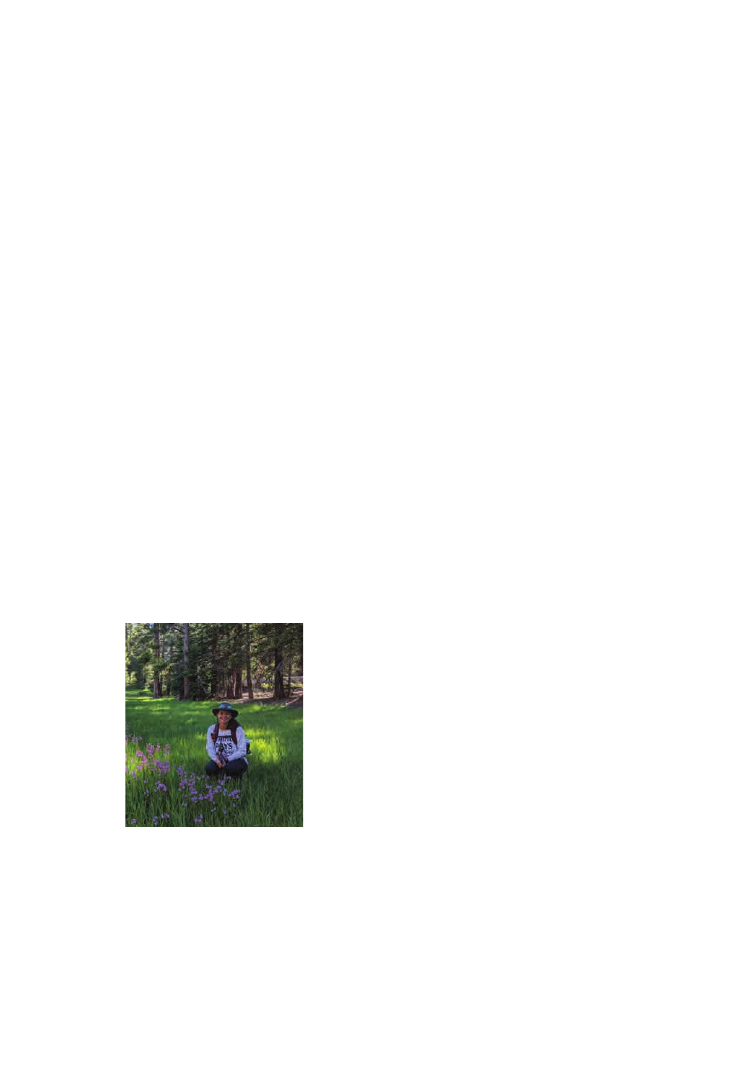
PSB 66 (3) 2020
186
scientists signed a letter advocating for
the addition of Tiehm’s buckwheat to the
Nevada list of endangered flora. We now
have the opportunity to broaden our network
and leverage support from the botanical
community via the BSA Slack #public_policy
channel. If you’d like to learn more about
conservation efforts such as this, please
join our network. We will share current
information related to conservation issues,
and especially those that will benefit from a
call to action.
ASSESSING GRAZING
IMPACTS ON REMOTE
MONTANE MEADOWS IN
THE SOUTHERN SIERRA
NEVADA, TULARE COUNTY,
CALIFORNIA
By Nina House
I am a Master’s student in Botany at the
California Botanic Garden and Claremont
Graduate University, currently undertaking
a floristic study of the Manter and Salmon
Creek watersheds in the southern Sierra
Nevada, Tulare County, CA. The primary
goal of my study is to conduct a systematic
inventory of the vascular plant diversity of
the region, but I am also collecting data on
disturbances and threats to plant diversity.
One notable disturbance in the study area
is cattle grazing in montane meadows. I am
interested in studying and communicating the
impacts of cattle grazing, since my research
interests extend to plant conservation, land
management, and disturbance regimes. My
hope is that this project will provide tangible
data that can help improve management
practices.
Montane meadows are an incredibly
species-rich ecosystem (Jones et al., 2019).
Although they make up only 10% of the
land area within the Sierra Nevada, they
are an essential component for the health of
wildlife and humans (Ratliff, 1985). Montane
meadows play a critical role in water storage
and cleanliness, acting as the kidneys of a
watershed as they filter out sediments and
debris from water flowing downhill (Blank
et al., 1995). Additionally, 50% of California’s
domestic water comes from Sierra Nevada
watersheds, demonstrating the distinct role
that meadows play in water quality for millions
of people across the state
(McIlroy and Allen-
Diaz, 2012). However, w
hen not managed
sustainably, grazing by cattle can lead to altered
species composition, trampled soil and plants,
altered hydrology, and the spread of non-
native species (McIlroy and Allen-Diaz, 2012).
Further, when combined with other threats
and disturbances within the region, including
altered fire regimes, drought, climate change,
and increasing recreation, these vital habitats
may be significantly altered.
It is often difficult to assess the exact
consequences of grazing, since impacts can
vary depending on the timing, duration, and
intensity of use (McIlroy and Allen-Diaz,
2012). Knowing the types of data to collect
and who to approach with concerns can make
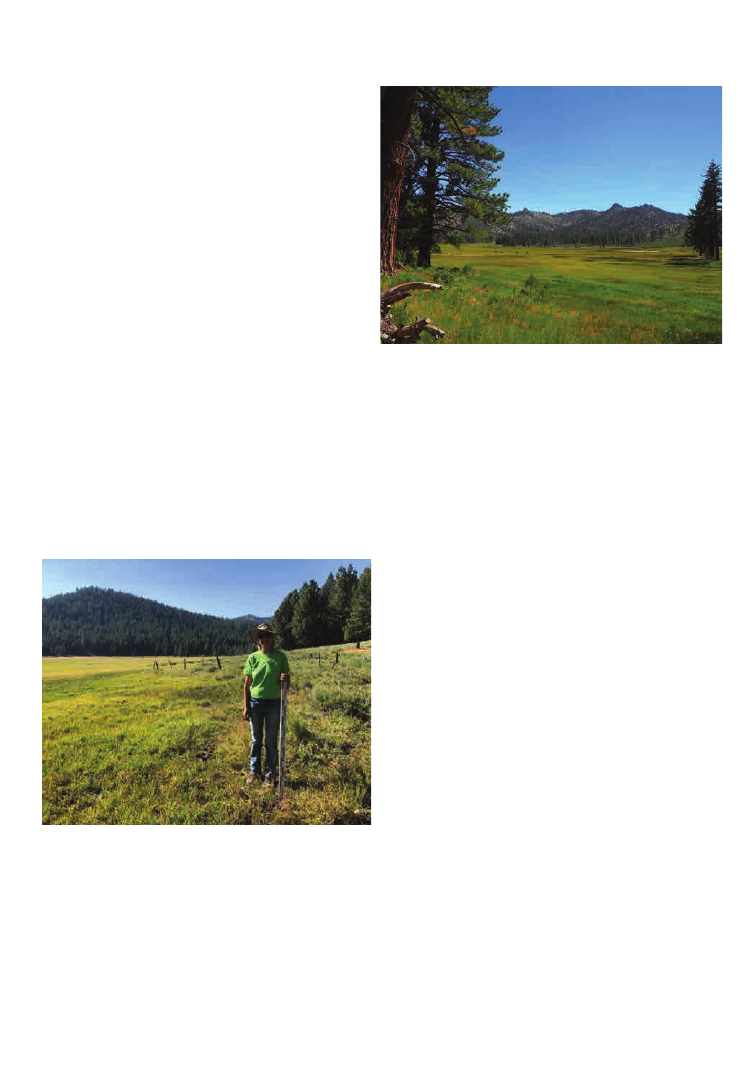
PSB 66 (3) 2020
187
all the difference in improving management
of grazing in montane meadows. Laura
Cunningham, California Director of the
Western Watershed Project, has been working
to document the impacts of cattle grazing in
montane meadow systems in the southern
Sierra Nevada (Figure 1). Through the help
of the Botanical Advocacy and Leadership
Grant, funded jointly by both the Botanical
Society of America and the American Society
of Plant Taxonomists, I have had the privilege
of inviting Laura to my study site so I can
learn more about how to document these
disturbances in a way that can inform future
forest management.
During one trip in July 2020, Laura and I
visited three montane meadows located within
my study site. Manter Meadow occurs within
the Domeland Wilderness and represents
a relatively undisturbed montane meadow
that has seen little in the way of recent cattle
grazing (Figure 2). We also visited two
meadows outside of designated wilderness,
Big Meadow and Horse Meadow, that reside
in active grazing allotments (Figure 3). Laura
demonstrated how to document a variety of
meadow health indicators, including: stream
bank height, stability, water color, sediment
deposition in streams, trampling, presence
of tufted hair grass (Deschampsia cespitosa,
Poaceae), percentage of bare ground,
vegetation height, and location of fencing.
Our initial observations indicated that there
is a difference in the ecosystem health of the
heavily grazed vs. minimally grazed meadows
in my study site. In Manter Meadow, stream
banks were high and were stabilized by
tall vegetation. We observed clear water
along streams and small rocks that were
unburied by sediment. These kinds of habitat
characteristics provide trout with a secure
place to lay their eggs. There was little bare
ground, and D. cespitosa, an indicator species
for meadow health, was seen throughout the
meadow. In contrast, Big Meadow and Horse
Meadow displayed several impacts from
grazing, including trampled and collapsing
Figure 1. Laura Cunningham, California Di-
rector of Western Watershed Project, and I
worked together to document grazing impacts
in three meadows in my study site. Here she can
be seen measuring the height of vegetation in
the heavily grazed Big Meadow.
Figure 2. Many montane meadows through-
out the Sierra Nevada, such as Big Meadow
(pictured), see active cattle grazing from June
through September each year.
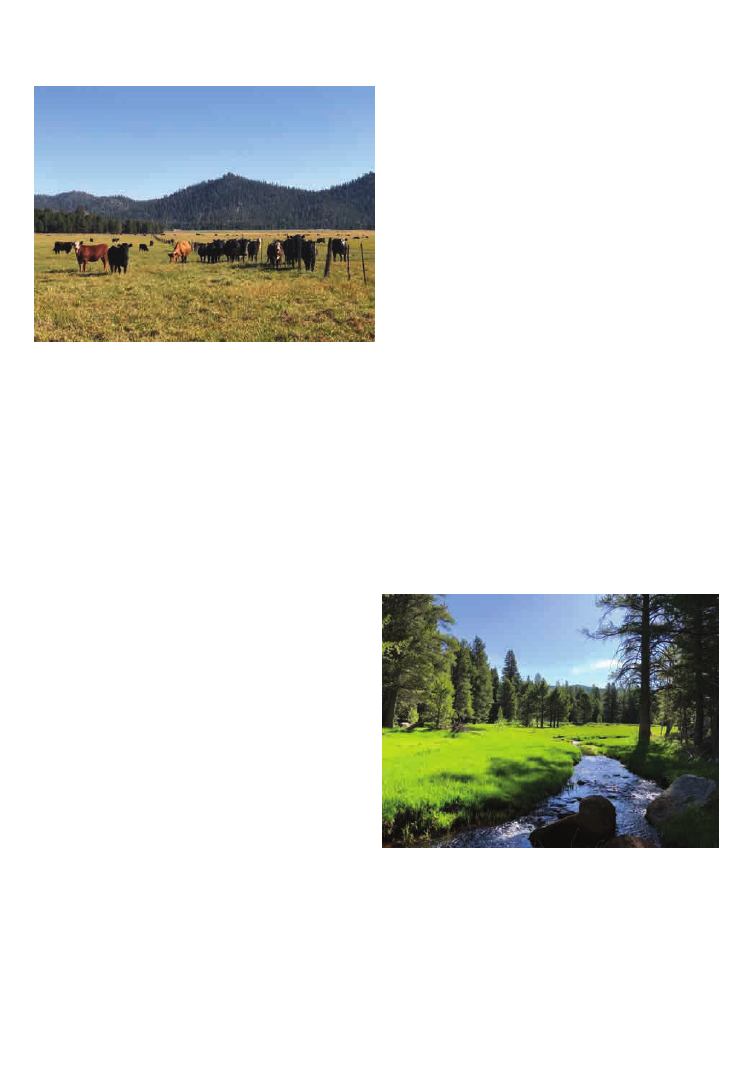
PSB 66 (3) 2020
188
springs and stream banks, brown water, and a
deep sediment layer. These characteristics are
known to negatively impact populations of
fish and aquatic invertebrate that make their
homes in and downstream from montane
meadows (Herbst et al., 2012). Deschampsia
cespitosa, while present, was often absent of
reproductive features due to being grazed by
cattle. Finally, large patches of bare ground
were present in both grazed meadows, and
in Horse Meadow the bare patches were
particularly sizable.
Laura and I are now collaborating on a report
to the Sequoia National Forest that will include
our observations and recommendations for
grazing management. These recommendations
include additional fencing around springs
and streams in both Big Meadow and Horse
Meadow to enhance water quality and prevent
the collapse of stream banks. Additionally,
in Horse Meadow, we recommend reducing
cattle density and, in both Big and Horse
Meadows, periodic off-years would allow for
the rejuvenation of meadow vegetation. In
addition to our report, we also hope to interact
directly with forest service staff to discuss our
findings and suggestions.
I would like to thank the American Society of
Plant Taxonomists and the Botanical Society
of America for providing the Botanical
Advocacy Leadership Award. Through this
award I will be able to provide scientific
information that may lead to management
changes in important ecosystems. With the
reports and publications that result from
this work, I hope I can inform future policy.
I would also like to thank my Master’s thesis
advisor, Dr. Naomi Fraga, who has assisted
with the synthesis and implementation of this
project. I am grateful to Laura Cunningham
for taking the time to work with me and share
her knowledge of meadow management.
Her work evaluating grazing impacts on
meadow health is timely and much needed!
Finally, I would like to thank the California
Figure 3. Manter Meadow represents a mon-
tane meadow that has seen little in the way of
recent grazing.
Figure 4. The Salmon Creek (pictured) is cur-
rently under review for designation as a Wild
and Scenic River. Running through both Horse
Meadow (pictured) and Big Meadow, it receives
heavy impacts from grazing, as can be seen here
in the way of collapsing banks.

PSB 66 (3) 2020
189
Botanic Garden for their continued financial,
educational, and moral support as I work to
complete my floristic inventory of the Manter
and Salmon Creek watersheds (Figure 4). My
hope is that through greater knowledge of our
flora and the impacts of cattle grazing, we will
spark change in forest management and work
to conserve and protect montane meadows
throughout the Sierra Nevada mountain
range.
LITERATURE CITED
Blank, R. R., T. J. Svejcar, and G. M. Riegel.
1995. Soil genesis and morphology of a mon-
tane meadow in the northern Sierra Nevada
range. Soil Science 160: 136-152.
Herbst, D. B., M. T. Bogan, S. K. Roll, and
H. D. Safford. 2012. Effects of livestock ex-
clusion on in-stream habitat and benthic in-
vertebrate assemblages in montane streams:
Stream recovery and livestock grazing exclu-
sion. Freshwater Biology 57: 204–217.
Jones, J. A., R. Hutchinson, A. Moldenke, V.
Pfeiffer, E. Helderop, E. Thomas, J. Griffin,
and A. Reinholtz 2019. Landscape patterns
and diversity of meadow plants and flower-
visitors in a mountain landscape. Landscape
Ecology 18.
McIlroy, S. K., and B. H. Allen-Diaz. 2012.
Plant community distribution along water
table and grazing gradients in montane mead-
ows of the Sierra Nevada Range (California,
USA). Wetlands Ecology and Management
20: 287–296.
Ratliff, R. D. 1985. Meadows in the Sierra Ne-
vada of California: State of knowledge (No.
PSW-GTR-84; p. PSW-GTR-84). https://doi.
org/10.2737/PSW-GTR-84.
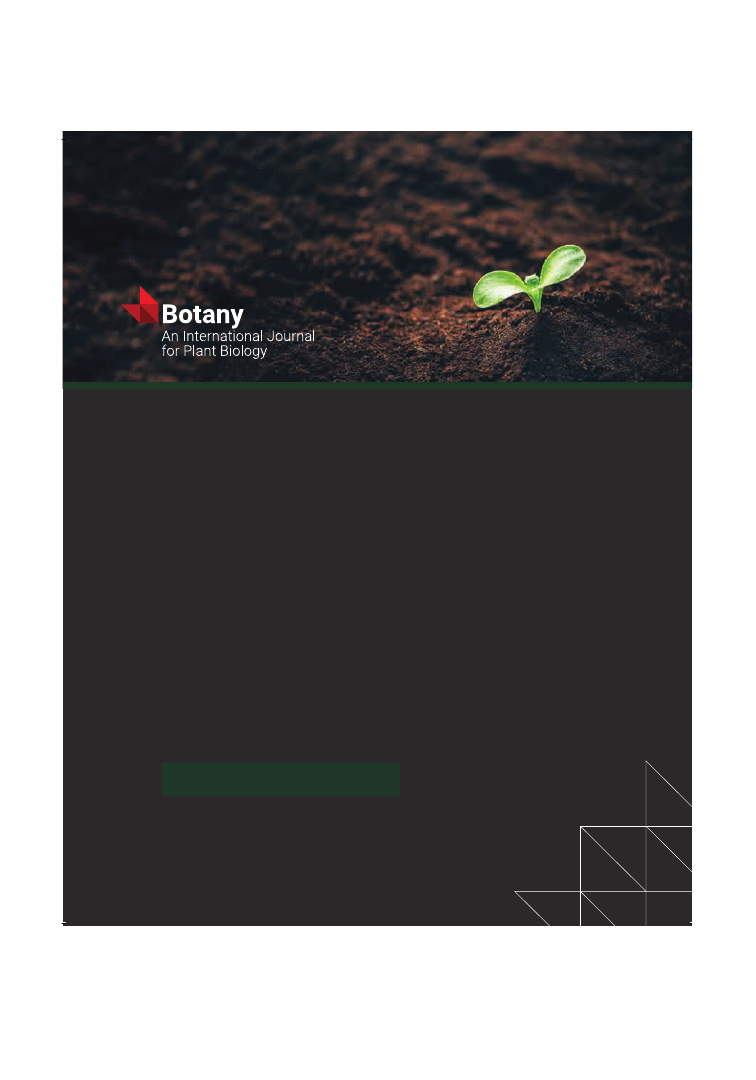
PSB 66 (3) 2020
190
Because your research
breaks new ground
Published since 1929, Botany is a peer-reviewed journal
featuring comprehensive research on all facets of plant
biology including biochemistry, physiology, phenology, ecology,
phytogeography, and systematics. Recently, the Editorial Board
revised the scope of the journal to include Methods papers,
Plant Genomic Resources, and manuscripts written by (with or
for) Indigenous Traditional Knowledge keepers.
Publish with Botany
cdnsciencepub.com/cjb

191
SPECIAL FEATURES
By Beth Ginondidoy Leonard
Research Professor of
Indigenous Studies
Institute of Culture
and Environment
Alaska Pacific University
Diversity and Inclusion in the
Sciences: Relationships and
Reciprocity
I
was honored to present during the Botany
2020 session “Enhancing scientist diversity
in plant biology.” I am Deg Xit’an (Dene’/
Athabascan), a member of the Shageluk
Tribe of interior Alaska, and research
professor of Indigenous Studies at Alaska
Pacific University. Alaska Pacific University
(APU) is a small private institution located in
Anchorage, Alaska and is currently pursuing
tribal university status. I recently transferred
from the University of Alaska Anchorage,
where I served as professor of Alaska Native
Studies from 2016 to 2020 to APU. APU’s
board of trustees recently appointed a Yup’ik
woman—Valerie Davidson,
1
an attorney/
health fields scholar—as president, a first for
that institution.
My academic background includes linguistics,
education, and cross-cultural and Alaska
Native/Indigenous studies. In terms of the
natural sciences, my undergraduate courses
were limited to “natural history of Alaska” and
“human osteology.” However, as a member of
the Deg Xit’an (Dene’/Athabascan) nation, my
personal experiences include place- and land-
based education, since Alaska Native peoples
have thousands of years of knowledge[s]
around place and land. As my thinking around
science progressed, I began to think of Alaska
Native and Indigenous ways of knowing
as science(s), rather than “just” ways of
knowing. This essay focuses on Alaska Native
and Indigenous perspectives, although the
processes of diversity and inclusion obviously
need to be engaged more broadly.
THE ALASKAN CONTEXT
AND PERSONAL HISTORY
Research on Alaska Natives is often combined
with American Indians, and researchers tend
to gloss over the unique and diverse contexts
of Alaska Native nations (Figure 1). For
example, Alaska Natives make up almost 20%
of Alaska’s population,
2
there are at least eight
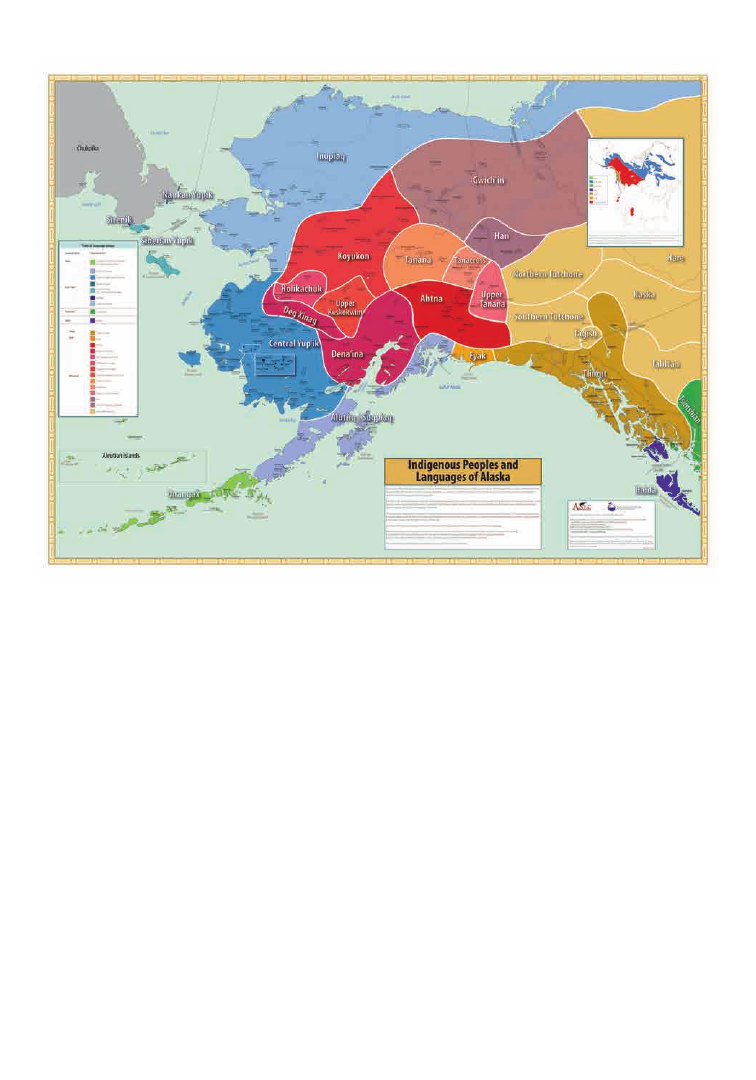
PSB 66 (3) 2020
192
Figure 1. Indigenous peoples and languages of Alaska map. (From Krauss, M., G. Holton, J. Kerr,
and C. T. West. 2011. Indigenous Peoples and Languages of Alaska. Fairbanks and Anchorage:
Alaska Native Language Center and UAA Institute of Social and Economic Research. Website:
https://www.uaf.edu/anla/map.)
distinct cultural groups, 229 federally recognized
tribes, 20 official Indigenous languages,
3
12 Alaska Native Claims Settlement Act
(ANCSA) regional corporations,
4
and over 200
ANCSA village corporations. Alaska Native
students are 24% of the K-12 population, a
significant percentage when considering the
diversification of STEM fields. Native peoples
have thousands of years of knowledges/
sciences and relationships with specific lands
or regions around Alaska, and archaeological
evidence suggests that Athabascan peoples
have been living in interior Alaska for at least
12,000 years.
Deg Xinag (literally, “language from around
here”) is the westernmost Dene’/Athabascan
language, a region that stretches from Holy
Cross, Alaska to Hudson Bay in Canada. I
grew up in the Deg Xit’an (“people/beings
from around here”) communities of Shageluk
and Anvik in the 1960s and 1970s and
because of socio-historical circumstances did
not learn my heritage language. As a second
language learner of Deg Xinag, however—a
process that began in my early 30s—I found
that the language provided a doorway into the
scientific worldview of the Deg Xit’an peoples
whose terms for plants reflect complex
relationships between and among humans

PSB 66 (3) 2020
193
and non-humans. Place names may also
reflect the “beings” of an area; for example, my
father grew up in Didlang Tochagg, or Spruce
Slough. The spruce tree, or didlang, was/is one
of the most useful plants to the Deg Xit’an
people, providing, for example, medicine
in the form of new shoots in the spring that
could be collected and made into tea to treat
colds; pitch, which was used for bandaging
cuts and waterproofing canoes; and wood for
burning, or the construction of items such as
sled runners or household items. Although
the term didlang does not have a known literal
meaning, its relationship with the people of
my area reflects Potawatomi scholar Robin
Wall Kimmerer’s observations: “In some
Native languages the term for plants translates
to ‘those who take care of us’” (Kimmerer,
2013, p. 278). Spruce also burns at a higher
temperature than other woods and is softer
than birch, making it easier to work with. In
terms of “plants-based” knowledge, the people
of my area and other areas of Alaska maintain
a reciprocal “gift” relationship with plant
beings:
“…in the gift economy, the gifts are
not free. The essence of the gift is that
it creates a set of relationships. The
currency of the gift economy is, at its
root, reciprocity…in a gift economy
property has a ‘bundle of responsibilities’
attached.” (Kimmerer, 2013, p. 28)
Indigenous peoples, before gathering plants
or berries, for example, may often sing a
song, or offer a prayer or gifts. Considering
the current research on plants that suggests
that the plant can alter its chemical structure
when responding to a threat, I have often
wondered if the songs or prayers or gifts
also cause the plant to alter its chemistry
to be perhaps more beneficial to humans
when consumed as medicine and/or food.
In her discussion of Indigenous knowledges,
Mi’kmaq scholar Marie Battiste (2002)
references the significance of protocols and
time in ceremonial practices: “Indigenous
knowledge is also inherently tied to land, not
to land in general but to particular landscapes,
landforms, and biomes where ceremonies
are properly held, stories properly recited,
medicines properly gathered, and transfers of
knowledge properly authenticated” (p. 13).
Bang et al. (2018) also respond to Western
science’s beliefs around the sentience and
agency, and how this has constrained scientific
inquiry:
“…from a Western perspective, plants
have little agency. This logic has arguably
held back emerging research on plant
abilities and intelligence, as Western
scientists now understand that some
plants can recognize and selectively
favor kin and that many plants can signal
the presence of threats.”
For many Alaska Native and Indigenous
peoples, the Western hierarchy of humans as
the pinnacle of intelligence and achievement
is a foreign concept because the often-superior
sensory abilities of non-humans such as plants
and animals are recognized and celebrated.
For example, in his discussion of Yupiaq
realms of being, Oscar Kawagley’s (1998, p.
4) tetrahedral metaphor places the human
and natural realms on the same level. Other
Indigenous scholars such as Tewa scholar
Gregory Cajete (2016) highlight the abilities
of plants and animals to “educate” humans on
different topics such as appropriate medicines,
etc. Peter John, a late Dene’/Athabascan chief
from Minto, Alaska, also emphasized the
importance of close relationships with the

PSB 66 (3) 2020
194
Deg Xinag
English
Literal translation
-tsiy
Grandfather
Yixgitsiy
Raven
you guys/your (pl.) grandfather
Yixgitsiy Vozra’
Rusty Blackbird
Raven’s nephew
Yixgitsiy Nołchidl
Puffball Mushroom
Raven’s (sewing) bag
natural world: “If you look deeply enough,
you’ll see that animals can help us understand
life as it is…animals understand you, but only
if you know how to talk with them” (Krupa,
1996, p. 25).
INDIGENOUS EDUCATION:
WAYS OF KNOWING,
BEING, AND DOING
“There is a shared body of understanding
among many Indigenous people that
education is really about helping an
individual find his or her face, which
means finding out who you are, where
you came from, and your unique
character…Indigenous education
is, in its truest form, about learning
relationships in context.“ (Cajete, 2000,
p. 183)
Gregory Cajete offers both critique and
solutions for education, including the
concept of “learning relationships in context.”
Relationships and reciprocities are key to
Indigenous engagement with human and
non-human worlds, and in many areas of
the world Indigenous “ways of knowing,
being, and doing” have been maintained for
thousands of years. As I began my language-
learning journey, I also began to understand
these relationships through examining literal
translations of kinship, bird, and plant terms.
For example, the term for “grandfather” is
also closely related to the term for “raven.”
“blackbird,” and “puffball mushroom,”
although this is not obvious through the
separation of these terms under “kinship,”
“birds,” and “plants” in the organization of
topically based noun dictionaries (see chart
below).
The Deg Xit’an organization of these
“beings” through the Deg Xinag language
conceptualizes a world of relationships and
reciprocities among human and non-human
realms—a world very different than the
separated disciplinary world(s) presented to
Indigenous students in academia. For the Deg
Xit’an people, the entity Raven (sometimes
referred to as “Crow”) is significant as
cosmological narratives document how he
brought light and helped create different
aspects of their environment. Raven’s
relationship with the puffball mushroom
is likely further explained through stories;
however, some of this information may have
been lost with the passing of Elder storytellers.
“Educate comes from Latin educare...
which is derived from a specialized use
of Latin educere...meaning ‘to assist at
the birth of a child’. This old meaning of
the English word ‘educate’ is similar to
our own Inupiat Eskimo word...which
literally means ‘to cause to become a
person’.” (Okakok, 1989, p. 413)
For Alaska Native and other Indigenous
peoples, goals of education might include
Okakok’s Inupiat translation “to cause

PSB 66 (3) 2020
195
to become a person” and a Yup’ik goal of
nourishing “a right mind to think with”
(Barker, 1996). Part of “becoming a person/
human being” includes understanding
relationships and reciprocities between and
among human and non-human worlds. Similar
concepts from the Deg Xinag language include
the terms dinayetr (literally, “our breath/way
of life, our belief system”) that recognizes
the responsibilities of humans to the natural
world in maintaining life and balance as well
as getiy xiyo t’anh (literally “s/he has a good
mind/is able to plan ahead”).
DIVERSITY IN THE
SCIENCES: OPPORTUNITIES
IN HIGHER EDUCATION
Garcia and Shirley (2012) frame education as
a “sacred learning landscape,” emphasizing the
roles of institutions and teachers in nurturing
critical consciousness and “origins of place”
(pp. 77-78). Higher education institutions have
numerous opportunities to offer authentic
and interesting experiences for Indigenous
students. In my experience, higher education
offered a number of learning experiences and
opportunities that were absent or erased in the
K-12 system. For example, this was my first
opportunity in a classroom setting to engage
with my heritage language; a place where Deg
Xinag was seen as interesting and important,
rather than “primitive” and irrelevant in global
contexts. It was also my first opportunity
in a classroom setting to engage in any
substantive way (beyond material culture)
with my culture, other Alaska Native cultures,
and authentic Alaska Native and Alaskan
histories. Granted, institutions did and still
do fixate on the “under-prepared” Alaska
Native student or student-of-color, and often
question the abilities of these students to finish
programs and attain degrees. Institutions
might consider re-orienting themselves in
terms of “preparedness,” i.e. universities are
often “underprepared” to serve Indigenous
students or students-of-color, and instead
focus on educational pathways that utilize
“funds of knowledge” (Gonzalez et al., 2005),
decolonizing (Battiste, 2013), Indigenous
and/or other educational methodologies
that would enhance diversity and capacity-
building in STEM fields.
Another key challenge within academic
institutions is the creation and expansion of
both physical and intellectual landscapes for
Indigenous students and students-of-color.
These students often encounter barriers
as they seek to maintain their personal
identities while expanding their knowledge
in disciplinary fields. Institutions also suffer
from a lack of Indigenous faculty and faculty-
of-color. For example, Alaska Native students
make up a significant percentage of students in
the University of Alaska system (10%–20%),
yet Alaska Native faculty numbers have never
exceeded 5% (and are now closer to 3%),
highlighting a significant parity issue. And
there are very few, if any, Alaska Native faculty
who teach and research in STEM fields in the
University of Alaska system. Recently, the only
two Alaska Native biology faculty teaching
in the University of Alaska system relocated
to universities in the eastern U.S. With
relationships and reciprocity being key Alaska
Native values and factors in student success,
recruiting and retaining Indigenous faculty
are significant challenges that can hinder
that diversity and inclusion in the sciences—
especially when considering recruitment of
Alaska Native students into higher education.
Indigenous higher education research
indicates that formation of relationships
(mentoring/networks) is necessary for

PSB 66 (3) 2020
196
Indigenous student success (Pihama et al.,
2019); for many Indigenous scholars, these
relationships are more akin to a godmother/
father relationship than a “traditional”
academic mentor relationship (Leonard et al.,
2020). Mentoring in an Indigenous way often
goes well beyond preparation for academic
writing, research, and “getting students
through” their programs, to assisting with
job searches, co-authoring publications and
conference presentations, and continuing the
relationship throughout the student’s/faculty’s
career.
CONCLUSIONS
With current advances in science that seem
to converge or negotiate parallel paths with
Indigenous knowledges/sciences, and the
number of groundbreaking publications
by Indigenous scholars and scientists, one
might ask, “Who wouldn’t want to pursue
a STEM field?” If used in science programs,
Braiding sweetgrass: Indigenous wisdom,
scientific knowledge, and the teachings of
plants (Kimmerer, 2013), Who’s asking? Native
science, Western science and science education
(Medin and Bang, 2013), Native science:
Natural laws of interdependence (Cajete,
2016), and Blackfoot physics: A journey into the
Native American universe (Peat, 2002) provide
valuable new perspectives into the natural
realms; these new perspectives and theories
by established scholars are currently absent in
STEM curricula. If science curricula could be
renegotiated to explore its own philosophical
ideologies and “other” ways of knowing,
this approach could advance recruitment
and retention of underrepresented students,
but also “advance” scientific thought and
knowledge in significant ways. Institutional
changes are also necessary to recruit and retain
Indigenous faculty and faculty-of-color to
address parity issues. Reframing relationships
in higher education and acknowledgement
and action around reciprocities would
extend possibilities for Indigenous students
and students-of-color and might advance
academia in unexpected and refreshing ways.
FOOTNOTES
1
https://www.alaskapacific.edu/valerie-
nurraraaluk-davidson-named-alaska-pacific-
university-president/
2
https://firstalaskans.org/census-information-
center/overview/
3
https://uaf.edu/anlc/languages.php
4
https://ancsaregional.com/about-ancsa/
LITERATURE CITED
Bang, M., A. Marin and D. Medin. 2018. If
Indigenous peoples stand with the sciences,
will scientists stand with us? Daedalus 147:
148-159.
Barker, R. 1996. A right mind to think with: A
Yup’ik theory of human development. Unpub-
lished M.Ed. Project, University of Alaska
Fairbanks, Fairbanks.
Battiste, M. 2013. Decolonizing education:
Nourishing the learning spirit. Saskatoon,
SK: Purich Publishing.
Battiste, M. 2002. Indigenous Knowledge and
pedagogy in First Nations education: A litera-
ture review with recommendations. Prepared
for the National Working Group on Education
and the Minister of Indian Affairs. Indian and
Northern Affairs Canada, Ottawa, Ontario.

PSB 66 (3) 2020
197
Cajete, G. 2016. Native science: Natural laws
of interdependence. Sante Fe, NM: Clear
Light Publishers.
Cajete, G. 2000. Indigenous knowledge: The
pueblo metaphor of indigenous education. In
M. Battiste (Ed.), Reclaiming indigenous voice
and vision (pp. 181-191). Vancouver, BC: UBC
Press.
Garcia, J. and V. Shirley. 2012. Performing
decolonization: Lessons learned from Indige-
nous youth, teachers and leaders’ engagement
with critical Indigenous pedagogy. Journal of
Curriculum Theorizing 28: 76-91.
Gonzalez, N., L. Moll, and C. Amanti. 2005.
Funds of knowledge: Theorizing practices
in households, communities and classrooms.
Mahwah, NJ: Lawrence Erlbaum Associates.
Kawagley, A. O. 1998. An alliance between
humans and creatures. Sharing our Pathways
5: 4-5. Fairbanks: Alaska Native Knowledge
Network. Retrieved from https://uaf.edu/
ankn/publications/collective-works-of-angay/
An-Alliance-Between-1819DE.pdf.
Kimmerer, R. W. 2013. Braiding sweetgrass:
Indigenous wisdom, scientific knowledge, and
the teachings of plants. Minneapolis, MN:
Milkweed Editions.
Krupa, D. (Ed.) 1996. The gospel according to
Peter John. Fairbanks: Alaska Native Knowl-
edge Network.
Leonard, B., S. Nicholas, O. Skinner, and
G. Tsinajine. 2020. Innovations in Indige-
nous scholar mentorship: Relationships and
responsibilities. 2020 International Indig-
enous Research Conference, Ngā Pae o te
Māramatanga.
Medin, D. L. and M. Bang. 2014. Who’s ask-
ing? Native science, Western science and sci-
ence education. Boston, MA: MIT Press.
Okakok, L. 1989. Serving the purpose of edu-
cation. Harvard Educational Review 59: 405-
422.
Peat, F. D. 2002. Blackfoot physics: A jour-
ney into the Native American universe. Grand
Rapids, MI: Phanes Press.
Pihama, L., J. Lee-Morgan, L. T. Smith, S. J.
Tiakiwai, and J. Seed-Pihama. 2019. MAI Te
Kupenga: Supporting Māori and Indigenous
doctoral scholars within higher education.
AlterNative 15: 52-61.

PSB 66 (3) 2020
198
D
isasters wreak havoc on communities no
so much through their inherent destructive
powers, but by their ability to expose existing
fissures in poorly constructed systems. Two
unique disasters upended normal academic
social functioning in the Spring of 2020 in very
different but also connected ways. COVID-19
arrived to the shores of a skeptical United States,
and quickly ground all operations requiring
physical proximity, including institutions of
higher education, to an abrupt halt. The chaos
that ensued saw pedagogical models carefully
crafted for the physical classroom struggling
to adapt itself for remote learning. Though
the virus itself can infect most people, even
asymptomatically, its requirement for close
contact for spreading meant that prevention
required physical distancing. This simple
reality allowed the virus to sort the population,
By Dr. Bryan Dewsbury
Assistant Professor,
Department of Biology-
University of Rhode Island,
Kingston, RI
What Have We Learned?
Lessons and Strategies
from the Chaos
each according to their privilege. Workers in
the retail and service industries as well as the
gig economy soldiered on, unable to “work
remotely” or give up employment critical for
keeping themselves economically solvent.
In so doing, these workers continued to risk
exposure to themselves and their families
while those with means were safely ensconced
behind closed doors and online meetings.
Similarly, as faculty, staff, and students
migrated to the online classroom, the ability
to transition seamlessly depended on several
factors that varied according to means. Many
students returned to homes with internet that
was either nonexistent or of inferior quality to
that which existed on campuses. This, along
with changes in the availability of ideal study
environments, meant that the quality of the
home environment (in turn impacted by
economics) strongly predicted the ability of
the student to continue to fully engage in the
course. In many cases, students did not have
the option to return home at all.
In the midst of the pandemic, hundreds
of thousands of protesters spurred by yet
another senseless Black death, braved
quarantine protocols to bring attention to
the deaths of more Black lives at the hands
of law enforcement. This was not the first
time that activists have shone a light on the
Dr. Dewsbury was the Plenary Speaker at Botany 2020 and his talk examined what the social re-
ality of inequity has taught us, and more importantly, how we can and must position ourselves to
be agents of change.
A CHAOTIC SPRING

PSB 66 (3) 2020
199
physical danger Black lives face in the United
States, but on this occasion, the Black Lives
Matter movement’s message garnered much
more widespread support (Dave et al., 2020).
Activists and other academic advocates within
the higher education space embraced this
time with mixed emotions. On one hand, it is
frustrating that much of the systemic changes
suggested in response have been discussed
and fully articulated by its proponents for
decades, and that it took the cessation of many
Black lives in public and graphic fashion in
order for these proposals to be finally seriously
discussed. On the other hand, the momentum
that has been generated by the latest protests
have brought a more diverse and expansive
community to the table in favor of working
towards more concrete equitable solutions.
If there is to be a message of hope from the
darkness, institutions of higher education
must position ourselves to look critically at
this chaotic time and learn crucial lessons.
In this process we might recognize that the
chaos highlighted an existing system that was
broken, particularly for those who depended
on it the most. If we are to return to something
different and improved, we must have a clear
plan to address our historic shortcomings. I
offer here a four-step process, undergirded
by the paradigm of inclusive practices, as a
mechanism for our community to collectively
move forward. These are (1) having a clear
vision, (2) being prepared to learn, (3)
identifying a specific achievable strategy,
and (4) having a mechanism to assess
the impact of your efforts. My hope is
that although the events of Spring revealed
our collective failures, they also offer us an
opportunity to re-envision the structure and
delivery of education experiences in ways
that are authentically inclusive. Elizabeth
Moje (1996) said, “I don’t teach subjects,
I teach students.” This simple but useful
proclamation offers a powerful counter to the
conventional mindsets of our current teaching
practices. Pedagogy, even supposedly active
ones, have long privileged the dissemination
of content over the more socio-psychological
goals of education. At best, it was assumed
that the student cultivating a sense of meaning
and purpose through the process was an
existing by-product of classroom instruction,
or at worst, that process was outsourced to
the student affairs side of campus. Inclusive
practices center the cultivation of relationships
as the driver of pedagogical structures, in that
what eventually occurs in the classroom is
the result and the continuation of meaningful
dialogue (Durakoğlu, 2013) between teacher
and students. At its core, inclusive practices
are not simply about “how to teach”; they are
guiding principles for how members of civic
society interact with each other. In so doing
they offer us ways to think about and move
forward from our chaotic Spring, and that
begins with having a clear vision for equitable
futures.
HAVE A VISION
Activists inside and outside academia might
view our current moment with a wary eye
because many of us have seen too many
instances like these end with the whimper of
performative platitudes. The pattern is always
the same. Incident takes place that generates
collective outrage, thoughts and prayers are
bestowed, and perhaps on a campus there is
the hiring of a diversity officer or creation
of a diversity office in response. Once the
cameras depart and the news cycle moves on
to other things, accountability for the response
measures often fail to match the level of
furor that generated the initial response.

PSB 66 (3) 2020
200
What exacerbates this issue is the tendency
to place the entire responsibility for racial
progress on the newly hired officer, an act of
careless deference that likely contributes to
the high turnover seen for this role (Hartley
III and Godin, 2010). It appears then to the
marginalized that institutional responses
are more about quelling institutional and
personal guilt as opposed to accepting
responsibility for implementing policy and
behavior change to augur different futures. In
the midst of a plethora of position statements
and institutional proclamations about their
commitment to Black lives, it is critically
important that stated visions are reflected in
the core of the university operations. Hiring
practices, promotion and tenure review
policies, and pedagogical support structures
are just some examples of areas where
colleges and universities can demonstrate their
commitment to a stated vision. In other words,
until well-crafted visions and statements are
supported by budget line items and policy
changes, the cycle is at high risk to continue,
because the institutional position on equity is
communicated to community members in the
ways these policies are enacted, funded, and
assessed, not in public bombast.
Before embarking on major policy change,
some aspirational questions are worth asking.
What kind of social imaginary will unfold
should equity work be successful on your
campus? If I were to walk onto your campus
in 20 years, what would the classrooms, the
meetings, and the hallways feel and look like?
These are not easy questions to answer. They
are worthy of a retreat where the breadth of an
appropriate vision is chartered and anchored
by the desire to create a system that promotes
equity. Without such a charge, institutions are
left looking to their side at their neighbors,
copycatting well-worn responses without
disrupting the core functional elements
of their operation. Ideally, the charting
of this vision should reflect an ongoing
dialogue between all stakeholders within the
institution. Organizational change theory
purports that neither fully top-down nor fully
grassroots efforts are sufficient for bringing
about meaningful change (Kezar, 2012). It
is when all parties feel like they have legit
agency in shaping the structure and future
of the institution. That agency comes about
as a recognition of the power and privilege
that each member has, regardless of their
professional station within the organization.
Too often, conversations about institutional
change get derailed by complaints about the
lack of power the individual has. Professors
are not as powerful as Deans, who are not
as powerful as Presidents, who are not as
powerful as Boards of Trustees, etc. We can
choose to focus on this academic food chain,
or we can cultivate the power we do have and
use it for good in our context. For practitioners
in the classroom, this means having an
aspirational vision for our students and our
practice. I make no requests here for specific
pedagogical techniques but instead ask that
you pose tough questions about the course(s)
that you teach. Are you confident that you are
cultivating the full potential of the students
who matriculate through your classroom?
Is your course elevating equity outcomes
by examining critical social questions in the
discipline? Or by cultivating meaningful
dialogue between classroom members? Once
that vision is crafted, at either level, then the
difficult work of backward designing begins
from that vision to identify the specifics of what
needs to be done in order to meet that vision. It
is here that equity work becomes particularly
challenging, since it exposes our collective

PSB 66 (3) 2020
201
intellectual and experiential shortcomings
in this area. However, our preparation and
commitment to the learning process and its
inherent supports will be crucial if success is
to be achieved and sustained.
BEING PREPARED TO
LEARN
The reality of the professoriate, particularly
the STEM professoriate, is that most of us
were trained, hired, and promoted over long
periods of time with little careful attention
to the scholarship of teaching, much less
the enactment of inclusive practices. There
seemed (and still seems) to be an implicit
notion that expertise in an acutely refined
content area constituted expertise in being able
to craft a meaningful educational experience.
Filtration pedagogical models, particularly in
introductory STEM courses, perpetuated this
myth with the “it’s not me, it’s you” mindset of
science professors. As a first step, the learning
process must recognize college teaching as
a skill to be cultivated and not as a practice
that is automatic. Secondly, to fully realize
the power that inclusive teaching has to help
create equitable futures, we must learn the
history (and present) that informs the social
context of the learning process. This means
engaging literature that explains the broader
context of American social structures as well
as specifically trying to understand our own
social positioning within it.
These are not easy lifts. The evidence from
studies on K-12 curricula suggests that if you
had a fairly conventional education experience
in the United States, your knowledge of the
experiences of the marginalized are likely
at best inadequate and at worst partially
incorrect (Brown and Brown, 2010). Even in
institutions of higher education, students in
non-humanities majors may only engage these
topics in general education courses and if so,
rarely in the context of their STEM discipline.
But understanding these contexts are crucial
if we are to permanently move away from
deficit thinking toward empowerment and
working on structural change. For example,
institutions such as the one where I work enroll
students from a diverse cadre of secondary
institutions. Preparedness level for college-
level introductory biology (a course that I
teach) varies widely and typically correlates
with school location. But what does that
correlation actually mean? Even a cursory
look at the variables of “preparedness”
and “school location” indicate there is a
lot to understand with each. This led to me
embarking on a course of study that explored
the relationship between neighborhood
ethnic and economic structures (particularly
property values), school quality at the K-12
level, and the relative choices that families
have to meaningfully impact any of the above
variables. I would not do this topic a disservice
by attempting to summarize the issue here,
except to say that federally sanctioned and
unofficial redlining policies have been
powerful forces helping social inertia in
marginalized groups for almost a century. This
means that by the time the student gets to my
classroom, privileged or not, they have been
impacted by social forces over which they had
little control. So I, cognizant of that history,
must enact a pedagogy centered on uplift,
particularly for the historically marginalized,
and help students identify skills that allow
them to arrest and shape their own futures.
The biology content is just a tool in service of
the cultivation of those skills.

PSB 66 (3) 2020
202
The learning process must be sustained,
continuous, and legislated. One-off workshops
and conversations are not enough to fully
reorient praxis once fixated on delivery to
embrace humanistic principles. This learning
process would have to be supported with the
appropriate time and feedback structures that
are customary to how any new skillset would
be cultivated. This structure allows for the
fine tuning of the practitioner’s psychosocial
radar that, once piqued, precludes them
from viewing the class in ways other than
humans in STEM. From here, they can design
strategies, however small, that are appropriate
to their context.
IDENTIFY A SPECIFIC
ACHIEVABLE STRATEGY
One consequence of chaos is to leave us feeling
so defeated by the darkness that we are frozen
into inaction. One consequence of a carefully
calibrated learning process, however, is that it
helps us to not be dwarfed by the enormity of
the issue. In so doing it allows us to identify
simple scalable strategies that can make a
difference today. The nature of those strategies
might depend on where you consider your
level of awareness to be. Your next project
might be diversifying your syllabus and being
more intentional about centering the voices of
Black and indigenous people of color in the
examples and histories told about the subject
matter. Others may rethink how group work
is structured and enacted, paying particular
attention to how assignments can encourage
and promote difficult dialogues around social
relevant issues in STEM. Those wishing to
promote institutional transformation might
be thinking about strategies that identify the
levers of power and policy changes needed for
inclusive practices to become more prevalent
on a campus. Identifying one’s current and
potential sphere of influence is a critical part
of this process. In the defeatist mindset, it is
easy to lament the lack of influence that one
has compared to the next level in the political
hierarchy. However, in the uneasy mix of
graduate students, professors of various
“ranks,” administrators, and other personnel,
each individual does have some power to
make change. It would be a better use of time
to figure out how to maximize the privilege
that we currently have as a separate project
to restructuring the ways in which power is
defined, structured, and operationalized in
higher education.
The difficulty of journey means that
practitioners will always need a support
structure. Support in this context means
logistical, financial, and emotional. The first
two represent the core commitments that
an institution of higher education, serious
about a change, makes to support its faculty.
Emotional support can come in the form of
faculty communities, where practitioners from
across campus connect over the commonality
of their cause. Though the department contexts
may differ, much strength can be gained from
working with allies across campus who are
treading the same paths toward inclusive
classrooms. A group like this, working on
common inclusive strategies, can then provide
the proof of principle needed for an institution
to identify which are effective, and provide
avenues for scaling.
A faculty community group also provides the
safe space for the continued exploration of the
self through the continuous learning process.
It is here that we need to be especially mindful
and protective of each other’s growth. All
too often, the path toward cultural humility
turns into a fierce competition of wokeness.

PSB 66 (3) 2020
203
Members of the community at times find more
joy in pointing out the flaws and slip-ups in our
allies than recognizing that the process, even
within ourselves, involves mistake-making
and atonement. The social consequences of
inequity are too deep, and the fight against it
is too critical, for us to spend our righteous
indignation on friendly fire.
ASSESSING EQUITABLE
OUTCOMES
To repeat a question I asked earlier, if I were
to walk onto your campus in 20 years, what
would the classrooms, the meetings, and the
hallways feel and look like? Addressing this
aspirational question requires some careful
thinking about how short-, medium-, and
long-term outcomes are measured along the
way. Too often, particularly in the celebration
model of inclusive practices, the celebration
itself is submitted as its own assessment.
When pressed on what strategies they are
taking to enact equity, campuses point to
heritage month celebrations, multicultural
affinity groups, and diversity awards. While
these events are welcome and appropriate,
they are not ipso facto measures that equity
on campus actually exists. Colleges and
universities serious about equity should
be able to quickly point to climate surveys,
student interviews, disaggregated academic
data, and focus groups as bodies of evidence
they are constantly engaging to understand
their collective growth process. More
importantly, institutions should be able to
point to specific political and policy structures
that have been revamped with equity as its
core goal. For example, in cases where there
are diversity officers and/or offices, what
mechanisms are in place to ensure that their
responsibilities do not exist on the periphery
of the core functioning of the university?
In what ways have hiring practices, review
and promotion policies, and the support
of inclusive pedagogies been revamped to
reflect a commitment to equity? The answers
to these questions require responses that go
beyond position statements and necessarily
involve budget line items and expenditure
that is commensurate with the scale of the
transformation process.
In the classroom, a similar level of aspiration
and critical feedback should exist. The STEM
pedagogical enterprise has evolved to center
content acquisition as its primary purpose
with an implicit assumption that meaning
and purpose comes about by virtue of simply
being part of the experience. Therefore,
teaching strategies, even some marketed as
inclusive, are often measured solely in terms
of how they impact academic performance.
If education is in fact meant to be a practice
of freedom (Hooks, 1994), then there should
be mechanisms in the classroom space that at
least attempt to capture how its participants
are moving toward this actualization. Several
options exist in this regard. Rovai’s (2002)
Classroom Community Scale (CCS), for
example, measures classroom community
connectedness and has been validated for both
face-to-face and online classrooms. However,
other assessment structures should be
considered, less sense of belonging, meaning,
and purpose and things of this nature be
always boiled down to a single number. If
the inclusive classroom is meant to engender
personal growth, then who better than the
student to be positioned to speak to this process
in a way that was unique to their experience?
For my introductory biology classroom, I use
the “Letter to a Future Freshman” prompt
(Walton and Cohen, 2011). Here, students are
asked to write (in 500 words or less) a letter
to a hypothetical future first-year student

PSB 66 (3) 2020
204
advising them on strategies to successfully
navigate their first semester at college based
on the letter writer’s own mixed experience
just completing the same. In “passing down”
this advice, the student is forced to look
critically at their own choices, good or bad,
and in so doing learn for themselves how
those choices might inform their own future
navigation of college. I can think of no more
powerful measure of the student experience
than articulation of the students’ own voices.
IN CLOSING
Many historians agree that the televising of
the assault of marchers on Bloody Sunday
in Selma, Alabama awakened a nation’s
sensitivities to the violence of racism, and
consequentially spurred Congress to pass
the Voting Rights Act in 1965 (Augustine
and Pierre, 2015). Similarly, viral videos
of Black Americans dying at the hands of
law enforcement over the Spring of 2020
and prior, and the groundswell of datasets
showing the disproportionate death rates
during the pandemic, can supply a similar
impetus for new, more bold action on a
national scale on equity. To the extent that we
are part of a historic moment on moving the
needle on race relations, it behooves those
of us committed to equity to ask what our
individual responsibilities are, to not merely
be well-wishers, and to be active participants
in generating solutions.
For this we must first recognize that the
college teaching profession in its current
structure, especially in STEM, has long
abdicated its responsibility to liberation
pedagogy. This is a tragic irony. During the
chaos of the pandemic months, it became
painfully clear that after the sports stadiums
closed and social activities evaporated, the
teaching of students is the one activity the
university could under no circumstances
discontinue. To reclaim liberation pedagogy
as an expectation of the field, we must
institutionally and personally take some steps
back and lay out an aspirational vision as it
pertains to equity on our campuses and our
classrooms. We must then commit to a long-
term process on understanding the scholarship
of equity in education, backed by the political
and financial muscle of our institutions. The
reorientation of our radar should then lead to
specific measurable strategies enacted with the
goal of future, more sophisticated iterations
informed by data, and scaling to campus-wide
implementation where appropriate. Finally,
we must assess the impact of our efforts with
the same tenacity and rigor as we would any
other compartment of our institutions, but
ensure that no assessment is complete without
the centering of the student voice.
In the years to come, we will be called to
account for the energetic motivation to
join book groups and issue public service
statements in the wake of a chaotic Spring of
2020. When that time comes, it is my hope
that we have more to show than book club
membership. It is my hope that the allyship
and fervor exhibited during the days of Black
Lives Matter marches led to a transformation
of our role and responsibilities as education
practitioners. It is my hope that after
statements were issued, there was then critical
self-reflection that turned into leveraging our
privilege to create a different type of education
experience. An experience that turned us from
mere purveyors of the information ubiquity,
into humanistic cultivators of emerging
adults, primed to shape their own, and the
nation’s equitable futures.

PSB 66 (3) 2020
205
LITERATURE CITED
Augustine, J. C. and J. K. Pierre. 2015. The
substance of things hoped for: Faith, social
action and passage of the Voting Rights Act of
1965. Cumberland Law Review 46: 425.
Brown, A. L. and K. D. Brown. 2010. Strange
fruit indeed: Interrogating contemporary text-
book representations of racial violence toward
African Americans. Teachers College Record
112: 31-67.
Dave, D. M., A. I. Friedson, K. Matsuzawa,
J. J. Sabia, and S. Safford. 2020. Black Lives
Matter protests, social distancing, and CO-
VID-19 (No. w27408). National Bureau of
Economic Research.
Durakoğlu, A. P. D. A. 2013. Paulo Freire’s
perception of dialogue based education. Inter-
national Journal on New Trends in Education
and Their Implications 4: 102-107.
Hartley III, H. V. and E. E. Godin. 2010. A
study of chief academic officers of indepen-
dent colleges and universities: Who are they?
Where do they come from? What are they
doing? Where do they want to go? Coun-
cil of Independent Colleges. https://eric.
ed.gov/?id=ED510962
Hooks, B., 1994. Teaching to transgress.
Routledge.
Kezar, A. 2012. Bottom-up/top-down lead-
ership: Contradiction or hidden phenom-
enon. The Journal of Higher Education 83:
725-760.
Moje, E. B. 1996. “I teach students, not sub-
jects”: Teacher-student relationships as con-
texts for secondary literacy. Reading Research
Quarterly 31: 172-195.
Rovai, A. P. 2002. Development of an instru-
ment to measure classroom community. The
Internet and Higher Education 5: 197-211.
Walton, G. M. and G. L. Cohen. 2011. A brief
social-belonging intervention improves aca-
demic and health outcomes of minority stu-
dents. Science 331: 1447-1451.

PSB 66 (3) 2020
206
ABSTRACT
William Francis Ganong (1864–1941)
was the first Professor of Botany at Smith
College (1894–1932), a founding member
of the Society for Plant Morphology and
Physiology and a driver in the unification of
the three American botanical societies that
became the Botanical Society of America.
He was the second President of the unified
Society. He had a strong publication record
in morphology, ecology, and physiology
but was most well known as a botanical
education reformer who promoted learning
about the whole plant by integrating
anatomy, physiology, morphology, and
ecology. He is best known for the first of his
several books, The Teaching Botanist. Ganong
promoted, and implemented, many of the
“modern” pedagogies we encourage today,
from “flippling” the classroom to inquiry-
based instruction that teaches science the
way science is done. While the Royal Society
of Canada eulogized him as “one of Canada’s
greatest scholars,” his reputation in the BSA
had nearly faded even before his death. A
goal of this paper is to begin to remedy that
situation.
The Teaching Botanist:
William F. Ganong and the
Botanical Society of America
By Marshall D. Sundberg
Roe R. Cross Distinguished
Professor of Biology
Department of Biological
Sciences
Emporia State University,
Emporia, KS
I
first learned about William Ganong as an
undergraduate when I constructed and used a
“modified Ganong Respirometer” in my plant
physiology course. Later, as a graduate student,
my major professor, Ernst Abbe, presented me
with his copy of Ganong’s Textbook of Botany
for Colleges and shortly thereafter I purchased
The Teaching Botanist at a used bookstore.
But over the years I pretty much lost track of
him. Even when the Teaching Section decided
to create a BSA award for teaching in 1988, we
named it not after Ganong, but rather after his
contemporary Charles E. Bessey (Sundberg,
2016). I didn’t even think of Ganong again
until a few years ago when he turned out to
have a significant role in botanical education
in the decades around the founding of the BSA
(Sundberg, 2014). It’s time to take another look
at the career of this Canadian polymath who
happened to be a co-founder of our Society.
THE EARLY YEARS:
DEVELOPING A
BOTANICAL REPUTATION
William Francis Ganong (1864–1941) became
the first Professor of Botany and Director of
the Botanic Garden at Smith College (1894–
1932). A charter member and driving force
in the Society for Plant Morphology and
Physiology, he helped coordinate its union
with the American Mycological Society and
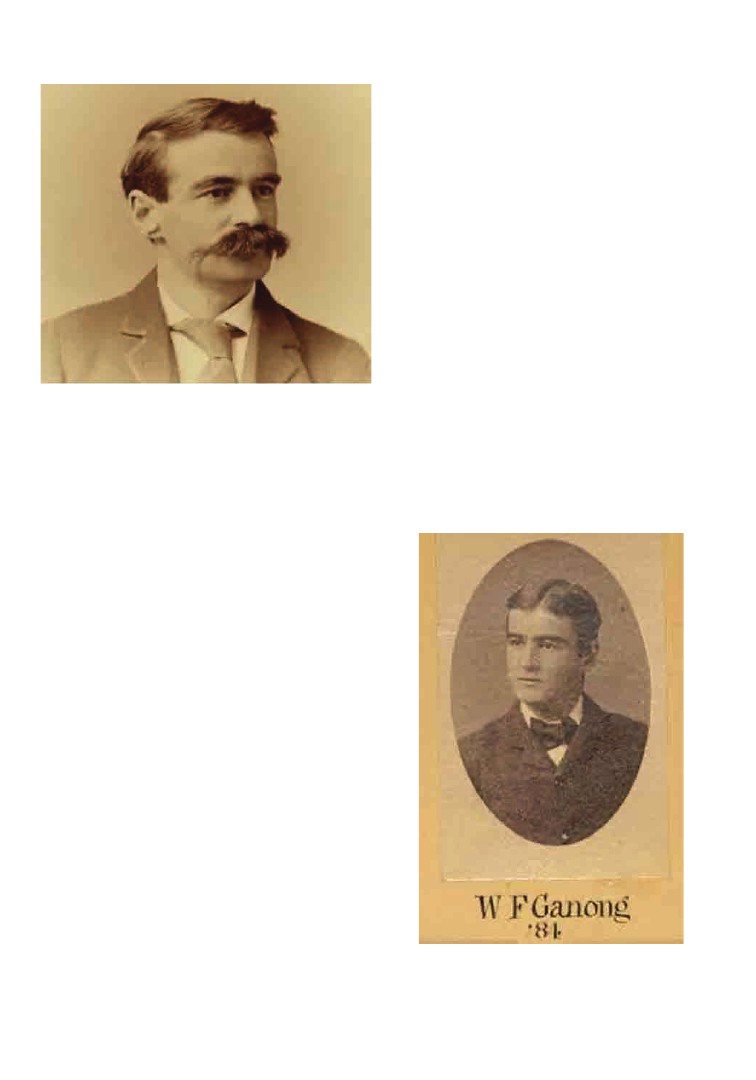
PSB 66 (3) 2020
207
the Botanical Society of America in 1906 to
form today’s Botanical Society of America
(BSA) and was elected the 15th (2nd post-
merger) BSA President (Figure 1).
Born on 19 February 1864, in Carleton, New
Brunswick, Ganong remained a dedicated
son of the province throughout his life.
He began collecting and recording natural
history specimens as a schoolboy. As an
undergraduate at King’s College (now the
University of New Brunswick), his mentor,
George Frederic Matthew (who studied with
both Asa Gray and Louis Agassiz at Harvard)
stimulated Ganong’s interest in botany and
geology. He graduated with a B.A. in Natural
Science, with Honours, in 1884 and continued
on for an A.M. (Master of Arts) in 1886
(Figure 2). In between, he published his first
biological paper on the invertebrate animals
of Passamaquoddy Bay (Ganong, 1885). He
established a remarkably persistent personal
calendar during his undergraduate years,
which alternated a nine-month focus on
academics with three summer months of field
work in New Brunswick (Figure 3). With the
exception of a summer in Germany working
on his dissertation, this pattern continued
until his retirement when, free of teaching, he
could concentrate year-round on the history,
natural history, and physiography of his home
province. “Almost every year of his adult
life, Ganong spent months exploring New
Brunswick, alone or with a companion, ‘on
foot, by canoe, wagon, bicycle, and finally by
car and carravan’” (Rees, 2016, p. 95).
Upon completing his Master’s study, Ganong
followed the advice of his mentor and enrolled
at Harvard where he received a second A.B.,
Summa cum laude, in 1887. Ganong, awarded
the Morgan Fellowship, was hired by the
Botany Department as Assistant Instructor
of Botany. Promoted in 1889, he served two
years as Instructor of Botany, specializing
in plant physiology under the direction of
Charles V. Goodale (Quinquennial Catalog,
1895; Rees, 2016). In 1893 he travelled to
Figure 1. William Francis Ganong, Professor
of Botany, Smith College.
Figure 2. Graduation photo from King’s
College, 1884.
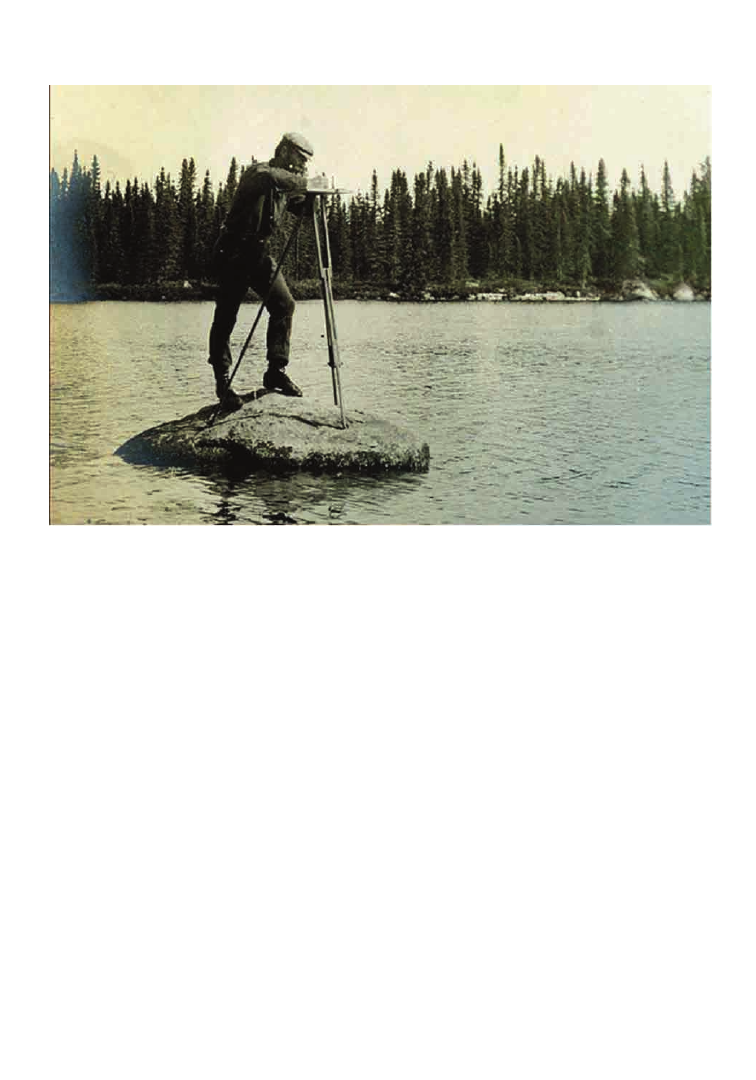
PSB 66 (3) 2020
208
the University of Munich where he studied
under Karl Ritter von Goebel. In less than two
years he researched, defended, and published
a thesis (in German) on the morphology of
cacti: Beiträge zur Kenntniss der Morphologie
und Biologie der Cacteen (Ganong, 1894).
Goebel established a major botanical garden
for his research institute in Munich and
had recently published the two-volume
Pflanzenbiologische Schilderungen (1889,
1891), which included a major section on Cacti
in volume 1, just prior to Ganong’s arrival in
Munich. With materials close at hand and a
major professor interested in development
of adaptive plant structure, Ganong fell into
a perfect circumstance. It is noteworthy that
three years later, Goebel published his opus,
Organographie der Pflanzen, in which he cites
Ganong’s contribution to cacti (volume 2, p.
452). Eager to return home, Ganong accepted
a position as the first Professor of Botany
and Director of the Botanic Garden at Smith
College, Northampton, MA, where he spent
his entire professional career. One appeal
was that Massachusetts is conveniently close
to New Brunswick. Later, when asked about
what part of his German experience he most
enjoyed, he replied, “The part from New York
back to Northampton” (Rees, 2016, p. 23). He
never returned to Europe and rarely travelled
in the U.S. except to meetings. There was
always more to discover in New Brunswick.
During his first year at Smith, Ganong
taught eight botany courses: General Botany,
Microscopical Anatomy, Anatomy and
Morphology of Cryptogams, Advanced
Natural History of Cryptogams, Advanced
Natural History of Phanerogams, Lectures
Figure 3. Ganong at Holmes Lake, 1901 (photo is basis for commemorative statue erected in
St. Stephen, New Brunswick, in 2017).
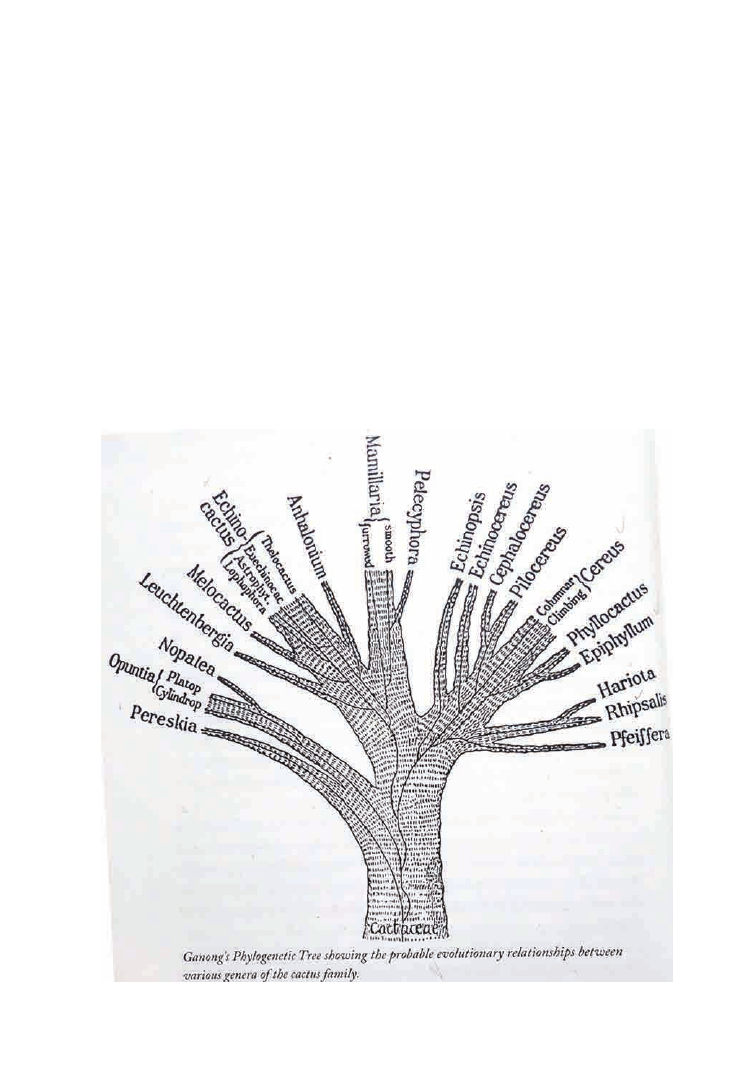
PSB 66 (3) 2020
209
upon the Physiology and Biology of Plants,
Laboratory upon the Physiology and Biology
of Plants, and Special Problems in Morphology
or Biology of Phanerogams or Cryptogams
Leading to Original Investigation. Six years
later, the curriculum consisted of General
Botany, Morphology and Ecology of the
Groups, Classification, Cellular Anatomy and
Embryology, Horticulture, and Physiology
and Investigation (Smith Botanic Garden, 2020).
Ganong now began to expand his already
extensive publication list on invertebrates in
the Bulletins of the Natural History Society of
New Brunswick with papers on the province’s
flora. With his dissertation published in
Flora, he expanded his cactus research from
comparative aspects of morphology and
anatomy of major cactus groups, which
allowed him to speculate on their evolutionary
relationships, to the role of environment in
driving xeromorphic adaptation (Ganong,
1895a, b). An obvious gap in the literature
concerned embryo and seedling development,
which he filled with a series of papers on
polyembryony and a pioneering paper in
Annals of Botany—the first comparative
study of the cactus seedling development
that allowed him to conclude that adaptive
changes in the size and form of the embryos
Figure 4. Tree based on embryology and seedling development published in Annals of Botany, 1898.

PSB 66 (3) 2020
210
are preceded by changes in the adult plant,
not the other way around (Ganong, 1898a,
b, 1899a). Based on this study, he revised his
evolutionary tree of the Cactaceae (Figure 4).
The critical role of ontogeny in formulating
evolutionary relationships was one of the
“cardinal principles” in Ganong’s view of
morphology (Ganong, 1901a).
His work on the cacti made him keenly aware
of the role of environment on plant growth,
what he called “Phytobiology” (presumably
based on Goebel’s “Pflanzenbiologie”) but
others were calling Oecology or Ecology
(Ganong, 1895c), so he now began to expand
on his earlier work in New Brunswick
(Ganong, 1891). This resulted in two major
papers in the Transactions of the Royal Society
of Canada on raised peat bogs (Ganong,
1897a, 1898c), a four-part series of papers in
the Botanical Gazette on the “Vegetation of the
Bay of Fundy Salt Marshes,” (Ganong, 1903a-d),
and a study of the Grande Plaine of Miscou
Island (Ganong, 1906). Rodgers (1944) states
that the salt marsh studies are “ranking
among the first great ecological studies made
in North America.” For Ganong, it was critical
that the ecological relationships observed
in nature were based on the physiological
and anatomical adaptations that evolve over
time (Ganong, 1904). These studies were
contemporary with those of his friend Henry
Chandler Cowles on the southern shore of
Lake Michigan.
THE SOCIETY OF PLANT
MORPHOLOGY AND
PHYSIOLOGY
Beginnings
Participation in professional societies
provided Ganong a mechanism for continuing
professional development. A natural target
for his initial interest was the Society of
Naturalists of the Eastern United States, which
was organized in 1883. An interdisciplinary
organization of botanists, geologists,
physiologists, and zoologists, among other
scientific disciplines, it provided a perfect fit
for Ganong’s interests. It is unclear when he
joined the Society, but at the 1895 meeting
in Philadelphia he was elected secretary of
a committee of five, which also included C.
E. Bessey and L. H. Bailey, to investigate the
formation of a botanical section or society
to meet annually with the Naturalists. Both
Bessey and Bailey were already charter
members of the newly formed Botanical
Society of America, which held its first
meeting four months earlier in Springfield,
MA, in association with American Association
for the Advancement of Science (AAAS).
The early history of the original BSA is well
documented by Tippo (1958) and Smocovitis
(2006).
Tippo (1958) suggested that there was some
degree of antipathy toward the new BSA on
the part of many Eastern botanists, including
Ganong. Among their concerns was a
preference for winter meetings over summer
meetings, the relatively high dues of BSA, their
preference for meeting with the American
Society of Naturalists vs. the AAAS, and

PSB 66 (3) 2020
211
most importantly, the elitism of BSA, which
admitted “only American botanists engaged
in research, who have published work of
recognized merit” (Minutes, BSA, 1893, p.
1). Membership was by invitation. Many of
the Eastern botanists felt that membership in
a botanical society should be open to anyone
who was interested in joining. The following
year the Naturalists met in Boston. Ganong,
William Farlow, Emily Gregory (who authored
the first U.S. Plant Anatomy textbook the
previous year) (Gregory, 1895), and six other
botanists met in the Harvard Cryptogamic
laboratory at 10 a.m. on Wednesday, Dec. 30,
1896 to discuss a response to a circular Ganong
sent out earlier that year about forming a new
plant-oriented society (Table 1). Although
only a few respondents expressed active
interest, the group concluded that two or three
more members would be sufficient and thus
The Committee organized at Cambridge, Dec. 30, 1896
W. G. Farlow
Harvard University
Emily Gregory
Barnard College
H. M. Richards
Barnard College
W. P. Wilson
Philadelphia Museums
B. L. Robinson
Harvard University
J. M. Greenman
Harvard University
J. M. MacFarlane
University of Pennsylvania
T. Thaxter
Harvard University
W. F. Ganong
Smith College
Added to the Committee, February, 1897
G. L. Goodale
Harvard University
W. C. Sturgis
Connecticut Expt. Station
L. H. Bailey
Cornell University
Clara E. Cummings
Wellesley College
J. E. Humphrey
Johns Hopkins
G. F. Atkinson
Cornell University
D. P. Penhallow
McGill University
B. T. Galloway
U. S. Dept. Agriculture
E. A. Burt
Middlebury College
G. E. Stone
Massachusetts Agr. College
E. F. Smith
U. S. Dept. Agriculture
Elected at First Meeting, Ithaca (Sage College) Dec. 29, 1897
V. M. Spalding
University of Michigan
D. G. Fairchild
U.S. Dept. Agriculture
H. C. Porter
University of Pennsylvania
H. J. Webber
U.S. Dept Agriculture
R. A. Harper
University of Wisconsin
Harriet L. Merrow
Rhode Island Agr. College
W. T. Swingle
U.S. Dept. Agriculture
A. F. Woods
U.S. Dept. Agriculture
Theo. Holm
“withdrawn”
W. W. Rowlee
Cornell University
A. J. Pieters
U. S. Dept. Agriculture
J. W. Harshberger
University of Pennsylvania
G. H. Hicks
U.S. Dept Agriculture
Table 1. Charter and first-elected Members, Society for Plant Morphology and Physiology.
(women in bold)

PSB 66 (3) 2020
212
they should proceed to organize a botanical
organization that would meet annually with
the American Society of Naturalists. They
agreed to invite “other botanists known to
sympathize,” primarily from the Eastern
states, and focus on forming not a general
group or one focused on taxonomy, but
rather one targeting plant morphology and
physiology “and it’s dependent (applied)
subjects.” Ganong, serving as secretary of the
group, played a vital role in establishing the
new society. Twelve days after the meeting he
sent the organizers summary minutes and a
request for additional nominees (Society for
Plant Morphology and Physiology [SPMP],
p. 59). Ten days after that, “in the absence
of definite instructions,” he preemptively
nominated 11 other botanists to join the
fledgling organization. This was sent as a
ballot to the organizers for their approval
(SPMP, p. 67). Within two weeks a majority
of the organizers agreed and Ganong posted
a 3rd Circular, a formal invitation to the
original 9 organizers and the 11 nominees,
summarizing the December meeting and
formally inviting each to present at the
December, 1897, Naturalists meeting. While
there, they would formally organize the
new society (SPMP, p. 72). In April, Ganong
sent out a 4th Circular verifying that all 20
“members” indicated interest in participating
and encouraging them to be “personally
responsible for the success of the meeting”
(Table 1). It is noteworthy that two of the
“select” 20 were women; Emily Gregory was
among the original 9 members and Ganong
invited Clara E. Cummings, a cryptogamic
specialist, among the 11 he nominated (SPMP,
p. 74). (By comparison, Elizabeth Britton was
the lone female charter member [of 25] of the
original BSA.)
At the end of October, Ganong sent a
reminder (Circular 5) that began with a sad
notification that two original organizers had
died, Dr. Gregory in April and Dr. Humphrey.
Ganong then described the recent successful
meeting of the BSA as evidence “of the widely
and rapidly spreading activity in the pursuit
of all departments of the science…with such
a growing interest in morphological and
physiological investigation, a winter meeting
devoted especially to those subjects should be
abundantly successful.” He reminded members
of their obligation to actively participate in
the upcoming meeting and encouraged them
to recruit additional interested botanists to
attend and participate. Finally, he included a
questionnaire to be returned: Do you expect
to present? Do you expect to read your paper?
Do you approve of inviting others? If so, whom
do you suggest be invited (SPMP, p. 80)?
In early December, Circular 6 informed the
committee members that 14 papers “were
promised” for the upcoming meeting “with
some others reported as probable.” Ganong also
suggested that as the papers were scheduled
to be presented early Tuesday morning, the
group should meet at 8 p.m. Monday night
to discuss “important subjects of scientific
and geographical scope, name, constitution,
conditions of membership, etc.” Attached was
a survey to indicate acceptance for an earlier
organization meeting and the full titles of
papers for inclusion in the meeting program
(SPMP, p. 94). Ten days later Ganong sent out
the program (Circular 7), which included 13
papers by “members” and an additional 16
by other invited botanists. Among the latter
were four women: a high school teacher, Dr.
Martha Bunting of Philadelphia High School;
Dr. Adeline Schively of Philadelphia Normal
School; University of Pennsylvania grad
student Caroline Thompson, who became

PSB 66 (3) 2020
213
professor of Botany at Wellesley; and recent
graduate, Dr. Lucy Wilson who also took a
position at the Philadelphia Normal School.
Also presenting were five U.S. Department of
Agriculture scientists including plant explorer
David Fairchild, who presented two papers
(SPMP, p. 97; Anon., 1913, 1916). It was
agreed that the members would meet Monday
evening at 8:45 p.m. in Dr. Atkinson’s office to
discuss “the most important and critical steps
in the history of the organization” (SPMP, pp.
97-100).
Ganong called the meeting to order and D. P.
Penhallow moved to form a Society for Plant
Morphology and Physiology; the motion
carried. There would be no geographic
restriction on membership, but meetings
would be held north of Washington DC and
no further west than Buffalo. There would
be no annual dues; fees would be assessed
to meet “necessary expenses.” Two standing
committees, Admissions and Program, were
appointed with Ganong chairing the latter as
Secretary/Treasurer of the Society. Candidates
for membership should be nominated by
two members and show “ability in original
research.” A total of 16 rules for operating the
society were adopted (SPMP, Records No. 1).
Thirteen new members were elected (Table 1)
(SPMP, pp. 1-3, Records No. 1; Smith, 1898).
The first meeting exceeded expectations with
22 papers presented. Abstracts of the papers,
and brief histories of the organization, were
reprinted in both The American Naturalist
and Botanical Gazette as well as the records of
the Society (Ganong, 1898d, e; Smith, 1898;
SPMP, Records 1).
We know much about the creation of the
Society for Plant Morphology and Physiology
because of the detailed organizational skills
and meticulous notes that characterize
Ganong’s work. Rees (2016, p. 66) says,
“He described himself as a pre-Raphaelite: a
precise, small-details man, a pointillist not a
brush-waving Romantic.” His handwritten
notes, copied correspondence, detailed
summaries, and copies of programs and
annual records as Secretary/Treasurer fill
a ledger documenting the 9-year existence
of the Society, from 1897 to 1906, that is
comparable in size, and considerably more
detailed, than the corresponding volume that
documents the first 32 years of the BSA from
1894 to 1926.
Major Initiatives
Membership and participation in the Society
grew every year and a variety of amendments
were made to the rules. An interesting 1898
resolution was “that this Society recognizes
the metric system as the standard of
measurement when employed in its working
and members are requested to observe this
rule in the preparation of papers” (SPMP, p.
6). The following year, the Society initiated
work on the first of two large initiatives.
Botanical Literature
In the last decade of the 19th century, the
Botanical Gazette (published by the University
of Chicago) was the primary journal for
publishing—not only primary research, but
also brief reviews of published or presented
American research. This paralleled some
major European journals, but there was little
overlap across the Atlantic, which diminished
exposure of American work. At the 1899 New
Haven meeting of SPNP, President Farlow, in
his outgoing address, noted the “increasing
need and demand for prompt, synoptical,
descriptive reviews of new botanical papers

PSB 66 (3) 2020
214
and books…” (SPMP, Botanical Literature,
p. 1). The Society decided to approach the
Botanisches Centralblatt to see if better
reviews could be obtained, and Professors
Farlow, MacDougal, and von Schrenk
were appointed to investigate this matter.
MacDougal, who was Secretary of the Section
G (Botany) of AAAS, invited them to the June
AAAS meeting at the New York Botanical
Garden to discuss an approach, but as we will
see later, the SPMP chose not to meet with
AAAS. Although not a committee member,
as Secretary of the Society, Ganong took the
lead, and on January 19, 1900 he addressed
a letter to Dr. Oscar Uhlworm, Editor-in-
Chief of Botanisches Centralblatt, in which
he summarized the request of the group. The
committee realized that such reviews were
already contained, in part, in the Centralblatt,
but that many were relegated to the Beihesste,
which required a separate subscription. They
suggested that American botanists would
strongly support collecting all of the timely and
descriptive reviews of new botanical works in
the Centralblatt (Ganong, 1900). At the end of
April, Uhlworm replied to Ganong. Perhaps
he misunderstood some of the Americans’
concerns, but one of his concessions would
allow two or three American editors onto the
editorial board. Yet, the main concern went
unaddressed. In October, Ganong replied on
behalf of the Committee that: (1) it would not
be possible for the Americans to subsidize
the change to the Centralblatt, (2) simply
increasing the size of each volume would not
be a solution, (3) if some material shifted to
another journal, one should not be required
to separately subscribe to both, and (4) the
idea of adding American botanists to the
editorial board “would contribute greatly to
make the Centralblatt acceptable to American
Botanists.” Uhlworm ultimately agreed,
but ownership of the journal changed as it
became the organ of the new International
Association of Botanists. Seven American
editors, coordinated by William Trelease,
were appointed to the board (Anonymous,
1902; Bessey, 1901; SPMP, 1900–1902). This
initiative was considered by many to be the
primary accomplishment of the Society for
Plant Morphology and Physiology as it added
to the prestige of all American botanists
(Rodgers, 1944, p. 220).
College Entrance Exam
As a new faculty member, Ganong was not
invited to be a part of the “Committee of
Ten” charged by the National Education
Council (NEA) in 1894 to devise a common
botany curriculum for schools. The botany
recommendations closely follow Bessey’s
Textbook of Botany (Bessey, 1896; Sundberg,
2012; Table 2). But five years later Ganong
had the opportunity to react. The NEA called
for another report to specify college entrance
requirements for botany. Committee members
were drawn from the regional accrediting
agencies, AAAS, and NEA. Both Ganong,
representing the New England region, and
Bessey, representing AAAS, served on the
botany section. Much of the report paralleled
the earlier work except now, thanks largely to
Ganong, ecology and physiology composed
about half of the botany course. The traditional
recitation approach, focusing on memorizing
morphological parts and using taxonomic
keys to identify flowers, was “entirely
inadequate.” Ideally, instruction should focus
on the laboratory and microscopic analysis of
structure and development. The committee
considered the compound microscope to be
useful and necessary to demonstrate many
important structures. However, Ganong
suggested, “The compound microscope is a
difficult piece of apparatus for a young student
to use intelligently…demanding considerable
training…and longer periods than are

PSB 66 (3) 2020
215
given in secondary schools.” Alternatively,
observational study should focus on plants as
living things in the context of their ecology
and physiology. These should make up the first
half-year of the course. The second half-year
should focus on comparative morphology and
the evolution of plant groups. “In connection
with both of these courses your committee
would call special attention to the great
importance of drawing as a means of securing
definite observation.” Furthermore, Botany
should be offered either in the junior or senior
year (Table 2). At the end of the report Bessey
authored a page of comments dissenting
from the majority view on several points. Not
surprisingly, given his focus on the microscope
in laboratory instruction (see Sundberg, 2012,
p. 115), he noted examples of successful use of
microscopes in some “fourth, fifth, and sixth
grades of certain public schools in Nebraska”
(NEA, 1899, p. 175). He also objected to the
focus on ecology because it was so new to
botany that no teachers will have been suitably
trained to teach it. Similarly, he thought that
the emphasis on the processes of physiology
would be a challenge for teachers to go beyond
“any but the loosest way by secondary pupils.”
He also thought too much had been cut from
a survey of the plant kingdom to make room
for these more advanced topics.
Partially in response to the formation of new
college governing boards for the Northeastern
and Middle States and Maryland, and perhaps
also in response to this dissent by Bessey, the
following year Ganong presented a paper,
“Suggestions for an attempt to secure a
standard college entrance option in botany,”
at the annual meeting of SPMP at Johns
Hopkins. In response to his paper, the Society
appointed a committee of Ganong (chair),
F. E. Lloyd, and George Atkinson to prepare
such a document on behalf of the Society.
They successfully argued that education in a
scientific specialty “should be a chief care of
any scientific society” (Ganong, et al., 1908, p.
594). The committee completed a preliminary
draft in April of the following year, followed
by two revisions based on recommendations
received from the membership (
Table 2)
. The
committee presented a third revision at the
1902 meeting in New York. Ganong and Lloyd
were appointed to a permanent committee
charged to make the report “as useful,
educationally as possible and to keep it in
touch with changing educational conditions”
(Ganong and Lloyd, 1902, p. 2). This report
was accepted by the College Entrance
Examination Board and served for several
years as the basis for college admission to
botany programs. This committee carried over
through the merger with the Botanical Society
of America to become the Committee on
Education of the BSA with the fourth and final
report published in 1908 as publication No. 35
of the BSA and in The School Review (Ganong,
1908). Furthermore, as part of the vote for
authorization, the BSA recommended: “That
all members of this society who are connected
with universities or colleges be requested to
bring before their respective faculties the fact
that examinations are now being held every
June …in a year’s thorough course in botany…
and that it is desirable…that it be widely, or
indeed universally, accepted by colleges as an
option for entrance” (Ganong, 1908, p. 595).
Not surprisingly, the recommended course
follows very closely the outline provided in
Part II of The Teaching Botanist (Ganong,
1899b; Table 2).

PSB 66 (3) 2020
216
Merging the Societies: the
Botanical Society of
America
The final activity of SPMP was to participate
in a mutually agreeable union of the three
American botanical societies to establish
the current BSA. As usual, Ganong played a
major role. In 1899, the SPMP met at Yale
where D. T. MacDougal, newly elected to
the Society but also Secretary of the botany
section of AAAS, extended an invitation to the
members to attend the next AAAS meeting,
which would be held in New York in June
of the following year. As mentioned earlier,
MacDougal’s purpose was to allow BSA to
also engage in the Botanisches Centralblatt
negotiations. Rather than meet jointly with
the BSA at AAAS, the SPMP chose to stay with
the Naturalists who met at Johns Hopkins in
December. The following year, when SPMP
met at Columbia University, MacDougal
initiated a discussion on “the most profitable
relation of the American botanical societies to
one another” (SPMP, p. 28). After all, at least
seven of the 60 members of SPMP in 1901
also belonged to the BSA: George Atkinson,
Liberty Hyde Bailey, John Coulter, William
Farlow, Byron Halstead, Conway MacMillan,
and William Wilson. In 1902 the BSA also
began to discuss the advantages of unifying the
botanical societies. The following year saw the
formation of the third botanical society, the
Mycological Society of America, and an SPMP
Committee on Relations with other botanical
societies, which included President George T.
Moore, Ganong, and Past-President Duncan
S. Johnson. Discussions favored a union, in
principle, but only under certain conditions.
First, all members must share an equal voice
in the affairs of the combined society (there
should be full members only, no associate
members). Second, all sections should have an
equal voice in nominating officers, preferably
by some form of proportional representation.
Third, membership of sections should be
controlled by the sections. Fourth, fees should
be kept down to an amount necessary to cover
cost of administration, and there should be
no separate admission fee. Finally, if a plan
Author
Ecology
Physiology
General
Morphology
Gross
Morphology
Special
Morphology
NEA (1894) Not
Mentioned
Not
Mentioned
Very
Important
Not
Mentioned
Not
Mentioned
NEA (1899) Very
Important
Important
Important
Important
Somewhat
Important
SPMP (1901) Important
Important
Important
Important
Not
Mentioned
Bessey (1896) Somewhat
Important
Somewhat
Important
Very
Important
Important
Somewhat
Important
Ganong
(1899b)
Important
Important
Important
Important
Not
Mentioned
Abbreviated from the table in Trafton, 1902.
Table 2. Comparison of botanical topics covered in Guidelines and Textbooks.

PSB 66 (3) 2020
217
for union was agreed upon by the respective
committees, it should be printed and sent to
the SPMP membership as soon as possible to
allow ample opportunity for consideration
before the next meeting (SPMP, p. 42). At
the same time, two BSA Past Presidents,
Bessey and Lucien Underwood, and President
Charles R. Barnes served as the BSA
Unification Committee. Rodgers (1944) has
some interesting quotes that present a BSA
perspective toward union of the societies:
• Underwood to Bessey (p. 222): “…Altho
[sic] this society was really organized as
a sort of protest against our own… I do
not see that we have anything to gain by
any formal union with them and very
much to lose if we modify in any way
either the matter of our elections or our
fees system….[organization of the my-
cological society] doubtless will have the
effect to reduce the interest in the Soc. Pl.
Morph. And Phys. Since several of the
leading spirits of that organization are
mycologists...I do not think it will affect
us one iota…”
• Barnes to Bessey (pp. 222-223): “I believe
it should be the policy of the B.S.A. to
make itself the dominant force so far as
organized botanical activity is concerned,
and I believe it can only do this by unit-
ing all…”
• Bessey to Underwood (p. 223): “Let us
not discourage them [other botanical so-
cieties], while on the other hand perhaps
we need not give a boisterous encourage-
ment…In this way we may have for a
time a ‘struggle for existence’ resulting in
the ‘survival of the fittest….”
• Underwood to Bessey (p. 224): “They
[SPMP] have certain members…that I
could not honestly vote for and I believe
they have quite a number what would not
poll a majority of the votes of the Botani-
cal Society…”
In December, 1904, all three societies
met jointly in Philadelphia with the three
committees on unification negotiating and
reporting back to their respective societies.
The main order of the SPMP business meeting
was to accept the principles recommended by
the committees of conference for union and to
authorize a new committee charged to bring
the union into effect. The SPMP committee
consisted of Past-President G. T. Moore,
President E. C. Jeffrey, and Ganong.
It was also announced that SPMP was
invited to send a delegate to the International
Congress of Botany at Vienna in June, 1905;
the membership selected former President
Farlow to represent the Society. Farlow did
not attend, nor did a representative of the
other two societies. Although 16 American
botanists attended as independent delegates,
“American societies were sadly negligent, and
many were unrepresented which might have
delegated authority to some of the sixteen”
(Barnes, 1905). Barnes observed that the
display of materials for botanical instruction
was “particularly noteworthy,” especially with
apparatus for plant physiology experiments.
“The equipment puts to shame all of our high
schools and nine-tenths of our colleges” (p. 71).
The final meeting of SPMP was held at the
University of Michigan in December, 1905.
Twelve papers were presented, including
“On the erroneous physiology of elementary
botanical text-books” by Ganong. The report
of the Committee on Union of the Botanical
Societies was adopted as presented. There
would, after all, be two grades of membership
with one fifth of the members of SPMP
(and the Mycologists) now being relegated
to associate membership of the unified
society (all members of BSA retained full
membership). Selection of associates from
SPMP was simple: if your name began with D

PSB 66 (3) 2020
218
or later and were elected in 1902, and all new
members elected in 1903, 1904, and 1905,
would become associate members (SPMP,
Record #9, p. 3). There was no election of
officers; current officers would continue
until union was affected the following year.
Ganong signed off on the Society’s approval
on 28 December and forwarded his report to
the BSA (Minutes, p. 93).
The 13th annual meeting of BSA, and first
of the united BSA, was held at Columbia
University on Dec. 27-31, 1906. The logistics
of combining the Societies filled the first day.
Ganong presented and was the signatory for
the SPMP membership and financial records
and was appointed to the auditing committee
of the new BSA. He moved that the records of
both SPMP and the Mycologists be deported
to the library of the Missouri Botanical
Garden for preservation “after having served
the immediate purpose of the Secretary and
Treasurer of the BSA” (Minutes, pp. 101-
104). He also moved that the SPMP Standing
Committee on College Entrance Options in
Botany be continued and offer a final report
the following year. George Atkinson, one of
two scientists with membership in all three
merging societies, was elected 14th president
of the BSA (and first of the unified BSA) in
1906. Ganong was elected 15th BSA President
in 1907. (Margaret Ferguson, one of the six
female botanists who transitioned from the
SPMP in 1906, became the 36
th
[and first
female] BSA President in 1929.) Interestingly,
MacDougal, who was now President of Section
G (Botany) of AAAS, was not listed at all on
the combined BSA membership (Minutes, pp.
96-101, Table 3).
In his address as retiring president of the BSA,
Ganong reflected on the state of botanical
education in America in 1910; it is uncannily
prescient for today (Ganong, 1910a). He began
by enumerating several widely recognized
problems. First, that science tends to be
difficult for most people because it depends
on “reasoning, not feeling.” Second, students
are not only generally unprepared for college,
but specifically unprepared for the sciences.
In the schools, responsibility for learning has
been shifted from the student to the teacher
and students bring that attitude with them to
college. Third, science, as a laboratory-based
discipline, had only a single generation to
develop and propagate an effective educational
strategy. Finally, an inquiry approach to
Table 3. Membership in uniting Societies at time of union.
Botanical
Society of
America (B)
Society for Plant
Morphology and
Physiology (S)
American
Mycological Society
(M)
Total
Full
32
34 (5 women)
23
89
Associate
13
14
3
30
Total
45
48
26
119
Multiple
B & S
B & M
S & M
B, M & S
Total
11
8
3 (1 woman)
2

PSB 66 (3) 2020
219
teaching “is distasteful to the great majority
[of students] … who prefer to absorb their
knowledge from printed books upon which
they can lean for authority” (p. 323).
He then went on to enumerate some of the
problems that scientists have bring upon
themselves in regard to teaching science, the
most important of which is that “we are not
faithful to the genius of our subject” (p. 324).
“In a word, the first great need of our science
teaching is to make it scientific” (p. 325).
The current mantra is that we should teach
science as we do science (Handelsman et al.,
2004; Hanauer et al., 2006). Directly related
is the generalization of introductory courses
that “cover” the breadth of the discipline,
an inch deep. Textbooks were, and continue
to be, part of the problem. Much better is to
concentrate on the basic ideas and go into
enough depth to cultivate understanding.
A second impediment to effective teaching,
Ganong suggested, is to focus solely on the
subject while ignoring the students. Success
in teaching is directly proportional to one’s
ability to communicate with others. Thus
attitude and diplomacy are important: “gloving
the iron hand of the scientific method by the
soft velvet of gentle human intercourse” (p.
325). Providing some context of the history
and personalities of scientific discovery are
also useful tools to engage students. Another
problem, particularly in the laboratory, is
putting too much trust in the technologies
and not enough in the individuals. What’s
important is not the equipment, but how
you use it and how you interpret the results.
Finally, the method of training teachers is
wrong. Science professors at colleges and
universities are good at cloning themselves to
provide researchers for the future, but they are
totally unprepared to teach future teachers, at
any level. For his own part, he acknowledged
a philosophical change:
“It took me many long years to free
myself from the feeling that I must
continue research or else sacrifice the
good opinion of my colleagues. But I
am free, and in the two or three years
I have been so the added keenness
of my pleasure …I propose to try
to convince the society that its rules
ought to be altered as to make teaching,
of approved merit and service, a
sufficient qualification for membership.
Meanwhile, I advise all of my colleagues
engaged in collegiate work to join in my
declaration of independence. Let us
show the universities that teaching hath
her victories no less than research” (p. 329).
Indeed, Ganong experienced a revelation that
significantly shifted his goals and expectations.
He continued his BSA roles on the Auditing
Committee and Committee on Education for
two more years and twice he was selected a
Councilor (at-large member of the Council).
In 1914 he served on the committee to
nominate the first Editorial Board of the
Society’s new journal, the American Journal of
Botany, but he never again presented at a BSA
meeting and only rarely published botanical
(teaching) articles—notably dealing with
plant physiology. Instead, he focused on his
teaching and his students at Smith.
The Teaching Botanist
Graeme Wynn (2017) calls William Ganong
a “prodigious polymath.” Beyond all else,
however, Ganong was “The Teaching
Botanist.” His philosophy of teaching stressed
that instruction should be based on first-hand
study of living plants, in the field or in the
laboratory. Furthermore, when the student
is studying botany, the teachers' primary
concern should be studying the student

PSB 66 (3) 2020
220
and how best to facilitate learning. One
could easily argue that while writing about
teaching botany for the 20th century, he was
actually anticipating teaching botany in the
21st century. The Teaching Botanist, which
went through two editions, is the teacher’s
manual for how educate students about plants
(Ganong, 1899b, 1910b).
His first precept is that college teaching
should be carried out as an investigation, or at
least in that spirit. “The revival in students of
the spirit of inductive inquiry, a spirit which
they naturally possess, but which is usually
crushed out of them by the school course, is
the first and greatest task of any teacher of a
Science” (Ganong, 1899b, p. 17). Thus, for
any topic, laboratory work should precede
the lecture and the textbook should be used
only as supplementary reading. Especially in
introductory courses, students bring a wide
variety of preparation and the teacher’s task is
to determine what each student is best fitted
for, and then to set out to help the student
reach that point. Most students will not major
in botany, but all will find some use for it in
their lives and their instruction will need to
be thorough and “in considerable amount.”
Those few who intend to go on should be
challenged to a level beyond their expectation.
While he acknowledged the differences
in opinion as to the content that should be
covered in the introductory course, particularly
compared with Bessey and others, his primary
learning outcomes had nothing to do with
content. (1) Exact observation; start with
the familiar, but focus on active seeing, not
passive looking, and sketch what is observed.
(2) Critical comparison and generalization.
(3) Faith in causality: “anatomy and
morphology should from the first be viewed
in the light of the factors determining them …
physiology and ecology.” “The cultivation of
testing the connection of causes and effects
by experiment is a most important part of
botanical training” (p. 26). (4) Evaluating
evidence and forming conclusions, whether
supported or not. (5) Promoting terse, logical,
and complete expression of the results, using
appropriate botanical terminology. (6)
Intellectual honesty and forming a habit of
objectivity; eliminate anthropomorphisms
and promote intellectual independence.
Botanical content should focus on: (1) the
position of plants in nature, (2) the structure
of plants and how they live, (3) adaptations
of plants to their environment, and (4) the
nature of irritability and plants’ response to
their environment.
The heart of the book is Chapter 3, “On things
essential to good botanical teaching.” “The
true teacher of Botany, as of any other subject,
is born, not made. But a chief birthmark is
a determination for incessant improvement”
(p. 46). The path to teaching begins with a
college career dedicated to providing a depth
of understanding of the major fields. Beyond
college, this should extend to summer schools
and workshops to stay current in the field.
A program of self-study and some kind of
original investigation hones the skills to be
taught. This could also include what today
we call the scholarship of teaching and
learning: “investigation into better and more
economical ways of utilizing the science in
education… and this line of investigation is
as legitimate, as difficult, and as important for
the advancement of botanical science as is the
elucidation of vegetative parts, chromosome
numbers, or transpiration currents” (p. 50).
In terms of teaching temperament, one should
be sympathetic, but an uncompromising and
yet genial critic of students’ accomplishment.
“He was kindness itself to his students but he
never once told us anything we could find out

PSB 66 (3) 2020
221
for ourselves” (Brixter, 1942). He notes that
the tendency in education had been to shift
responsibility for learning from the student
to the teacher, but that “this is a very wrong
attitude; the responsibility for learning should
be kept upon the student” (p. 53).
The laboratory is the primary focus of
investigation and ideally should have no more
than 16 to 20 students (the ideal is 10) over at
least a 2-hour period, preferably twice a week.
The amount of work should be adjusted to
“rather above the average student.” The best
students may complete the work in the allotted
time and be held to a high standard, but make-
up work should be completed outside of class.
The laboratory should always be accessible to
students. Considerable freedom of movement
and conversation must be allowed “during the
laboratory and students must be expected
to clean up after themselves.” Whenever
possible, answer questions with questions to
promote the thinking process—from known
to unknown.
Many of the laboratory manuals available in
Ganong’s time (as well as our own) were very
precise in their instructions to students and
designed to reinforce known expectations
(Cookbook labs). Ganong’s philosophy
allowed students to make mistakes and to
analyze their results based on trust in their
data. “The good teacher, too, will not be above
employing many little tricks and devices to
arouse interest, keep attention, and encourage
application” (p. 62). Because of time and
equipment constraints, many physiological
experiments must be set up as demonstrations,
but each student should observe and record
her own results and deduce conclusions as if
the experiment was her own. Lectures, which
occur after the lab work on a topic, are valuable
for reinforcing what was learned (the reverse
of the traditional relationship between lecture
and laboratory and a model of what we now
call a “flipped classroom”). “They do not like
the process at first, but their satisfaction in the
obvious worth of the results, and especially
their pleasure in the exercise of a power
they did not know they possessed, makes
them in time like the process itself” (p. 68).
Table 4. Student publications.
Student
Year
Citation
Topic
Sophie Eckerson
1905
Bot. Gaz. 40: 302–305
Spectra of chlorophyll
solutions
Sophie Eckerson
1908
Bot. Gaz. 45: 50–54
Root pressure
Grace Clapp
1908
Bot. Gaz. 45: 254–267
Transpiration
Grace Bushee
1908
Bot. Gaz. 46: 50–53
Protoplasmic streaming
Sophie Eckerson
1908
Bot. Gaz. 46: 221–224
Stomatal distribution
Sophie Eckerson
1909
Bot. Gaz. 48: 224–228
Starch production in leaves
Julia Paton
1922
Am. J. Bot. 8: 471–501
Pollen enzymes

PSB 66 (3) 2020
222
Figure 5. William Ganong, c. 1910, with botany honors class in the experimental house at Smith
College. Next to Ganong is likely Helen Ashhurst Choat, Assistant in Botany. The students—
Elizabeth Green, Mabel Bray, Louise Elder, and Elizabeth Johnson (all class of 1913)—are shown
gathering data from Auxograph devices, designed by Ganong to automatically measure and plot
shoot growth. (Photo by Katherine McClennan, with permission of Smith College Archives.)
Finally, one should teach by example. “It is
an inspiration to students to see their teacher
himself a student always striving to learn and
advance” (p. 65). One proof of his method is
that several of Ganong’s students published
their own undergraduate research done under
his direction
(Table 4).
As mentioned above, Ganong thought it was
important for students to record observations
in their notebooks, thus he included a chapter
on scientific drawing and descriptions. His
advice is as salient today as it was 100 years
ago. To sketch requires careful observation
first, before outlining, in light pencil, the
general patterns observed. Later, once
proportions are correct, details can be added,
either to the original sketch or as an enlarged
insert to highlight the detail. The scale should
always be indicated, preferably in metric, and
neat labels arranged so that straight-edge lines
can connect labels to the appropriate parts.
Diagrammatic accuracy should be stressed,
which makes it easy for the instructor to
evaluate what the student has seen. Ganong
also included chapters on the design of
laboratories and their equipment, botanical
collections, and books for teaching. Critical
to the teaching laboratory was the greenhouse
and garden plantings (Ganong, 1897b, 1910c).
The experiment house of the greenhouse
range was directly connected to the laboratory
classroom and was used extensively by
upper division students for plant physiology
experiments
(Figure 5).
Ganong designed
a variety of physiology apparatus for the
classroom. Most of these appear in his Plant
Physiology textbooks (Ganong, 1901b, 1908)
and the catalog of apparatus manufactured to
his design and available from Bausch & Lomb
Optical Co (Ganong, 1914)
(Figures 6, 7).
The collections chapter includes suggestions
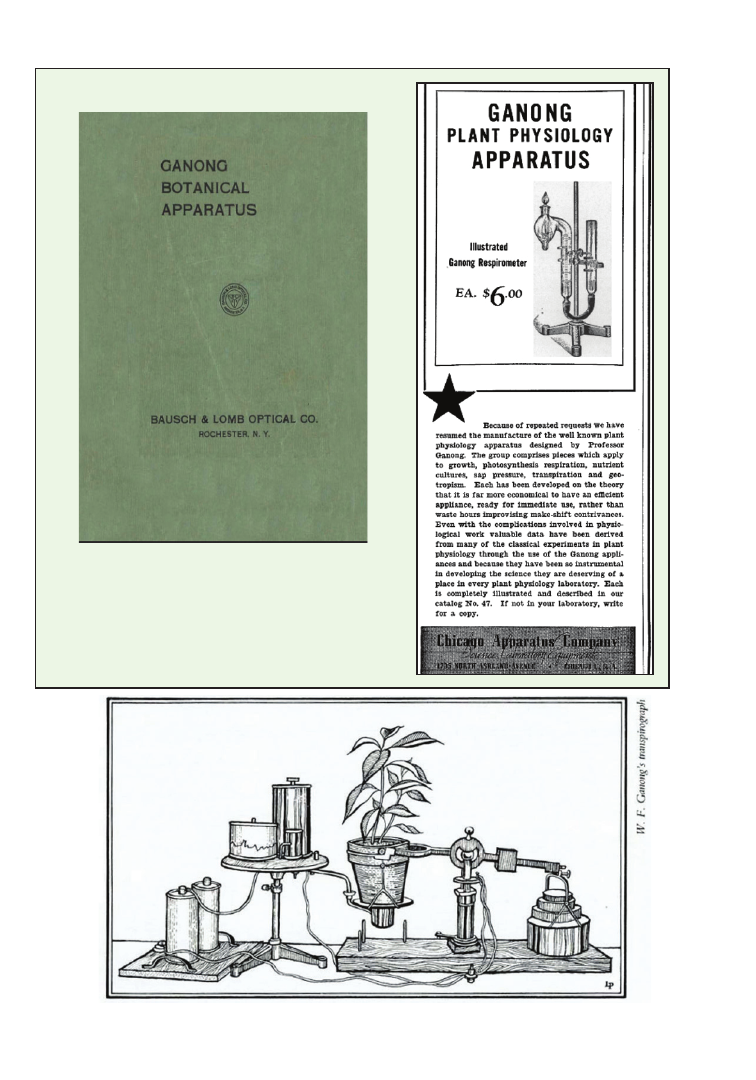
PSB 66 (3) 2020
223
Figure 7. Diagram of Ganong’s transpirograph ($75) with transpiration balance ($80).
B
A
Figure 6. (A) Bausch & Lomb 1914 Catalog of
Ganong Plant Physiology apparatus.
(B) Ad from 1938 Science advertising Ganong
Respirometer.
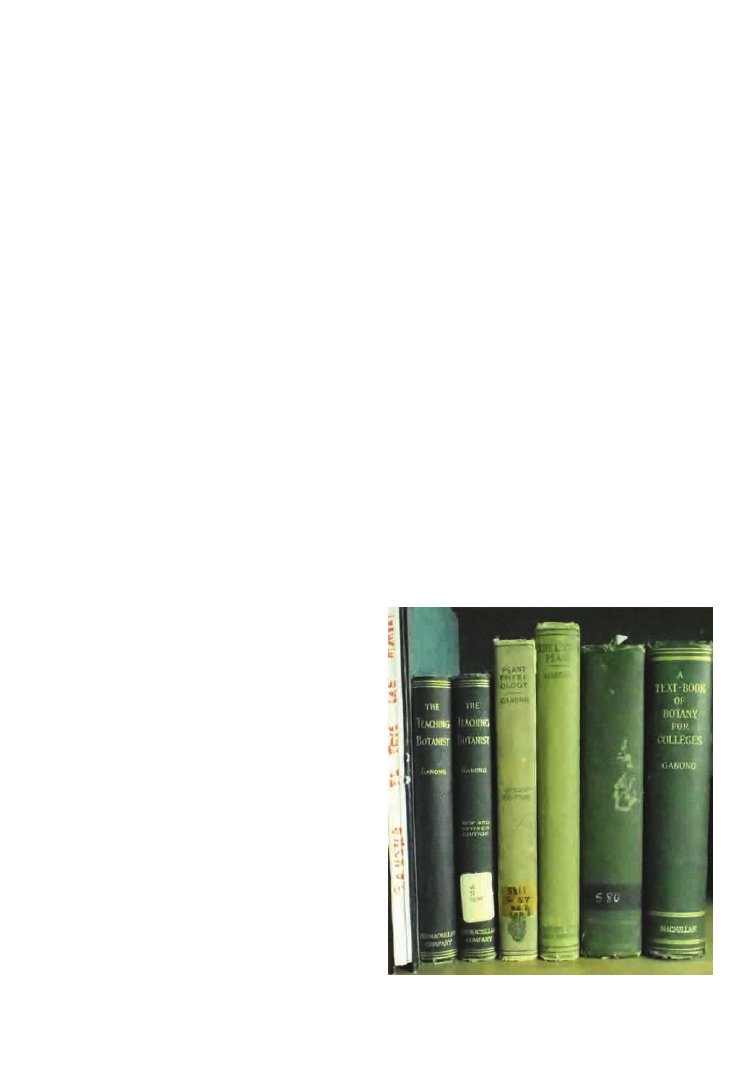
PSB 66 (3) 2020
224
Figure 8. Sampling of Ganong’s texts.
for living collections, charts, and models,
and collecting and preparing both preserved
and herbarium specimens. The nearly 100
recommended books range from classic
German and British texts to American floras
and contemporary textbooks. Also included
are all of Darwin’s botanical books and
Wallace’s Malay Archipelago.
The final chapter of part I is “On some common
errors prejudicial to good botanical teaching.”
In Gager’s review of the second edition, he
says, “The writer believes that there is no error
more widespread or more erroneous than that
knowledge of a subject, alone and of itself,
confers teaching power or is the sole need in
the preparation of a teacher. ‘The Teaching
Botanist’ is a protest against this point of view,
and a positive, constructive contribution
toward the solution of the problem of more
effective botanical teaching” (Gager, 1910).
Part II of the book, “An outline for a synthetic
elementary course in the science of botany,” is
an application of Ganong’s philosophy to the
topical outline of content he espoused in the
beginning with the NEA guidelines of 1899
through the BSA guidelines for the college
entrance course of 1908.
The philosophy and general organization
found in The Teaching Botanist is mirrored in
each of Ganong’s other texts but the target is
now students, not their teachers
(Figure 8)
.
“I was once such a learner, and I have tried
to write such a book as I would then have
delighted to read” (Ganong, 1913, p. v). His
goal is always to emphasize the big ideas and
go into depth to explain the interpretation
or principles involved. Whenever possible,
these principles are put into the context of
humans’ relationship to plants. These were
not typical texts. The writing was a narrative,
not a sequence of numbered concepts to be
memorized for recitation. The convention
for botany texts, introduced by Almira Hart
Lincoln Phelps around 1830, numbered
sequentially each of the concepts introduced
in a textbook (Sundberg, 2012). Bessey and
others still used this format into the late 1910s.
Ganong was an early deviant. Ganong’s order
of content coverage also differed significantly
from Bessey. Bessey (1905) used the still
familiar bottom-up approach beginning with
the structure of cells, tissues, tissue systems, and
organs before considering the structure and
function of whole plants. Ganong began with a
discussion of the scope and value of botanical
study and the distinctive characteristics of
plants followed by an integrated treatment of
the structure and function of the distinctive
plant organs: leaves, stems, roots, flowers,
fruits, and seeds and their relation to the
environment. Both treated plant classification
in part 2 of their text; Bessey concentrating
on morphology and Ganong integrating

PSB 66 (3) 2020
225
ecology and physiology with the morphology.
Whereas Bessey concludes with the taxonomy
of flowering plants, Ganong provides a chapter
on the ecological classification of plants.
By 1917 the Smith Botany Department
expanded to seven faculty members serving
about 200 students majoring in some aspect of
botany. Most students followed the technical
track in preparation for teaching or laboratory
work. Required courses included Systematic
and Economic Botany, Morphology, and
Physiology with electives of Ecology and
History of Botany. Those in the Gardening
track took Horticulture and Landscape
Gardening and either Systematic Botany
or Ecology. The Economic track required
Bacteriology and Plant Pathology with
electives of Systematic and Economic Botany
or Physiology. A research problems course
could be taken in Physiology, Morphology,
or Ecology. The enlarged greenhouse range
now included experimental houses for both
Plant Physiology and Horticulture and the
Department shared a new Biology Building
with the Zoology Department. “In all we
try to remember that while good facilities
are fine tools for skilled workmen, the ideal
of education is still Mark Hopkins and the
log. If the spirit of Mark Hopkins be present
I suppose it does not matter if the log be
polished oak” (Ganong, 1917). After 38 years
of service, Ganong retired from Smith in
1932. A tribute in the Alumnae Quarterly
noted, “They [former students] remember
the delight of his buoyancy and enthusiasm
in lecture-room and laboratory, his whimsical
humor, his eagerness in bringing to their
immature minds the inspiration of the attitude
of research” (Seelye, 1932).
The year prior to retiring, Ganong confided in
a letter to a Canadian colleague that although
he had not lost interest in teaching, he thought
he was losing touch with his students and a
“great gulf” had opened between them. While
he remained idealistic with his head in the
clouds, they had their feet planted firmly on
the ground and focused on a career (Rees, p.
197). Free of teaching, “But Oh! The luxury
of not having to go at any fixed time to
classes! The cartography goes on, however,
I can always drop anything and turn to that
with joy” (Rees, p. 198). He could now pursue
BOX 1
Some of Ganung’s
Honors and Awards
• 1893: Corresponding Member,
Royal Society of Canada
• 1898: Honorary PhD,
University of New Brunswick
• 1900: Fellow, American
Association for the
Advancement of Science
• 1909: Fifteenth (2nd unified) Presi-
dent, Botanical Society of America
• 1920: Honorary LL.D.,
University of New Brunswick
• 1931: J. B. Tyrell Historical Medal,
Royal Society of Canada
• 1940: Charles Reid Barnes Life Mem-
bership, American Society of Plant
Physiologists

PSB 66 (3) 2020
226
the mountains of data from summers in New
Brunswick and supplement with additional
field work, new research, and publishing. But
that was another life.
Throughout the years he received several
honors and awards, and in 1940, the
year before he died, he received another
(Box 1). The American Society of Plant
Physiologists held their 17th annual meeting
in Philadelphia and at the annual dinner,
on 30 December 1940, awarded Ganong the
Charles Reid Barnes life membership award.
“Dr. Ganong was an excellent teacher, a very
exacting and careful laboratory technician,
inventor of many devices for physiological
experiments, and a writer of textbooks and
manuals which exerted a profound influence
upon the teaching of plant physiology.”
Furthermore, they dedicated Volume 16 (1) of
Plant Physiology to Ganong “in celebration of
the seventy-seventh anniversary of his birth
(ASPB, 1941). Although in poor health and
suffering from Parkinson’s, he returned, as
usual, to New Brunswick that summer. He
died on 7 September 1941. Upon his death he
was eulogized in the Transactions of the Royal
Society as one of Canada’s “greatest scholars”
(Webster, 1942a, b) and in Science (Smith
and Choate, 1941). The BSA published no
obituary and the council minutes state simply,
“The secretary reported on the deceased,
resigned, and dropped members of the society
for 1941” (Minutes, 1941, p. 41).
Conclusion
William Francis Ganong was a driving force
during the early years of professional botany
in the United States. He produced pivotal
studies in plant morphology and systematics,
plant ecology, and plant physiology and was
the first to integrate these sub-disciplines in
teaching botany. He was the first American
botanist, if not the first scientist, to advocate
using a scientific approach to teaching science.
And all of this was his vocational occupation,
that gave way every summer, and during his
“retirement,” to pathbreaking achievements
in a variety of other disciplines in which he
demonstrated recognized expertise. Why
do more botanists not recognize his name?
Why does the BSA have a Charles E. Bessey
teaching award and not a William F. Ganong
teaching award? Perhaps botanists were
offended by his Presidential Address (Ganong,
1910a) where he challenged the Society “to
make teaching, of approved merit and service,
a sufficient qualification for membership” (p.
329). Perhaps it was because he admitted in the
same paragraph that after many years he was
finally “…able to free myself from the feeling
that I must continue research or else sacrifice
the good opinion of my colleagues.” While
researching a previous paper, I thought it
peculiar that the BSA sponsored a symposium
on Botanical Teaching at the 1911 meeting
in Minneapolis and Ganong was not one of
the presenters. Bessey spoke on preparing
botanical teachers, Otis Caldwell focused on
botany in the high schools, and Frederick
Clements addressed the methods of botanical
teaching. These presentations were followed
by a discussion session let by John Coulter
and Frederick Newcombe. The themes chosen
were all from Ganong’s Presidential Address
two years earlier (Sundberg, 2014). Did
Ganong choose not to go or did the organizers
choose not to invite him?
To answer the question “Why this grudging
recognition?”, Ganong’s biographer suggests
the following.
"Ganong’s misfortune was to straddle
two countries and several fields of re-
search, which he was careful to keep
separate…His life was so thoroughly

PSB 66 (3) 2020
227
compartmentalized that fellow workers
in one compartment could not see into
the next”. (Rees, 2016, p. ix)
Upon Ganong’s death, the chief of the map
division of the U.S. Library of Congress
commented:
“Few geographers interested in cartog-
raphy know that Ganong was eminent
as a botanist and that his principal work
was in that field. Conversely, I suppose
many botanists do not know of his work
in cartography and other allied geo-
graphical subject…his series of mono-
graphs on crucial maps in the early
cartography and place nomenclature of
the Atlantic coast of Canada constitutes
one of the most important contribution
in this field ever published in America”
(Martin, 1942).
Rees and Martin are correct. But one might also
argue that Ganong simply stopped publishing
and shifted gears to teaching. Botanical
publishing, yes, but publishing scholarship?
Definitely not. Ganong’s CV would list more
than 600 published items (
Box 2)
. More likely
is that he was working at a predominantly
undergraduate college and was not producing
PhDs to promote his school of thought. For
instance, among Cowles students were Victor
Shelford, William Cooper, and Paul Sears,
and among Bessey’s were Fredrick Clements,
Conway MacMillan, and Per Axel Rydberg—
all of whom were prominent male scientists
in their own right. Ganong’s students were
mostly undergraduates and all female. With
this legacy, and at that time period, I suppose
it is not too surprising that the BSA lost track
of William Francis Ganong. I hope that now
you will agree with me that he was indeed “the
teaching botanist”!
LITERATURE CITED
American Society of Plant Biologists. 1941. Wil-
liam Francis Ganong, Plant Physiology 16(1):
Plate 1 and dedication, 215-216.
Anonymous. 1902. The International Centralblatt
for botany. Science 15: 196-197.
Anonymous. 1913. News and Notes. Science 37:
948.
Anonymous. 1916. Geographical Record. The
Geographical Review 1: 225.
Barnes, C. R. 1905. The Vienna Congress. Bo-
tanical Gazette 40: 68-73.
Bessey, C. E. 1896. The Essentials of Botany.
New York, Henry Holt and Company.
Bessey, C. E. 1901. Reviews of current botanical
literature. Science 13: 298-301.
Bessey, C. E. 1905. Botany for High Schools
and Colleges, Seventh Edition. New York. Henry
Hold and Company.
BOX 2
Ganong’s Publications
(more than 600 total
published items)
• Bulletins of the Natural History
Society of New Brunswick:
138 articles
• Botanical and other scientific writ-
ings: 64
• Botanical education: 33
• Historical Monographs: 14
• Historical Geographical
Document: 49

PSB 66 (3) 2020
228
Brixter, J. S. 1942. P. 16. In: J.C. Webster, Wil-
liam Francis Ganung Memorial. Saint John, New
Brunswick. New Brunswick Museum.
Gager, C. S. 1910. Review of The Teaching Bot-
anist, Second edition, by William F. Ganong. Tor-
reya 10: 208-210.
Ganong, W. F. 1885. On the zoology of the inver-
tebrate animals of Passamaquoddy Bay. Bulletin
of the Natural History Society of New Brunswick
4: 87–97.
Ganong, W. F. 1891. On Raised Peat Bots in New
Brunswick. Botanical Gazette 16: 123-126.
Ganong, W. F. 1894. Beiträge zur Kenntniss
der Morphologie und Biologie der Cacteen
Flora 40: 1-40. https://hdl.handel.net/2027/
hvd.32044107241259 [accessed 19 July 2020.
(see also Canadiana.org [archives.org]).
Ganong, W. F. 1895a, b. Present problems in the
anatomy, morphology and biology of the Cacta-
ceae. Botanical Gazette 20: 129-138, 213-221.
Ganong, W. F. 1895c. The Term Phytobiology.
Botanical Gazette 20: 38.
Ganong, W. F. 1897a. Upon raised peat bogs in
the Province of New Brunswick. Transactions of
the Royal Society of Canada. Section IV, number
vi: 131-163.
Ganong, W. F. 1897b. The Botanic Garden of
Smith College. A study of an educational adapta-
tion. Garden and Forest December: 512-514.
Ganong, W. F. 1898a. On Polyembryony and its
morphology in Opuntia vulgaris. Botanical Ga-
zette 25: 221–227.
Ganong, William F. 1898b. Contributions to a
knowledge of the morphology of cactaceae. The
comparative morphology of the embryo and seed-
lings. Annals of Botany 12:423-474.
Ganong, W. F. 1898c. Upon raised peat bogs in
the Province of New Brunswick. Transactions of
the Royal Society of Canada. III, iv, 131-163.
Ganong, W. F. 1898d. Society for Plant Mor-
phology and Physiology. Botanical Gazette 25:
106-118.
Ganong, W. F. 1898e. News. (History of the
founding of the Society for Plant Morphology and
Physiology). Botanical Gazette 25: 143-144.
Ganong, W. F. 1899a. On polyembryoney and its
morphology in Opuntia vulgaris. Rhodora 1: 127.
Ganong, W. F. 1899b. The Teaching Botanist.
New York, The Macmillan Company.
Ganong, W. F. 1900. 10 January and 5 October
letters to Dr. Oscar Urlworm, Editor-in-Chief,
Botanisches Centralblatt. In: Society for Plant
Morphology and Physiology, Minutes and Re-
cords.
Ganong, W. F. 1901a. The Cardinal principles of
morphology. Botanical Gazette 31: 426–434.
Ganong, W. F. 1901b. A laboratory course in
plant physiology. New York, Henry Holt and Co.
Ganong, W. F. 1903a, b, c, d. The vegetation of
the Bay of Fundy Salt Marshes – an Ecological
Study. Botanical Gazette 36: 161-186, 280-302,
349-367, 429-455.
Ganong, W. F. 1904. The cardinal principles of
ecology. Science 19: 493-498.
Ganong, W. F. 1906. The nacent forest of the Mis-
cou Beach Plain. Botanical Gazette 42: 81-106.
Ganong, W. F. 1908. A laboratory course in plant
physiology, second edition, extended to form a
handbook of experimentation for educational use.
New York, Henry Holt and Company.
Ganong, W. F. 1910a. Some reflections upon bo-
tanical education in America. Science 31: 321–
334.
Ganong, W. F. 1910b. The Teaching Botanist,
New and Revised Edition. New York, The Mac-
millan Company.

PSB 66 (3) 2020
229
Ganong, W. F. 1910c. The place of botanical gar-
dens in collegiate instruction. Science 31: 644-
648.
Ganong, W. F. 1913. The Living Plant. New
York, Henry Holt and Company.
Ganong, W. F. 1914. Ganong Botanical Appara-
tus for use in Plant Physiology A. General Cata-
log (second edition). Rochester, N.Y. Bausch &
Lomb Optical Co.
Ganong, W. F. 1917. The botanical equipment of
Smith College: a study in educational adaptation.
Smith Alumnae Quarterly 8: 183-191.
Ganong, W. F. and F. E. Lloyd. 1902. Third Re-
port of a Committee Appointed by The Society for
Plant Morphology and Physiology to consider the
Formulation of a Standard College Entrance Op-
tion in Botany. School Science May: 1-8.
Ganong, W. F., F. E. Lloyd, and H.C. Cowles.
1908. Fourth report on the college entrance
course in botany. School Review 16: 594-600.
Goebel, K. E. von. 1889, 1891. Pflanzenbiolo-
gische Schilderungen 1, 2. Marburg, N.G. Elw-
ertsche Verlagsbuchhandlung. Website: https://
www.biodiversitylibrary.org/item/16695#page/9/
mode/1up [accessed 24 September 2020].
Goebel, K. E. von. 1898, 1901. Organographie
der Pflanzen, insbesondere der Archegoniaten
und Samenfllanzen. 1, 2. Jena. Gustav Fisher.
Website: https://www.biodiversitylibrary.org/
item/84403#page/5/mode/1up [accessed 24 Sep-
tember 2020].
Gregory, Emily L. 1895. Elements of Plant Anat-
omy. Boston, Ginn & Company.
Hanauer, D. I., D. Jacobs-Sera, M. L. Pedulla, S.
G. Cresawn, R. W. Hendrix, and G. F. Hatfull.
2006. Teaching Scientific Inquiry. Science 314:
1880-1881.
Handelsman, J., D. Ebert-May, R. Beichner, P.
Bruns, A. Chang, R. DeHaan, J. Gentile, et al.
2004. Scientific Teaching. Science 304: 521-522.
Martin, L. 1942. Page 11 In: J.C. Webster, Wil-
liam Francis Ganong Memorial. St. John, New
Brunswick, New Brunswick Museum.
Minutes of the Council, Botanical Society of
America, 1893-1926.
Minutes of the Council, Botanical Society of
America, 1939-1949.
National Educational Association. 1894. Report
of the Committee of Ten on secondary school
studies with the reports of the conferences ar-
ranged by the Committee. New York, The Ameri-
can Book Company.
National Educational Association. 1899. Report
of the Committee on College Entrance require-
ments. Chicago, University of Chicago Press.
Quinquennial Catalog of the officers and gradu-
ates of Harvard University, 1636-1895. 1895.
Cambridge, University Press, John Wilson and
Son.
Rees, R. 2016. New Brunswick was his coun-
try: The life of William Francis Ganong. Halifax:
Nimbus Publishing.
Rodgers, A. D. 1944. John Merle Coulter: Mis-
sionary in Science. Princeton, Princeton Univer-
sity Press.
Seelye, A. B. 1932. Professor Ganong. The Smith
Alumnae Quarterly 23: 407–408.
Smith Botanic Garden. 2020. Early History 1875-
1920. Website: https://garden.smith.edu/about/
history/early-history-1875-1920. Accessed, 12
July 2020.
Smith, E. F. 1898. The first annual meeting of
the Society for Plant Morphology and Physiology.
The American Naturalist 32: 96-110.

PSB 66 (3) 2020
230
Smith, F. G. and H. A. Choate. 1941. William
Francis Ganong, 1864-1941. Science 94: 317-318.
Smocovitis, V. B. 2006. One hundred years of
American botany: A short history of the Botanical
Society of America. American Journal of Botany
93: 942-952.
Society for Plant Morphology and Physiology.
1897-1906. Minutes and Records.
Sundberg, M. D. 2012. Botanical education in
the United State. Part 2, The nineteenth century –
Botany for the masses vs. the professionalization
of botany. Plant Science Bulletin 58: 101-131.
Sundberg, M. D. 2014. Botanical education in
the United States: Part 3, The Botanical Society
builds the discipline, 1895-1960. Plant Science
Bulletin 60: 28-61.
Sundberg, M. D. 2016. Botanical education in the
United States: Part 4, The role of the Botanical
Society of America (BSA) into the next millen-
nium. Plant Science Bulletin 62: 132-154.
Tippo, O. 1958. The early history of the Botanical
Society of America. In: Steere, W. C., Fifty years
of botany: Golden jubilee volume of the Botanical
Society of America, New York, McGraw-Hill.
Trafton, G. H. 1902. A comparison of recent
authorities on methods of teaching botany. The
School Review 10: 138-145.
Webster, J. C. 1942a. William Francis Ganong
(1864-1941). Transactions of the Royal Society
of Canada 36: 9.
Webster, J.C. 1942b. William Francis Ganong
Memorial. St John, New Brunswick, New Bruns-
wick Museum.
Wynn, G. 2017. Review of Ronald Rees, New
Brunswick was his country: The life of William
Francis Ganong. The Acadiensis Blog, September
13, 2017.

231
SCIENCE EDUCATION
By Dr. Catrina Adams,
Education Director
Dr. Jodi Creasap Gee,
Education Technology
Coordinator
The Botanical Society of America is
extremely excited to announce that we have
recently received a 5-year, $3.9M grant
from the National Science Foundation! The
NSF Discovery Research K-12 program
(DRK-12) will fund the new project, titled
“Comparing the Efficacy of Collaborative
Professional Development Formats for
Improving Student Outcomes of a Student-
Teacher-Scientist Partnership Program:
PlantingScience F2”(Grant #2010556). We
will be working closely with BSCS Science
Learning, education researchers from the
University of Colorado: Colorado Springs,
BSA Awarded $3.9m Grant for
PlantingScience
Grant will continue developing teacher/
scientist collaborative professional
development and researching
Plantingscience.org’s effectiveness
and PlantingScience partnering organizations
to carry out the grant. We refer to the newest
grant as “PlantingScience F2” as a reference
to the second filial generation concept in
genetics: the new project represents the
recombination of ideas from two previous
funding rounds. The F2 project builds on
previous research on PlantingScience, which
showed improvements in student achievement
and attitudes toward scientists.
PlantingScience.org
BSA developed the PlantingScience online
mentoring program in 2005 as a low-barrier
way for scientists to get involved in K–12
education. Partnerships and mentoring
support from 18 other scientific societies
have enriched the program over the
past 15 years. In 2011, the program won
a Science SPORE prize as a valuable online
resource. One of the unique features of

PSB 66 (3) 2020
232
PlantingScience is its availability to all
students in the classroom rather than just
to those who are high-achieving or able to
participate in extracurricular programs.
Each of 10 available PlantingScience themes
takes small teams of students through
guided investigations that prepare them for
culminating, independent investigations
of their own choosing. Each student team
works with a volunteer scientist mentor who
motivates and helps them develop research
questions, design experiments, analyze data,
and interpret results. One of the unique
features of PlantingScience is its availability
to all students in the classroom rather
than just to those who are high-achieving
or able to participate in extracurricular
programs. Student teams communicate
asynchronously with their mentors through
the PlantingScience website, where they
can discuss their research, upload photos
and files, and ask for feedback. Students
can also ask their mentor about what they
do as a scientist. Over 30,000 students, 275
teachers, and 1000 scientist mentors have
participated in PlantingScience since 2005.
Participating teachers come from 45 states
and five countries, and mentors come from
39 countries.
Digging Deeper (DIG)
The new F2 grant will include a replication of
the research conducted as part of our previous
NSF-DRK 12 grant, “PlantingScience Digging
Deeper Together - A Model for Collaborative
Teacher/Scientist Professional Development”
(Grant #1502892, $2.9M, 2015-2021). We
designed the DIG research as a cluster-
randomized, pre-test/post-test control group
impact study to determine the effectiveness
of PlantingScience’s Power of Sunlight
photosynthesis and respiration module to
improve students’ science achievement and
attitudes about scientists. Sixty-four teachers
and 1535 students participated in the research
study. The students came from schools that are
highly generalizable to the overall population
of U.S. high schools according to available
2012-2013 Common Core data. We randomly
assigned teachers to either (1) participate in
a week-long summer collaborative teacher/
scientist professional development and then
participate in the PlantingScience online
mentoring program with their students in
the fall, or (2) teach photosynthesis and
respiration topics as they usually would
during the fall semester. We designed pre- and
post-test questions to link science concepts
and practices around photosynthesis and
respiration. We gave both sets of teachers
prior access to the assessment questions
and learning goals. An additional pre- and
post-test evaluated students’ attitudes about
scientists.
Our research’s core finding was that
implementing the Power of Sunlight module
combined with high-quality PD for teachers
and scientists resulted in positive and
statistically significant effects on student
achievement and attitudes toward scientists
(standardized mean effect size g = 0.284 and
0.280, respectively). Future students of these
teachers also benefited as 75% of participating
teachers continue to use materials from the
module, and evaluators reported significant
gains in teachers’ preparedness to support
student science learning generally. Early-
career scientists also benefited from the
experience, making them more aware of best
practices in instruction. As one interviewed
PlantingScience scientist related, “...It made
me realize that a lot more can go into a lecture
than just PowerPoint... I want to give students
experiences like those high school students
are experiencing.”

PSB 66 (3) 2020
233
The new project builds on
PlantingScience and
Digging Deeper
This newly funded research has the potential
to add important data to the science education
literature. First, it will serve as a replication
study to substantiate and confirm the findings
of the Digging Deeper research. These
replication studies are rare but are increasingly
recognized as important. A new component
of the research will be the development and
testing of an online collaborative teacher/
scientist professional development format so
we can test the effectiveness of this approach
compared with a face-to-face approach for
professional development. The online format,
if effective, should enable many more teachers
to take part in a cost-effective way. When we
recruit teachers to participate in this project, we
will make sure to focus on teachers who serve
rural and underserved areas. We want to reach
students who do not have access to scientist
mentors or who do not feel they can succeed
in science. The new grant will also allow us
to continue refining our PlantingScience
web platform to make it easier to use and to
implement new accessibility features.
The BSA community's
continued support will help
make this project
successful
Scientists who volunteer to serve as mentors
for students are integral to the success of
PlantingScience and this upcoming research
study. We welcome scientists to sign up as
mentors for PlantingScience, and we anticipate
that this new project will require many new
mentors. Stay tuned for a call for volunteer
mentors as the grant moves forward. We will
need your help and expertise to make this
effort a success!
We are incredibly grateful to the BSA
community for the continued support of this
unique and powerful program for bringing
plant biology into middle and high school
classrooms. Your volunteer mentoring efforts,
the programmatic assistance you provide as
part of the Master Plant Science Team, and
your donations over the years have kept this
program growing. We are proud of the success
of PlantingScience and its value as a model for
successfully leveraging scientists' passion and
expertise in service to the next generation of
scientists and informed citizens.
THANKS TO
PLANTINGSCIENCE’S
EARLY-CAREER SCIENTIST
SUPPORT TEAM
PlantingScience student teams need
personalized attention and monitoring to
ensure they get scientist feedback at key points
in their investigations. To provide this level
of support requires a strong and dedicated
team. We are excited to welcome Dr. Gwynne
Lim as our new PlantingScience intern for the
fall 2020 session. Gwynne is also working as
the Executive Secretary of the International
Commission on Zoological Nomenclature.
Before that, she earned her Ph.D. in Plant
Biology at Cornell University in 2018, and her
Masters and Bachelors of Science (Biological
Sciences) at the National University of
Singapore in 2010 and 2007, respectively. She

PSB 66 (3) 2020
234
Learn more about the benefits and
requirements of being on the MPST and
consider joining next year’s MPST cohort
of graduate students and postdocs: https://
plantingscience.org/joinmpst. Applications
will open at the end of this academic year.
THE TREE-MENDOUS
BENEFITS OF TREES!
NEW PLANTINGSCIENCE
INVESTIGATION THEME
PlantingScience staff is pleased to introduce
a new investigation theme created by
PlantingScience mentor Dr. Monica
Lewandowski, with support from the American
Phytopathological Society. Teachers and
faculty can use the new “Tree-mendous
Benefits of Trees” module as a stand-alone
module if pressed for time in their curriculum
or can use it to introduce or supplement one of
our other investigation themes. In the module,
students are encouraged to go outside—in
their backyard, neighborhood green space, or
on campus—and make detailed observations
of the trees around them before investigating
various ways to estimate the benefits those
trees provide. The module is well suited for
distance learning during the pandemic. More
information on this new module is available
at: https://plantingscience.org/benefitsoftrees.
has been talking peoples’ ears off about science,
nature, and natural history as a volunteer or
instructor for over 15 years. Interns help get
the website set up for participating teachers,
coordinate the Master Plant Science Team’s
work, and help monitor and support hundreds
of active student teams.
We’d also like to recognize the 2020-2021
Master Plant Science Team (MPST) cohort.
These graduate students and postdocs serve as
mentors to teams of students and as liaisons
for PlantingScience teachers. They help
teachers find suitable mentor matches for their
teams and step in to help keep all the student/
scientist and teacher/mentor conversations
going strong. This fall BSA is supporting 16
scientists on the MPST: Asawari Albal, Foong
Chee, Chloe Drummond, Fiona Duong, Ana
Flores, Sara Johnson, Jared Meek, Rebecca
Panko, Lydia Paradiso, Chelsea Pretz,
Klara Scharnagl, Tatyana Soto, Cameron
Sweisthal, David Thomas, Lydia Tressel, and
Bethany Zumwalde.
Members of the MPST make it easier for
high-school teachers to teach more plant
biology in the classroom, which is so essential
to capturing student interest and increasing
appreciation for plants. Please thank them for
their service to the field!
Dr. Gwynne Lim interns with PlantingScience
starting Fall 2020.

PSB 66 (3) 2020
235
RECORD ATTENDANCE
FOR VIRTUAL 2020
LIFE DISCOVERY:
DOING SCIENCE
CONFERENCE
The Life Discovery: Doing Science
Conference is a stand-alone education
conference for high-school teachers and
undergraduate faculty cohosted by the
Botanical Society of America, The Ecological
Society of America, and the Society for the
Study of Evolution. We recently held the
sixth Life Discovery Conference with the
theme “Biology Education in an Evolving
Landscape.” The virtual format made
attendance easier and less expensive, and
a record ~200 faculty and teachers were
able to attend, about double the usual
attendance. Highlights included daily
keynotes: “Ecology Education goes 4D”
(Dr. Ken Klemow), “Taking Steps Toward
Multidimensional Learning with 4DEE”
(Dr. Luanna Prevost), “Reclaiming the
‘Intro’ in Introduction Biology” (Dr. Bryan
Dewsbury), and a keynote panel on “Online
Teaching and Learning - Undergraduate
and High School” which featured “My very
own Bioblitz” (Dr. Concepcion Rodriguez-
Fourquet), “The SIFT Virtual Experience:
How being thrust into virtual learning was
just the kick in the pants we needed!” (Andy
Klingensmith), and “The Power of Place-based
Ecology and Online Possibilities during Distance
Learning” (Jordan Gonzales).
The Life Discovery Conference is a highly
interactive conference, with many discussion
opportunities around the conference themes.
Despite moving to a virtual format, discussion
and interaction were preserved through
a program that included an Education
Share Fair where participants could share
work-in-progress, Panel Discussions and
Breakouts, and small group Networking
Topic discussions. Attendees enjoyed the
practicality of the conference topics and
the ease-of-access that the virtual format
provided. One attendee wrote: “I really
appreciated this conference and the focus on
practical applications of ideas. I’ve attended
other similar events that were more focused
on theories, analyzing effectiveness data, etc.
(all of which are worthy pursuits, of course),
but those experiences left me wondering,
“How do I actually apply this?” I teach non-
majors classes at a community college and I
was able to benefit by the presentations made
by colleagues teaching at a variety of levels.”
The 7th Life Discovery: Doing Science
Conference will be held next October in Estes
Park, CO, from Sept 30-Oct 2, 2021. The theme
is “Pushing Past Barriers: Ecological Science
for All.” Please save the date and consider
presenting. A call for proposals is open until
December 27, 2020. Check out the conference
website for more information: http://www.
esa.org/ldc.

236
STUDENT SECTION
COVID-19 is continuing to shape botanical
research moving forward, but it remains
important, despite the barriers it may currently
face. Recent publications highlight some of
these changes; for example, Vandebroek et
al. (2020) discussed the barriers COVID-19
has placed on ethnobotanical research.
Additionally, Weng (2020) highlighted
that research involving plants is extremely
important for treating infectious diseases,
controlling future pandemics, and finding
solutions to other crises (e.g., climate change).
This summer, we collected BSA members’
experiences with COVID-19. Since it remains
persistent, we want to continue to share stories
and advice from BSA members. Responses
included messages of hope and moving
forward, despite big changes to research
plans and physical and mental well-being. In
addition, there were stories sharing defeat.
Shifting Gears: Fieldwork,
Benchwork, and Greenhouse Studies
during COVID-19
Everyone has been impacted differently from
COVID-19, and returning to fieldwork/
benchwork/greenhouse work may be too
risky for some.
We know that this is a hard time for students,
even more so for those starting or finishing
degrees. If you are currently in transition, try
to stay connected with your previous mentors
and lab mates. Connect with other BSA
students via the new BSA Slack. Find out more
ways to interact with BSA at: https://tinyurl.
com/y82ff94b. Also check out the Botany2020
Virtual Networking Board at: https://tinyurl.
com/yau5uqgb.
FIELDWORK
Elena Loke
“This spring I was going to be doing lab
work and in the summer I had planned
to do fieldwork in Hawaii. My lab work
has been shifted to this fall and winter,
and to take the place of the fieldwork I
included more phylogenetic analyses. When
COVID-19 began, I had not started lab
work or fieldwork, so my plans were not
interrupted, only modified. However, the
focus of my research has changed from being
By Shelly Gaynor and Imeña Valdes
BSA Student Representatives
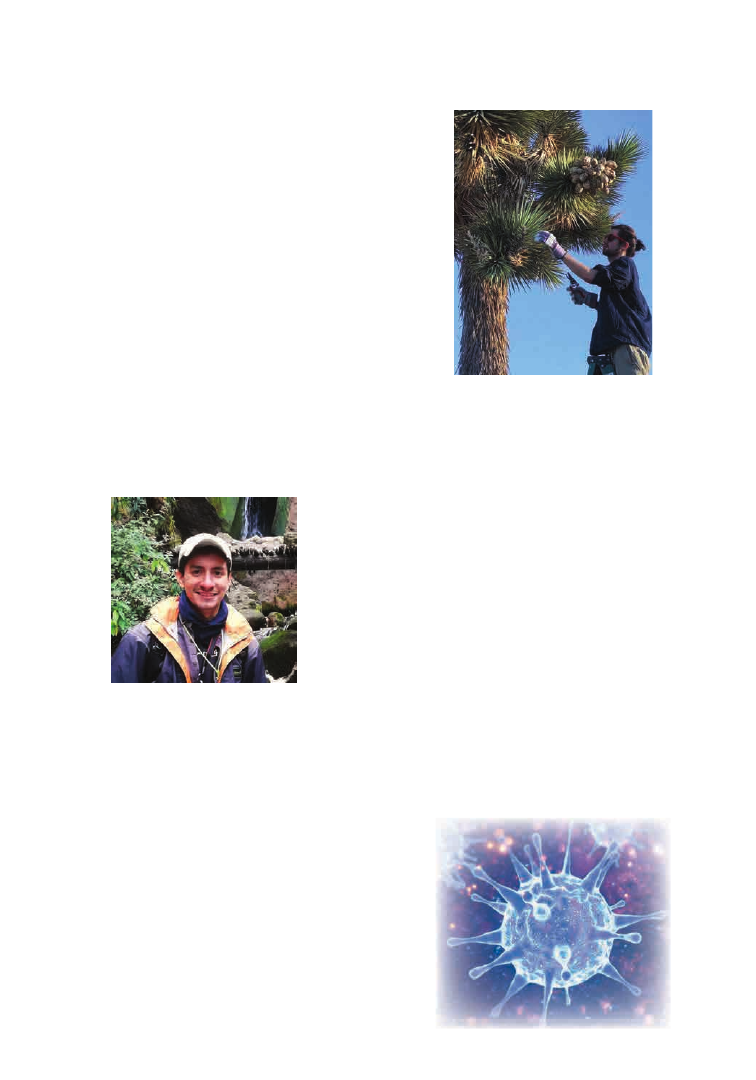
PSB 66 (3) 2020
237
more about conservation, which would have
involved the fieldwork, to more about testing
newer analytical methods with the increased
number of phylogenetic analyses. Despite
these changes, I expect to graduate within the
normal 2-year MS timeframe. Fortunately,
I am still able to use all the funds from the
grants I was awarded this winter/spring
because I didn’t budget for any travel. During
these times, it has been very important for me
to be flexible and adaptable and to maintain
open, honest communication with advisors
and peers. Every day I remind myself of the
things for which I am grateful and that I am
learning new things, even if they are not what
I expected to be learning before COVID-19.”
Diego Paredes-Burneo
Louisiana State University
“I had a trip to Peru for this past September,
but it got cancelled. Since it was a collaboration
with the New York Botanical Garden, it gets
more complicated (especially in the future)
due to this institution’s budget administration.
I am currently doing lab work, but I am doing
everything (beginning with DNA extractions)
from scratch: no one could guide me. Because
of this, my learning process has become longer
than planned."
Bryan MacNeill
University of Alabama
“I was going to start my field work in Mexico
this last summer with a single collaborator
from National Autonomous University of
Mexico (UNAM). I had to cancel my field
work completely because of travel restrictions.
However, I’ve been able to get in contact with
multiple herbarium curators and professors
at institutions across Mexico to get specimen
samples for my molecular work. Never be
afraid to “cold email” someone to ask for
help—you would be surprised how willing
people are to help! Now I have cultivated
collaborative relationships with professors
and curators from across Mexico, and look
forward to meeting with them when I
eventually get to go!”

PSB 66 (3) 2020
238
“When COVID-19 stay-at-home orders were
put in place, I had just returned home from
a conference in Georgia. I was in the stage of
preparing models for field validation during
my field season from June to August. We put
off the decision to cancel the field season as
long as possible, but lodging was continually
difficult to find, work permissions were
challenging to get, and long-distance travel
and coordinating safe logistics was consistently
risky throughout the summer. Fortunately,
this was the second year of data for my MS
project, and essentially extra data; however,
it was disappointing to miss out on a year of
fieldwork, data collection, and experiences.
Fortunately, I have been able to adapt my
project and formulate a plan for wrapping up
my thesis work mostly uninterrupted. Also,
we were fortunate to have our grant extended
for continued and ongoing work. I am grateful
for the extra time it has given me to focus
on restructuring my thesis goals, work on a
manuscript, and begin writing earlier than
I had anticipated, as well as the time to take
care of myself during these stressful times.”
BENCHWORK AND
GREENHOUSE
Allison Miller
“We developed separate standard operating
procedures, schedules, and maps to space
people out in the lab. In the field, we put
together detailed standard operating
procedures for each individual field site.
The Plant Growth Facility at my institution
constructed detailed schedules, spacing plans,
and protocols for safe greenhouse work. The
result has been that we have fewer people
working at any one time, the hours people are
working have moved to earlier and later in the
day to accommodate the most work at lower
densities, people are spaced out in different
areas of the lab/field, and everyone is wearing
masks at all times.”
Bethany Zumwalde
University of Florida
“Although my research was stunted by the
pandemic, I was able to adapt my work and
set reasonable goals to move forward. When
COVID-19 began, I had just started to collect
data for my project. When stay-at-home
Sara Johnson
University of Illinois:
Urbana-Champaign
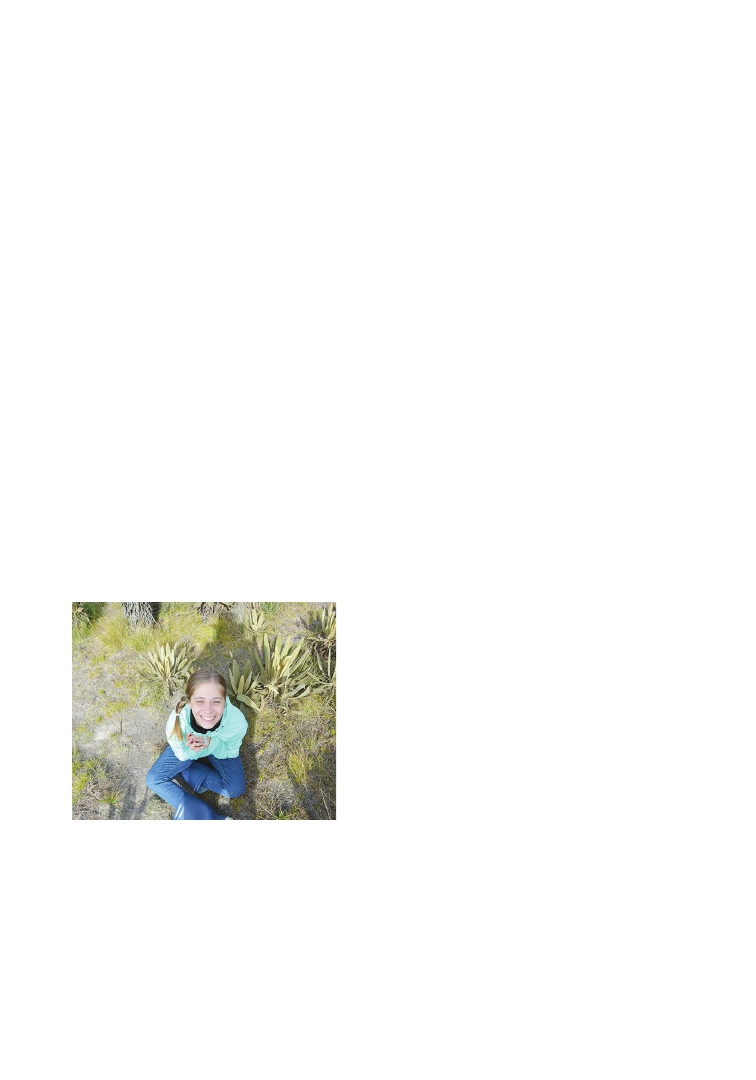
PSB 66 (3) 2020
239
mandates were implemented, I utilized that
time to work on writing grants and papers.
Access to campus became heavily restricted
and I had to quickly improvise by transforming
my small apartment into a greenhouse and lab.
My porch became jam-packed with cacti sent
from collaborators, and I was able to purchase
a cheap phase contrast microscope to set up in
my living room for chromosome counts and
epidermal peels. Fieldwork was the trickiest
part to navigate during the pandemic. I had
originally planned to recruit an undergraduate
student to assist me with fieldwork in Texas,
but this was simply not an option at that time
since most students had moved home to
quarantine. Luckily, a good friend and fellow
researcher volunteered to help me in the field.
We prioritized collecting at remote roadsides
and limited our interactions in public spaces.
Ultimately, my research was able to progress
with resourceful solutions, maintaining
reasonable expectations, and a huge amount
of help from others!”
Sarita Muñoz-Gómez
University of Antioquia
“By the time the pandemic started in Colombia,
I was in my last semester. Since we are required
to do an undergrad dissertation before we
graduate, I was just finishing my lab work
and starting my bioinformatics work, plus
writing. I was lucky because I could continue
with my work mostly from home. Sadly, we
did have to leave a few experiments out of my
dissertation, since for the first few months of
lockdown, entry to the lab was completely
restricted. Of course, all our lab meetings had
to be online, which made work a bit harder.
Only one person was permitted into the lab at
least for the first months, so he had to make
sure everything was still working. Since we
have plants in our lab, they all had to be taken
to our PI’s home to be taken care of, but our
aquatic plant (Aponogeton madagascariensis)
could not be transferred. I think my biggest
tip is to keep communicating with your lab
mates and to try to make the most of your time
at home by writing, reading, or learning new
skills. I also found a great science community
on Twitter during quarantine, so I would
suggest you join!”
MUSEUMS
Anonymous
“Before COVID-19 I was starting to
conduct lab work on the plant fossils. Due to
COVID-19, I cannot conduct the collection
visits I had planned to do at the Field Museum
in Chicago and European Collections. I also
planned using SEM to study my specimens
at the Field Museum, which is no longer
possible. Regarding collection visits, that part
of my project is no longer possible, and I have
decided to remove that aspect of my project.
Instead of conducting SEM, I am attempting
to take close up photographs on my own or
pay to have my specimens scanned at different
institutions.”

PSB 66 (3) 2020
240
MENTAL HEALTH AND
MOVING FORWARD
Tracey Simmons
“I graduated in December [2019], right
before the pandemic. This put me in a
difficult position. Because I’ve graduated,
my affiliation with the lab at my undergrad
institution is different. I would like to continue
on to a graduate degree, but the pandemic has
impacted my mental health in such a way that
I do not feel I could be successful before a
vaccine is available. I have tried to apply for
jobs, but strict protocols in my area mean
there are almost none available. I’m essentially
unable to do anything, despite wanting very
much to be working or doing research.”
Unfortunately, this is only one example of how
COVID-19 is negatively affecting students.
It should be noted that COVID-19 affects
different marginalized groups in a myriad of
ways and to be conscious that your experience
during this pandemic is not universal. We
thank those who have openly shared their
struggles with us and on social media and
shed light that we are not alone in this.
It is essential to destigmatize mental health in
academia, to create an inclusive environment,
and support those in our community
struggling with mental health. Depression
and anxiety are about two to six times more
likely in graduate students compared to the
general population (Levecque et al., 2017;
Evans et al., 2018). The pandemic has most
likely increased the prevalence of mental
health issues among students; as noted above,
it has already greatly impacted career and
research trajectories. Specifically, mental
health disorders were found to have doubled
among graduate and professional students in
2020 compared to 2019 (see Chirikov et al.,
2020). If you are currently struggling with
mental health, know that you are not alone.
We do recommend reaching out for help:
• Mental Health America, resources for
finding the right mental health care for
you: https://www.mhanational.org/find-
ing-right-mental-health-care-you
• ULifeline - mental health resources by
university: http://www.ulifeline.org/stat-
ic/must_select_a_school
• Active Minds (chapters at many univer-
sities) - resources for students: https://
www.activeminds.org/
Though we recommend seeking out a
professional to discuss your mental health,
we want to share apps designed to help with
anxiety, stress, and mindfulness:
• Shine: https://www.theshineapp.com/
º For calming anxiety and stress
• Headspace: https://www.headspace.com/
º For meditation, sleep, stress, and
mindfulness
As students, we play many roles in our
communities and have the ability to shape the
future of academia. Therefore, there are many
ways we can support our peers, mentees, and
community now and in the future. Below
we summarize just a few and provide some
relevant literature.
Support Your Peers
Mental health resources have historically
been limited. Do you know if your university
provides mental health services? Know your
options and share them with your lab mates
and peers. At the University of Florida (UF),
a Biology graduate student mental health

PSB 66 (3) 2020
241
committee reviews the graduate student
health insurance and UF options each year,
providing the rest of us a list of resources we
can take advantage of. Setting up informal
support networks is an amazing way to
support your peers.
Support Your Mentees
To briefly summarize Cooper et al. (2020),
mentors can support undergraduate
researchers with depression by:
1. recognizing students depression as a
valid illness,
2. encouraging a positive supportive
lab environment,
3. developing personal relationships,
4. treating undergraduates with re-
spect and praising them, and
5. normalizing failure.
Suggested Reading:
• Cooper, K. M., L. E. Gin, M. E. Barnes,
and S. E. Brownell. 2020. An exploratory
study of students with depression in un-
dergraduate research experiences. CBE—
Life Sciences Education 19: ar19.
• Cooper, K. M., L. E. Gin, and S. E.
Brownell. 2020. Depression as a conceal-
able stigmatized identity: what influences
whether students conceal or reveal their
depression in undergraduate research ex-
periences? International Journal of STEM
Education 7: 1-18.
Build an Inclusive Lab
As we continue in our careers, we hope to see
the academic culture shift to be healthier and
more inclusive (of mental health and more).
Evans et al. (2018) highlighted the need to
enhance access to mental health support and
cultural changes. The papers below discuss
creating environments that support the
mental health of students, post-docs, and lab
members.
Suggested Reading:
• Maestre, F. T. 2019. Ten simple rules
towards healthier research labs. PLOS
Computational Biology 15: e1006914.
• Ålund, M., N. Emery, B. J. Jarrett, K. J.
MacLeod, H. F. McCreery, N. Mamooza-
deh, J. G. Phillips, et al. 2020. Academic
ecosystems must evolve to support a
sustainable postdoc workforce. Nature
Ecology & Evolution 13: 1-5.
• Dewa, C. S., K. Nieuwenhuijsen, K. J.
Holmes‐Sullivan, A. K. Singh, and G.
Drakakaki. 2020. Introducing plant
biology graduate students to a culture of
mental well‐being. Plant Direct 4: e00211.
We hope to continue to recommend “Papers
to Read for Future Leaders” to BSA Student
members. If you have papers you would like
us to include, please share it with us via this
Google form: https://tinyurl.com/y5dp8r4m.

PSB 66 (3) 2020
242
LITERATURE CITED
Chirikov, I., K. M. Soria, B. Horgos, and D.
Jones-White. 2020. Undergraduate and Grad-
uate Students’ Mental Health During the CO-
VID-19 Pandemic. UC Berkeley: Center for
Studies in Higher Education.
Cooper, K. M., L. E. Gin, M. E. Barnes, and
S. E. Brownell. 2020. An exploratory study
of students with depression in undergradu-
ate research experiences. CBE—Life Sciences
Education. 19: ar19.
Evans, T. M., L. Bira, J. B. Gastelum, L. T.
Weiss, and N. L. Vanderford. 2018. Evidence
for a mental health crisis in graduate educa-
tion. Nature Biotechnology 36: 282.
Levecque, K., F. Anseel, A. De Beuckelaer, J.
Van der Heyden, and L. Gisle. 2017. Research
Policy. 46: 868–879.
Vandebroek, I., A. Pieroni, J. R. Stepp, N.
Hanazaki, A. Ladio, R. R. N. Alves, D. Pick-
ing, et al. 2020. Reshaping the future of eth-
nobiology research after the COVID-19 pan-
demic. Nature Plants 6: 723–730.
Weng, J.-K. 2020. Plant solutions for the CO-
VID-19 pandemic and beyond: Historical re-
flections and future perspectives. Molecular
Plant 13: 803-807.

PSB 66 (3) 2020
243
Hi again everyone—this is your former BSA student
rep, Minya. I hope you’re staying safe and healthy, and
taking good care of your physical and mental health.
Back in 2019, Shelly and I decided to do a fieldwork-
related student section for the Plant Science Bulletin
to help everyone prepare for all the fieldwork that was
supposed to happen in 2020. But then, as we know,
COVID changed our world and we had to postpone the
fieldwork issue. Now, as we are trying our best to improve
the current situation, we are happy to finally publish the
essay that we invited Dr. Kadeem Gilbert to write.
When I was trying to find a friend who has a lot of
fieldwork-related insights to share, Kadeem came to my
mind immediately. Surely, Kadeem has done fieldwork
many times, particularly in Southeast Asia, but I also
believed that we can learn so much more from him
besides the logistics of how to do fieldwork. He travels
around the globe not just to study the pitcher plants in
different places, but his curiosity about the histories and
the cultures of the regions are also infectious. He embraces
different cultures fully, learns the languages (he speaks six
languages!), becomes a strong advocate for them back in
the U.S., and shows the beauty of them to everyone.
This fieldwork essay comprised two parts. In the first
part, Kadeem gave some practical tips and guides for
students who plan to do fieldwork. In the second part,
Kadeem told us a vivid and thrilling story during one of
his fieldworks that made even him have the thought of “I
will stop doing tropical fieldwork.”
Enjoy!
Getting Started in
Tropical Field Research
By Dr. Kadeem Gilbert
USDA-NIFA
Postdoctoral Research Fellow
Pennsylvania State University,
University Park, PA
E-mail: kjg5649@psu.edu
I have about a decade of experience doing
tropical fieldwork, which began with in 2010
as an undergraduate. It is now 2020 (I find it
hard to believe), and in the past year I finished
grad school and started a postdoctoral
fellowship. Despite not being exceptionally
outdoorsy as a child—I grew up in a fairly
urban part of New Jersey and spent far more
time reading about biology than I did actually
going outside—I had always fantasized
about going to distant countries to explore
tropical ecosystems. How does one actually
get started doing tropical fieldwork as part of
their career? If you’re an undergrad and like
me didn’t do much camping as a kid, I would
recommend gaining some field experience
(any field experience) as soon as possible to
determine whether fieldwork is truly for you
before fully committing to it as a career.
The idea of fieldwork may sound exciting and
glamorous in the abstract, but there are many
difficulties involved: strenuous climbs, hot and
muggy temperatures, torrential downpours,
and biting mosquitoes. There are many great
programs out there that offer experiences in
tropical field biology for undergraduates,
including Operation Wallacea and the
Organization for Tropical Field Studies (OTS).
It is a great idea to apply for programs
like these if you think you may want to
do a lot of field research in your career,
whether in or outside of academia.
To get my feet wet as a junior, I did
both an NSF REU (National Science
Foundation Research Experiences
for Undergraduates) program based
in Indonesia, as well as a Drexel-run

PSB 66 (3) 2020
244
study abroad program, which is open to
students from all universities and incorporates
field research in addition to classes, in
Equatorial Guinea. In my case, this was after
I got acquainted with doing local temperate
fieldwork.
The best way to do fieldwork as a graduate
student is to apply to work with an advisor
who has experience doing fieldwork in the
specific country you are interested in. Know
that the exact process for getting all of the
necessary permits to do research in a foreign
country depends on the country, and it can be
quite long and arduous—for some countries
moreso than others. So, if you have a specific
country in mind, it’s definitely to your
advantage to keep that in consideration and
factor it into your application process if you’re
currently thinking about applying to grad
school. If you’re already a grad student and it’s
not the case that you’re working with someone
who has an active research program in your
specific country of interest, your advisor
can at least help you find another researcher
to connect with who knows the specifics of
your target country. It may also be important
to keep an open mind and be flexible about
where to work. I went into graduate school
strongly desiring to work in Indonesia, but I
ended up doing projects in Singapore and the
Philippines instead because it was easier to get
permits to do the work that I wanted (I work
on Southeast Asian pitcher plants) in a more
convenient time frame.
All in all, my major tips for fieldwork
(especially tropical fieldwork abroad) boils
down to having a network of people to support
you:
• Make connections with researchers al-
ready working in your region of interest;
they can help you with the specifics of the
permit application process. It may also be
possible to initiate your fieldwork more
immediately by getting added to their
existing permit and joining an upcoming
expedition they’ve planned.
• The longer or more remote the expedi-
tion, the more important it is to have a
team of people with you, including expe-
rienced fieldworkers who understand all
of the logistics.
• The most successful field expeditions will
include local guides on the team; they
know the land better than any visitor
could ever hope to, and they are the most
prepared to respond to any emergencies
that result from run-ins with dangerous
flora or fauna. The cultural exchange that
comes from interacting with local people
is also one component that makes field-
work enjoyable and exciting. You might
consider learning the local language to
enhance this experience.
• Always be prepared for challenges at
every step. This can refer to the research
itself (you might sadly find that forces
beyond your control impede data collec-
tion, maybe you get to your site and find
out that a drought has caused your plants
to dry up and die), but it also applies even
more to personal safety. Be mindful of
your steps (literally) when climbing pre-
carious slopes or walking through thick
vegetation. Wear long sleeves and pants
to protect your skin from insect bites
and spiny vegetation, and make sure it’s
a breathable quick-dry material. A wide-
brimmed hat can protect you from the
oppressive heat of the equatorial sun, and
wearing a bandana is useful for keeping
sweat out of your eyes.
• Keep a resolved constitution in the face of
an emergency.

PSB 66 (3) 2020
245
I initially wanted to talk about my fieldwork
experience overall to expound upon some of
these points above. I wanted to give a brief
summary of an incident in 2014 to illustrate
the principle of keeping a resolved constitution
in the face of an emergency, but once I began
writing, I felt compelled to go into more detail
about the experience—a story that I have
recounted many times to friends in person,
yet up until now neglected to write down (I
lament my constant failure to keep a journal).
I decided to write out this entire narrative. I
will preface this by saying that I don’t want to
scare anyone out of doing fieldwork, but this is
a tale of extreme danger and fear. It recounts
a life-threatening event that did make me
reconsider continuing to do fieldwork, but
it did not stop me. It also, I believe, touches
upon how some of the points above can keep
you safe and secure in the field. I hope you
enjoy.
FIELDWORK:
BOTH PLEASURE AND PAIN
It is June of 2014, and I am in a small clinic in
a small town almost in the middle of nowhere
in the southern tip of the island of Luzon, the
Philippines. My entire body is in pain like
I’ve never felt before (or since). It’s difficult to
even describe how intense it was at the time; I
think my brain refuses to let me remember the
full extent of the sensation. It was as if jolts of
lightning were electrocuting my muscles, and
I could barely move. How did I get here? Just a
few hours ago, I actually was in the middle of
nowhere, up on a ridge of a caldera on Mount
Bulusan. My expedition team had hiked up
something like 8 or 10 hours to get up to
the point where we pitched our tents, in the
flat crater surrounded by ridges on all sides,
towering in a 360-degree panoramic view.
(How surprised I was to still see such sharp
relief in the landscape at that point, after all
we had already scaled.) The site was absolutely
breathtaking—some of the most gorgeous,
awe-inspiring, unspoiled tropical forest that
I’ve had the pleasure of seeing (and fortunately
I’ve experienced a few such places both before
and afterwards).
When we had arrived at part of the caldera,
it was late afternoon and we had time to rest
and plan for the morning. You see, this was
meant to be our home base for a few days, but
not the final point—there was more climbing
to do to find what I wanted. I mentioned I was
with other researchers, but our goals were not
the same. We (me, two other scientists, and
our local field guides) had already broken
apart from the larger group we had arrived at
Bulusan with; the rest of the group remained
at a lower elevation site. I was then going to
break off from the other two scientists the next
morning to work in a different part of the site
(though of course the plan was for us to meet
back up at the home base each evening for
the 3 to 4 days we planned to be there). These
two invertebrate zoologists quickly identified
which of the surrounding slopes they would
use to search for ants and harvestmen. I was
actually kind of tagging along on this big
expedition made up mostly of entomologists,
and I as a fairly early grad student was just
scouting the site as a possible new project site.
I was looking for Nepenthes, and I asked one
of the guides where I might find some of the
plants (I pointed to photos in my Field Guide to
the Pitcher Plants of the Philippines). Whereas
the invertebrate zoologists had decided on a
relatively flat slope to the left of where we were
facing, the guide pointed to a slope on the
exact opposite side—it looked almost vertical
in its ascent. He said that they (some other
park rangers were already stationed up here in

PSB 66 (3) 2020
246
addition to the ones who climbed up with us)
had just started cutting a trail up that section
recently, and it might be a bit dangerous
because the potential trail is still nonexistent
and the slope is thickly covered in spiny rattan
(Calamoideae). However, they caught sight
of some Nepenthes during their initial bush-
whacking. He asked if that’s the spot I wanted
to climb in the morning, even though it might
be a bit dangerous, and I, keen to find my
plants, thought about it seriously for a few
seconds and answered, “Yes, definitely”. I did
not know it, but the next day I would end up
at the clinic.
With our respective plans in place, we rested
that evening and did a little exploring of our
immediate surroundings. I tracked the sound
of a calling frog and located him (possibly a
Platymantis) calling from his perch in a water-
filled Pandanus leaf axil. On that same plant, I
found a crab nestled in the furrow of another
leaf—quite interesting to find a crab so far
from the sea! I wondered if that species was
fully terrestrial like the neotropical bromeliad
crab; it would make sense, considering that
the pockets of water in Pandanus definitely
host frogs as bromeliads do. I am all about
studying the tiny ecosystems in plant-held
waters (phytotelmata), which is the main
thrust of what I continue to focus on with
Nepenthes.
Anyway, I realize I probably have held you
readers in suspense for too long. First thing
in the morning, the other two scientists and
a couple guides headed to their slope, and I
with one guide headed up mine. It was not
the anticipated dangers that brought me
to the hospital: the steepness didn’t end up
bothering me that much, and my long sleeves
and pants protected me from the rattan spines
(I even had on thick work gloves, as suggested
by my guide). My point in telling this story
is that there is always a risk of unexpected
incidents in fieldwork like this; I had accepted
that risk by choosing to do tropical fieldwork,
but experiencing a real emergency actually
solidified my perception that the risks are
worth it. Today, I do not regret making the
decision to climb up that slope, even though it
was the singular event when I most feared for
my life. My climb that morning was cut short
by a vicious bee attack. It came unprovoked,
without warning; I never even saw their nest.
We had climbed maybe only about an hour
and had just gotten to a relatively flat point
and took a brief pause, when the first one
suddenly appeared flying toward me and
bombarded me in the forehead.
I turned to my guide who was behind me at
the moment to say, “I think I just got stung!?!”
(with a tone of puzzlement), but in that very
instant the rest of her swarm descended down
upon us. Puzzlement then instantly became
pure terror as bees entirely covered my view.
There were literally hundreds of them (a
conservative estimate) and dozens of them
(again, a conservative estimate) proceeded to
sting me all over my face and head throughout
the course of this attack. I could smell the
astringent scent of their pheromones as the
stings continued. The sound of their loud
buzzing filled the air (to this day, any buzzing
sound can make my heart skip a beat), and at
one point I felt one actually crawl into my ear.
From the start of this attack, the guide shouted
that we have to get down and urged me to
move quickly, but after being stung several
times that very first minute—they came one
after the other—my body immediately felt
weak. Numb is not the right word, as I felt
the intense bodily pain, but I mean I was
numb in that it became hard to lift my limbs.
On top of that it was a very steep descent and
gravity could overtake me even if I were in full

PSB 66 (3) 2020
247
control of my limbs. Furthermore, I could not
see where I was going due to my efforts to keep
the bees away from my eyes at least (I swung
my bandana in front of my face and angled
my head down), but on top of that there was
no trail to even see—it was thick vegetation all
around.
We were both getting stung, but I was
apparently bearing the brunt of the attack as I
was the larger target and less able to navigate
away. Also, I had never been stung before
in my life—I didn’t truly know that I wasn’t
allergic. I owe my life to several brave guides
who worked together to get me to safety. The
one guide with me on the slope at this time
got on his walky-talky to call up some more
who were at the base camp. They helped
me get back down to the tents as quickly as
possible. The bees continued to sting me until
we made it back to the tents, after maybe 30
minutes that felt like an eternity. (Adding to
the puzzlement of this unprovoked attack:
if they were defending a hive, why continue
attacking me long after moving away from
the place that it started?) A couple of guides
lay me down in a hammock and pulled the
stingers out of my face and head. I said, “I
think I may need to go to a hospital”; I could
barely even move a finger and my entire body
was on fire with pain. Also, I could not hear
out of my right ear since there was a bee
lodged in it. I told the guides about the bee
in my ear, but they couldn’t see it and said I
might be mistaken—maybe the hearing loss
was an effect of all that venom.
Using the hammock as a stretcher, a cadre
of guides carried me down all the way to the
base of the mountain (in apparently a fraction
of the time that it took us to climb up, since
the sun had not yet set when I left the hospital)
and down further to the nearest road out here
in the middle of nowhere. I’m not sure, but
I think it was luck that eventually a vehicle
passed by, and eventually one with the capacity
to take me in as a passenger. (It was one of
those motorcycles with an attachment in the
back—not a comfortable ride, but thankfully
I did not throw up again as I did going down
the mountain).
So, to return to where I began the story: the
doctor gave me an antihistamine shot at
the clinic and said that my swelling should
subside and that I’d recover in a few days. I
asked if she could remove the bee from my ear.
Puzzled, she looked in with an otoscope and
didn’t see anything at first (it must have been
deep in there), but then succeeded getting
that dead Apis dorsata breviligula worker
out with forceps. We were all shocked to see
just how large the insect was—it was difficult
to imagine how it could fit in my ear. I kept
the specimen in a vial of ethanol and carried
it around with me throughout the rest of the
trip like a trophy. I initially intended to bring
it back to America with me to keep it always
as a memento, but I ended up donating it to
science when I ran into a bee taxonomist in
Singapore who, after IDing the species for me,
stated that he was working on doing a species
delimitation for the Apis dorsata complex (he
suggested that several subspecies might need
to be elevated to species status) and asked me
if he could keep the specimen.
This might all sound like an unimaginable
nightmare to you, reader, and it certainly was
to me at the time. However, my point is not
to dissuade anyone from fieldwork; it did not
discourage me. While I was being attacked, I
honestly thought I was going to die and felt
fear like I never felt before or since. One of
the many thoughts that flashed in my head
was that if I got out of this situation, I would

PSB 66 (3) 2020
248
never decide to do fieldwork again. While I
was being carried down the mountain in the
hammock-stretcher, I amended this thought
to, “I will stop doing tropical fieldwork.” Laying
on the actual stretcher in the clinic, I thought,
“I’ll never do fieldwork in a really remote site
again, but I want to continue doing tropical
fieldwork.” I felt unable to climb back up
Bulusan to complete the plan of staying at the
caldera site for the remainder of the week—
the attack happened on the first morning at
the caldera, and sadly I didn’t even see any
pitcher plants on that slope—but I chose not
to leave the Philippines.
After recovering for 2 or 3 days, I was flying
over to the next island that my main expedition
team had planned visiting, and I happily (if
slightly apprehensively) climbed yet another
remote mountain. I am actually not a “thrill-
seeker-type.” Despite such adventures, I
don’t see myself as an Indiana Jones rushing
headlong into danger. I’m just so fascinated by
the natural world and so love every moment
of being out in the wilderness that it drives
me to take these calculated risks. Even the
negative experiences are worth the chance to
experience nature’s grandeur, which is truly
awesome in the classical sense of the word. The
good and the bad, the pleasure and the pain,
are two sides of the same coin that imparts
upon me the intense, ineffable emotion that
can only come from Nature. Nature to me
is like living art, and while fieldwork has
inspired me to write stanzas like “Only the
cleansing/Rays of the sun upon me/Can distill
my pain,” it has inspired many more stanzas
of pure awe and wonder like “The mountains
exhale/Ethereal white breath spews/Forests
join with sky” or “Countless insects scream/In
polyphonic chorus/Wondrous night music.”
All in all, I sincerely hope that any student
reading this with the passion to do so gets to
experience amazing fieldwork like I have—
and stay safe!

PSB 66 (3) 2020
249
FROM THE
PSB
ARCHIVES
60 years ago
Wilson Stewart discusses recent controversies in paleobotany:
“For the past five years I have become increasingly perplexed by the frequency of articles supporting the
claim that vascular plants with lycopsid affinities occurred in the Cambrian. If the evidence justified the
conclusion, then this would be one of the most spectacular paleobotanical finds since Lang and Cookson’s
(1935) discovery of bona fide vascular plants in the Silurian rocks of Australia.”
--Stewart, Wilson N. “More About the Origin of Vascular Plants” PSB 6(5): 1-5.
50 years ago
“
Harlan Banks presents the Address of the Retiring President of the Botanical Society of America, pre-
sented at the Society’s annual banquet, August 26. 1970, at Bloomington, Indiana.
“Yes, I visualize the day when we’ll know many Devonian plants as plants rather than as isolated organs,
when we’ll be able to speak intelligently about habitats and associations, when we’ll know the length of
time that was required to evolve new species, and the algae from which vascular plants did evolve. I think
we’ll learn whether the origin of vascular tissue was related to the origin of metabolic pathways for the
manufacture of lignin (perhaps in the Silurian). I think we’ll know much more about the possible role of
O2 concentration in the atmosphere, its role in the formation of ozone, and their role in shielding Earth’s
surface from lethal ultra-violet radiation, thus permitting the occupation of dry land. And of course I’ll
be watching for confirmation of my wildest statement, actually a primitive attempt at precision, that all
the phylogenetically important innovations among vascular plants are found during the 50-million-year
adaptive radiation of land plants that occurred in the Devonian Period. Ted Delevoryas has picked me
up on this one and allowed as how all the evolution after Devonian time was just ‘frosting on the cake.’”
--Banks, H. P. ”Chipping Away at Early Land Plants: Of People, Places, and Perturbations” PSB 16(4): 1-6.
40 years ago
Paul B. Conant, President of Triarch, Inc., a supplier of microscope slides since 1926, has asked that
members of the Botanical Society write to him to assist in the decisions relating to the continuation of the
firm. The squeeze between rising costs and reduced educational budgets has placed the company in the
position where it is unable to meet increased salary requirements. Mr. Conant would like to hear from
members as to their needs for prepared slides in years to come and other information on the problems
associated with Triarch.
--HELP!. PSB 26(4): 29.

250
ANNOUNCEMENTS
In Memoriam
BRIAN JOSEPH AXSMITH
(1963–2020)
It is with great sadness that we share that our
friend and colleague Brian Joseph Axsmith,
57, of Mobile, AL, passed away on May 5,
2020. Brian contracted the COVID-19 virus
and in combination with other health issues
succumbed to its virulence. His battle with the
virus was brief but valiant.
Brian was born in Pottstown, PA on June
3, 1963. He was the son of the late Joseph
J. Axsmith. He is survived by his mother
Kathryn Boyer Axsmith; son Jeffrey Tristan
Axsmith, who often visited while he worked;
his companion and loving wife Jennifer; and
sister Doreen Axsmith Inmon, with whom he
remained close.
Brian describes his early school years as a time
when he was not an especially good student.
But his curiosity about nature drove him to
places where he collected snakes and frogs,
but in a limited number because his mother
was not particularly fond of having to share
space with these creatures in her house. His
interest in fossils and collecting them began
at an early age. As is somewhat typical of kids,
the captivation of dinosaurs and their ancient
remains fueled his imagination and no doubt
had some bearing on his interests in studying
the ancient remains of the Earth. At this point,
he had little interest in the fossil remains of
plants, but it is apparent by his life’s work
that his choice to focus on these important
organisms became far greater than he could
have possibly imagined.
Brian graduated high school (St. Pius X,
Pottstown, PA) in 1980, and from there moved
on to Millersville University of Pennsylvania
in Millersville, PA. One of his professors at
Millersville University, where Brian developed
a curiosity for fossil plants, became his
mentor. In fact, he published his first paper
before even contemplating graduate school,
describing Triassic fossil plants from the
Stockton Formation in Pennsylvania with his
good friend Peter Kroehler (who now works
on fossils at the Smithsonian Institution in
Washington, DC). His botany classes with
Millersville professors Dr. David Dobbins and
the late Dr. James Parks played a key role in
his interest in living plants.
His early educational experiences at
Millersville University, Pennsylvania, where
he received his Bachelor of Science degree, no
doubt set a course for his continued interest
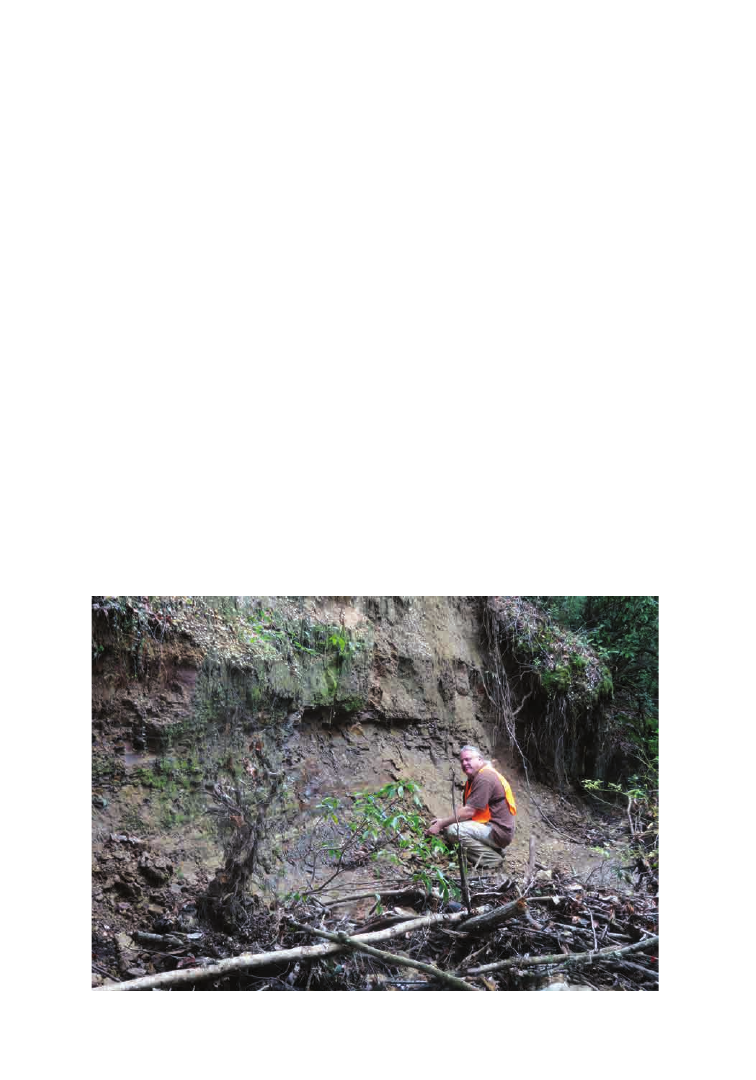
PSB 66 (3) 2020
251
in biological sciences, a direction that would
steer him toward paleobotany. This love of
paleobotany subsequently guided him to The
Ohio State University, where he would begin
his pursuit of a doctoral degree under the
guidance of Thomas N. Taylor. Apparently one
of the reasons that Taylor accepted him into
his lab was something Brian often related in
a post-graduation story about a conversation
between Tom and Brian’s father. It went
something like this:
Joseph Axsmith: What did you see in Brian to
accept him into your lab?
Tom Taylor: His intense work ethic—he is a
hard-working S.O.B.
His time at The Ohio State University was
cut short and a sudden change of venue sent
him to the University of Kansas, where he
completed the requirements for his degree. In
1998 his status officially changed to Dr. Brian
Axsmith, a title he achieved with honors. After
a short post-doc, Brian secured a position
as an assistant professor at the University of
Southern Alabama in Mobile in 1999 and
rapidly rose through the ranks to become full
professor.
Over the next 20 years, he built an impressive
academic career in which he played many roles
within his department and the university. He
was a committee member for multiple M.S.
students in both the Biology Department
at University of South Alabama and at the
University of Mobile. He served as chairperson
to three graduate students (Debra Stults, M.S.,
2003, and Ph.D., 2011; Elizabeth Creen, M.S.,
2006; and Patrick McAnerny, M.S., 2019)
who completed projects focusing on various
paleobotanical questions. Additionally, he
provided guidance and mentorship to at
least 10 undergraduate students involved in
numerous paleobotanical topics. He also had
the opportunity of hosting a post-doctoral
Axsmith collecting near Monroeville, AL.

PSB 66 (3) 2020
252
palynologist from Nepal (Farhat Iqbal) in
which they explored Mesozoic and Neogene
localities. His work with colleagues from
the U.S., South America, Europe, and China
produced several significant publications,
which are cited frequently.
Early in his career (1990), Brian received the
Outstanding Biology Student Award from the
Commonwealth of Pennsylvania University
Biologists, which is given to a student who
best exemplified scientific scholarship and
achievement. This extraordinary honor
of distinction is given to one student. The
award represents the qualities and knowledge
possessed by students who attend the State
System of Higher Education Universities. In
1993 he received the prestigious Isabel Cookson
Award, presented by the Paleobotanical
Section of the Botanical Society of America.
This award is given to the student who delivers
the best contributed paper in paleobotany or
palynology at the Society’s annual meeting. In
2003 he received the Arts & Sciences Junior
Faculty Award for Excellence in Scholarship
and Academic Achievement. His many
accomplishments were further recognized
by the national honor society Mortar Board,
which is made up of college seniors from
around the country. Mortar Board members
select outstanding educators for their devotion
to academia, teaching style, accessibility,
knowledge of their subject, and other special
qualities unique to the educator. He received
this honor in 2007, 2009, 2013, and 2014. In
the 2014–2015 academic year, Brian received
the Dean’s Lecture Award, which is presented
for excellent scholarship or academic
achievement throughout the faculty member’s
career. It was also at this time that he received
the Olivia Rambo McGothern Outstanding
Scholar Award, given by the USA National
Alumni Association for excellence and high
achievement in an academic discipline.
His academic activities were just a part of what
made Brian tick. He enjoyed participating in
various activities in and around the Mobile
area. He also loved to get others involved in the
collecting of fossils, be it students, interested
local collectors, or local groups of teachers or
geologists. His passion for his research and
studies was reflected by the crowds he drew
and his popularity among students. He was
gifted with a talent for explanation and often
could accept a sudden request for presentation
without much preparation because he could
develop the topic “on the fly.” He became
involved in the Evolution vs. Creationism
debates presented on campus, which were also
open to the public. He adeptly presented the
facts and handily countered the opposition
so much so that he was asked to serve in this
capacity several years in a row.
At all times Brian was on the lookout for
new and previously discovered sites with
fossil floras. His early research centered on
Mesozoic floras and included those from
multiple continents including Antarctica,
Asia (northeastern China), and North
America (Chinle Formation and Newark
Supergroup). When he moved to Alabama,
he became involved with one of the floras
that Edward Berry had worked on during the
early 20
th
century. This “rediscovery” began
a two-decade revival of the Citronelle Flora
(late Pliocene). He continued collecting and
working on other localities including eastern
North American Cenozoic floras extending
from the Oligocene and into the lower
Pliocene. He was particularly interested in
these areas due to the lack of a good published
fossil record for the region. His interests
extended into the Pleistocene flora along
the Mobile River. These floras are currently
awaiting further investigation.

PSB 66 (3) 2020
253
By now his reputation and the fact that he was
local (now from Alabama) opened additional
doors for research, which included the Ingersoll
Shale flora (Cretaceous). With the help of
Mississippi paleontologist George Phillips and
Mississippi geologist James Starnes, he was
able to acquire local material, and Mac Alford
from the University of Southern Mississippi
helped with the acquisition of material from
middle Miocene Hattiesburg Formation.
Brian’s love of paleobotany and the many
rewards that came with it provided
opportunities for him to discover the treasures
of past life. His love for fieldwork, whenever
and wherever the opportunity arose, never
wavered and his enthusiasm for removing
tons of rock, which, on some occasions would
reward him with a bounty of fossil plants or
teach him the value of wearing gloves and
digging in the right place, remained ever
present. Working in the field with a diverse
group of prominent or amateur collectors gave
Brian a great sense of paleontological history
and of those who contributed to it and to new
types of collection techniques. The values of
hard work and observation were subsequently
passed on to his colleagues and students
alike. He knew the benefits of teaching,
especially when the facts were presented in
an understandable and unbiased way. To keep
science simple and interesting meant that he
could reach a larger group of people where the
benefits would be far reaching. His research
and professional career allowed him to travel
the world collecting material, from the back
roads of Alabama to the remote wilderness of
China. The collection of material, especially
from the Mobile area, allowed him to publish
numerous scientific papers representing his
ideas and interpretations on various groups
of fossil plants. Some of these papers will
ultimately stand the test of time; others may not
Note: A special fund has been set up
in honor of Brian by the University of
Southern Alabama. All contributions will
be used to support the Brian Axsmith
Memorial Scholarship in Biology: https://
giving.southalabama.edu/axsmith.
be so lucky. At times, his research challenged
the ideas of his colleagues, which he thought
was necessary to keep the field of paleobotany
moving forward. His academic contributions
will remain etched in stone, which ultimately
show a legacy of career success through hard
work and commitment.
Brian represented the best within us, and he
knew that hard work and perseverance would
ultimately provide rewards that few people
could ever achieve. His role as a husband,
father, scientist, colleague, and friend will
forever be remembered and occupy a place in
our hearts where it will live on. He will be most
dearly missed by his wife Jennifer and son
Jeffrey and by those who had the opportunity
to cross paths with him. His kindness and witty
humor will remind us that life is a precious gift
that allows us a fleeting moment to pursue our
dreams and to make the world a better place.
For the short time that Brian was with us, he
earned the trust, respect, and friendship of
countless individuals from many walks of life.
As we go forward, let us remember to use his
many contributions and examples as a guide
to enrich our own lives and the lives of others
we know. May our friend rest in eternal peace
and never be forgotten.
--Rudolph Serbet, University of Kansas, and
Debra Stults, University of Southern Alabama

254
MEMBERSHIP NEWS
By
Amelia Neely
BSA Membership
& Communications
Manager
E-mail: ANeely@</a>
botany.org
BSA is proud to provide over $125,000 in
awards and grants to our members every
year. Most of these are funded directly by
the generosity of our members via donations
to specific award funds. Professional
members are also given the opportunity of
increasing their annual dues by $25 in order
to support the Graduate Student Research
Award fund. We are pleased to say that over
60% of our Professional members opted in
to support the GSRA in this way, allowing
for over $24,400 in additional funds for
the GSRA in the last fiscal year. Thank you!
We hope that you will consider making
a donation to our many funds including
student, professional, and sectional award
funding when you renew your membership
this year. You can also visit botany.org
and click Donate to start giving.
YEAR-END GIVING
THIS IS THE SEASON OF
GIVING
GIFT MEMBERSHIPS!
Do you know a student or developing
nations colleague that would benefit from
being part of the BSA community? BSA
offers gift memberships for these two
membership types for only $10 each! You
can purchase gift memberships during
your renewal process or go to www.botany.
org, click on Membership on the top
menu, and then click Gift Memberships.
We are giving back! Any gift membership
recipient who starts their membership before
January 31, 2021 will be entered into a drawing
for a free registration for Botany 2021!
Got questions about your membership?
Email Amelia Neely at aneely@botany.org.
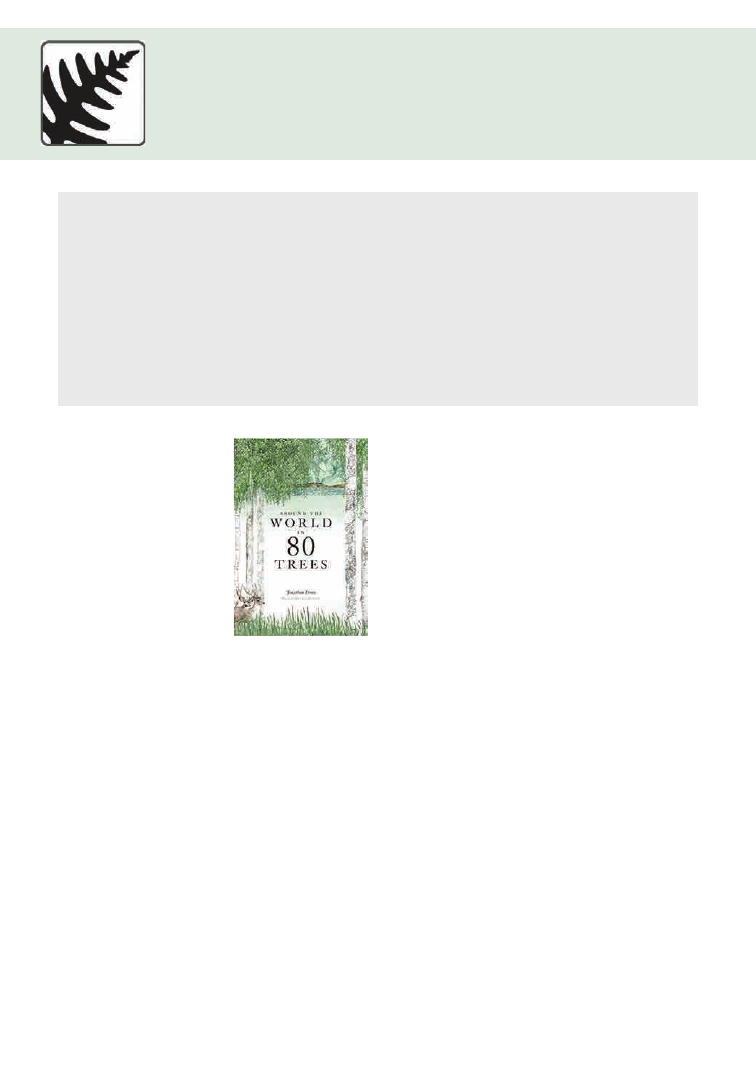
255
Around the World in 80 Trees
Fruit from the Sands: The Silk Road Origins of the Foods We Eat
Green Growth That Works: Natural Capital Policy and Finance Mechanisms
Around the World
Plant Anatomy: A Concept-Based Approach to the Structure of Seed Plants
Plant Names: A Guide to Botanical Nomenclature, Fourth Edition
Trees, Shrubs, and Woody Vines in Kansas (revised and expanded edition)
Vanishing Beauty, Native Costa Rican Orchids
Wild Plants for a Sustainable Future: Multipurpose Species
BOOK REVIEWS
Around the World in 80
Trees
Jonathan Drori; illustrations
by Lucille Clerc
First published 2018. Paper-
back first edition 2020. ISBN
9781786271617 hardcover;
978-1-78627-606-3, paper
Hard cover, $24.99; paper,
$19.99; Kindle $16.25;
£12.99; 240 pp.
Laurence King Publishing
Ltd., London.
Adapting Jules Verne’s title of Around the
World in Eighty Days, Jonathan Drori’s
fantastic adventure—his metaphorical
circumnavigation—introduces reader to
a selection of trees that are prominent
to the cultures of each named country,
organized geographically: Northern Europe,
Southern Europe and North Africa, eastern
Mediterranean, Africa, Central and South
Asia, East Asia, South East Asia, Oceania,
South America, Mexico, Central America and
Caribbean, North America.
What a winning combination! The stunning
illustrations by Lucille Clerc illuminate the
rich text by Drori about iconic trees, from
the mundane, Brooklyn’s Tree of Heaven
(Ailanthus altissima), to Missouri’s majestic
Black Walnut (Juglans nigra). Trees as diverse
as the bulky long-lived, fruitful Baobab
(Adansonia digitata), are juxtaposed with
delicate domatia-bearing whistling thorn
(Vachellia drepanolobium), featured together
in this compact volume, packed with botanical
details.
Drori’s writing is dense with facts and
entertains on each page. Every tree
biography is filled with dynamic writing (e.g.,
Pomegranate: “The turgid grains interlock
satisfyingly with one another—a triumph of
efficient packing” and “Perhaps we shouldn’t
dismiss the psychological benefits of a fruit
whose consumption requires our undivided
attention”). Sir Jonathan’s endeavors earned
him the prestigious award in December
2006—Commander of the Order of the British
Empire (CBE), the highest-ranking Order
of the British Empire award—rewarding
contributions to the arts and sciences, work
with charitable and welfare organizations,
and public service outside the civil service.

PSB 66 (3) 2020
256
Drori brings decades of expertise to Trees,
as a BBC Executive Producer and Director,
responsible for more than 50 popular BBC
science and technology documentaries and
series. He prepares short films for plant-
and seed-collecting expeditions and is also
known for several TED talks on pollen, seeds,
and flowers that have been viewed more
than 3 million times. He is Trustee of The
Eden Project, a member of the Council of
Ambassadors of the World Wildlife Fund, and
a former trustee of The Woodland Trust and the
Royal Botanic Gardens, Kew. He is Chairman
of Ravensbourne University London, a Fellow
of the Linnean Society and the Zoological
Society of London, a full voting member of
British Academy of Film and Television Arts,
and a Visiting Professor at Bristol University,
specializing in science
misconceptions.
Clerc is a meticulous illustrator with seasoned
artistic ability strengthened by intelligence
that informs every stroke she places, applying
subdued browns and green colors.
She
works within the field of editorial design and
illustration and produces most of her work
using hand-drawn images, with considerable
attention to detail.
She is also well known
for her influential graphics of broken pencils
following the Charlie Hebdo attack.
Together,
Drori’s essays and Clerc’s sketches present a
visually rewarding travelogue crammed with
botanical and cultural information.
Associations of animals with the trees that
support them are also featured, e.g., the
mopane worm intrinsic to Colophospermum
mopane, a large caterpillar in the Emperor
moth lifecycle that feeds primarily on
mopane tree leaves and is a popular snack
in Namibia and Zimbabwe, which is a food
staple in rural areas and regarded as a highly
nutritious delicacy. Goats graze fruit and
leaves in Morocco’s Argan trees, Argania
spinosa, oblivious to their thorns. Thereafter,
the
goats excrete or spit out the nuts of argan
fruits, which can later be retrieved from the
goats’ manure, for processing into a precious
edible oil, which is also utilized in expensive
cosmetics.
The book opens with the English London
Plane, Platanus acerifolia, “a tree of pomp
and circumstance,” first planted in Berkeley
Square, Mayfair, in 1789. A hybrid of the
American sycamore and the Oriental plane,
it has been adopted by urban planners
worldwide; in fact, it’s the most common
street tree in New York City. India’s sacred
Banyan tree, Ficus benghalensis, revered in
temples, offers sanctuary and inspiration;
Berlin’s best-known boulevard, Unter den
Linden, is named after Tilia europaea with its
intoxicating, sweetest, most powerful perfume
known to the plant kingdom.
This book’s paper cover is heavy, thus durable;
the book is well bound and stitched, and the
pages are sturdy to withstand being thumbed
through often. The script, which reads like a
love letter to Mother Earth, should be required
reading in biology classes, introducing a
semester’s worth of environmental science
study in delightful form. I am completely
won over by this collaboration. It may seem
unusual to gush over visual aids in a reader
about trees, but this beautiful volume is a
page-turner, propelling readers forward with
imaginative drawings of each tree, and its
folklore and uses.
–Dorothea Bedigian, Research Associate, Mis-
souri Botanical Garden, St. Louis, Missouri,
USA

PSB 66 (3) 2020
257
Fruit from the Sands:
The Silk Road Origins of
the Foods We Eat
Robert N. Spengler III.
2019. ISBN 9780520303638
Hardcover, $34.95; £29.00;
eBook, $34.95; £29.00. 392 pp.
University of California Press,
Oakland
The Nobel Peace Prize 2020 awarded to the
World Food Program for its efforts to combat
hunger and its contribution to bettering
conditions for peace in conflict-affected areas
sparked my interest to read Fruit from the Sands.
Robert Spengler’s interdisciplinary endeavor
refers to a broad array of archaeological,
botanical, and historical evidence as he traced
crop movement from every direction: north,
south, east, and west across the regions of
Central Asia. Through the preserved remains
of plants found in archaeological sites, his
field exploration, revealed through photos,
encompasses Kazakhstan, Kyrgyzstan,
Tajikistan, Turkmenistan, and Uzbekistan,
along with Central Eurasia, adjacent regions
to the north and east: western Mongolia, the
Tuva region of Russia and Xinjiang, Qinghai,
and Tibet in China. The focus of previous
renowned scholars (e.g., Vavilov and Harlan)
has been on major agricultural centers of crop
origin: the Near East, the Far East, etc. Here,
Spengler introduces the vast region between
these centers, the core of a complex network
of interaction and exchange. Central Asia was
the crossroads of the ancient world for five
millennia; some of the largest empires in the
ancient world were located there.
Spengler, Archaeobotany Laboratory
Director of the Max Planck Institute for
the Science of Human History, presents the
subject with a geographic introduction to the
region and chapters tackling many regional
foods: millets, rice, barley, wheats, legumes,
grapes and apples, leafy vegetables, roots
and stems, spices, oils, and tea. Spengler
devoted considerable research to expanding
information about the domestication of the
“charismatic” apple, sufficient to result in
additional extended scholarly publications
(Spengler, 2019, 2020).
One of the most
economically and culturally significant
temperate
fruit crops, apple provides the
opportunity to study the domestication
process in trees. The number and identity of
the progenitors of the domesticated apple and
the erosion of genetic diversity associated with
the domestication process have been debated.
The Central Asian wild apple has been
identified as the main progenitor, but Spengler
examines other closely related species along
the Silk Route. Beyond originating in the
Tien Shan Mountains, along the core artery
of the ancient Silk Road, the trade routes
themselves gave rise to our modern fruit.
Genetic studies have demonstrated that the
apple is a hybrid of at least four wild apple
species. Three of these wild apples had large
fruits before humans came along, and they
represented easy targets or “low-hanging
fruit” for early foragers. People were likely
maintaining the populations of these wild
apple trees for thousands of years before they
started moving the seeds along the Silk Road.
Eventually, as people started planting apple
trees across Eurasia, they brought these four
wild populations into contact. Bees naturally
pollinated them, and the resulting offspring
represent distinct hybrids with desirable
traits, notably larger fruits.
Spengler depicts a surprising concentration
of archaeological remains across the fertile
mountain foothills of Inner Asia. Increasingly,
as archaeobotanical finds become more
prevalent in these regions, the sites are
providing evidence for crop cultivation and,

PSB 66 (3) 2020
258
in many cases, elaborate farming systems. The
past residents of this region fostered the spread
of innovations along the Silk Road, along
with advances of their own, including the
domestication of a series of fruit trees. Parts
of Central Asia were centers of intellectual
thought during the Islamic Golden Age, and
vast luxurious palaces with elaborate gardens
were erected for various Turkic rulers.
However, increased nautical trade in the 13th
century, clinched by the Mongol invasions,
caused overland trade via Central Asia to
gradually lose its prominence. The destruction
of irrigation systems, salination of soils, and
the deforestation of the mountain foothills
likely contributed to the fall of Inner Asia.
The final defeat was undoubtedly colonial
advances from Europe—starting with Russian
conquests.
Together with my admiration for this work,
I have a few slight criticisms. The index is
incomplete; it omits entries that I located
during careful searches for specific terms.
Surprisingly, some crops of importance in
the region were omitted (e.g., Spengler barely
mentions mulberry, widely consumed in
the region [Bedigian, 2020]). Assessing the
book by way of his single page on the subject
of sesame, it is disappointing to note that
Spengler fails to cite any primary source (e.g.,
Bedigian 2011, 2014, 2015), referring instead,
twice, to a secondary source. He reports no
archaeobotanical investigation, omitting our
archaeobotanical evidence from Xinjiang
(Qiu et al., 2012).
The unique contribution of this book is its
ability to bring evidence from archaeological
plant remains to life, in a style that could be
readily appreciated by readers with a variety
of interests.
LITERATURE CITED
Bedigian, D. ©2011. Introduction. History of the culti-
vation and use of sesame, pp. 1-31. In D. Bedigian (ed.)
Sesame: the genus Sesamum. Medicinal and Aromatic
Plants - Industrial Profiles series. CRC Press, Taylor &
Francis Group, Boca Raton, FL.
Bedigian, D. 2014. A new combination for the Indian
progenitor of sesame, Sesamum indicum L. (Pedalia-
ceae). Novon 23(1): 5-13.
Bedigian, D. 2015. Systematics and evolution in Sesa-
mum L. (Pedaliaceae), part 1: Evidence regarding the
origin of sesame and its closest relatives. Webbia:
Journal of Plant Taxonomy and Geography 70: 1-42.
Bedigian, D. 2020. An extended commentary about
Mulberry by Peter Coles [2019. Reaktion Books, Lon-
don]. Plant Science Bulletin 66: 145-150; 164.
Qiu, Z., Y. Zhang, D. Bedigian, X. Li, C. Wang and H.
Jiang. 2012. Sesame utilization in China:New archaeo-
botanical evidence from Xinjiang. Economic Botany
66: 255-263.
Spengler, R. N. 2019. Origins of the Apple: The role
of megafaunal mutualism in the domestication of Ma-
lus and Rosaceous trees. Frontiers in Plant Science 10:
617.
Spengler, R. N. 2020. Anthropogenic seed dispersal:
Rethinking the origins of plant domestication. Trends
in Plant Science 25: 340-348.
–Dorothea Bedigian, Research Associate, Mis-
souri Botanical Garden, St. Louis, Missouri,
USA

PSB 66 (3) 2020
259
Green Growth That
Works: Natural Capi-
tal Policy and Finance
Mechanisms Around
the World
Lisa Mandle, Zhiyun Ouyang,
James Salzman, and Gretch-
en C. Daily (eds.)
2019.
ISBN: 978-1-64283-003-3
Paperback, US$35.00.
336 pp.
Island Press, Washington, DC
Amidst the dire news about environmental
degradation and climate change, an
international network of scientists and
social leaders has been steadily generating
positive change in the way we perceive and
use natural resources. Building on the idea
that ecosystems provide services essential to
human life—for example, fresh water, soil
fertility, climate and air quality regulation—
the 1992 United Nations Conference on
Environment and Development (UNCED),
also known as the Earth Summit, called
for nature valuation, or the integration of
environmental and economic value, as a
component of sustainable development
(Potschin and Haines-Young, 2016). A decade
later, a tremendous effort resulted in the
Millennium Ecosystem Assessment, a series
of global-scale status and trends reports
that document the links between economic
development, ecosystem impacts, and human
well-being. These two steps, nature valuation
and ecosystem assessment, are at the heart
of the natural capital approach to “inclusive
green growth” described in Green Growth That
Works: Natural Capital Policy and Finance
Mechanisms Around the World. The book is an
edited collection of case studies that highlight
the many ways that cities, watersheds, and
even nations have utilized spatial data and
innovative partnerships to design policies
that acknowledge the true costs of natural
resources extraction.
The editors and authors of Green Growth
That Works are experienced practitioners
of the natural capital approach. They are
experts from the government, financial, and
research sectors that, along with civil society
organizations, compose the partnerships
necessary to implement “nature-based
solutions” to the main challenge of our time:
How will we raise the standard of living for
all humans while securing the irreplaceable
benefits of nature for future generations?
Green Growth That Works is intended
to function as “a practical guide to how
policies and finance mechanisms have been
implemented… across a diversity of contexts”
(p. 7). A tone of optimism pervades the book
and inspires action in an arena notoriously
difficult to navigate.
The book is organized into three parts: an
overview of the natural capital approach,
descriptions of successful finance and policy
mechanisms, and examples of system-
wide change and innovation. Each chapter
includes case studies illustrating the diversity
of geographic contexts, scales, and ecosystem
services involved. A standard format for the case
studies includes details such as: the ecosystem
service(s), beneficiaries and providers, terms
and mechanism for the transfer of value,
and key lessons learned. This feature is the
book’s key strength; it demonstrates how to
transform a tangle of location-specific details
into an approachable problem and provides
practitioners with a framework for dialogue
and action. Capacity-building, for example,
emerges as a precondition to financing in
cases as diverse as Indonesia’s Readiness
Fund and Belize’s Integrated Coastal Zone
Management Plan. How to redesign existing
policies is demonstrated across different
geographic scales by a catchment-scale study
of the Fowey River in England and an analysis

PSB 66 (3) 2020
260
of forest conservation mechanisms in Costa
Rica.
Green Growth That Works uses standardized
flow diagrams to depict the flow of money and
assignment of tasks for six finance mechanisms
and their modifications. The diagrams enable
a quick comparison of the mechanisms and
function as reference points for navigating
the case studies. Government subsidies, for
example, flow from the government to the
providers of an ecosystem service needed by
the public, while eco-certification is a market-
based mechanism that relies on consumers
paying for services directly. In both cases, the
public benefit originates on private land, and
quality is determined by land management
practices. The Conservation Reserve
Program (CRP) in the U.S. and the Rainforest
Alliance (RFA) coffee certification program
illustrate these two approaches to agricultural
payments.
The CRP recognizes that securing public goods
derived from private land requires landowner
support. Private landowners may resist
absorbing the cost of improved management
that lowers yield, such as reducing fertilizer
to improve downstream water quality. The
alternative is that society must bear the cost of
treating water through higher payments to a
water utility. The CRP incentivizes improved
management by paying farmers an annual
rental fee to convert sensitive croplands to
natural vegetation.
The RFA program is an example of
commodity, or supply chain, certification
that uses performance standards to generate
a premium price for sustainably produced
coffee. Agricultural commodity certification
can secure a number of ecosystem services
related to soil, water, land cover, and
biodiversity. Again, these services benefit the
public, but the funding mechanism is private:
both the farmers paying for certification and
the consumers purchasing certified coffee
support the enhancement of natural capital.
The RFA standards also include social benefits
such as fair treatment of workers. The CRP
case study highlights the role of government
in both securing and monitoring water quality
improvement, whereas the RFA example
demonstrates the use of third-party certifiers
to evaluate compliance.
Additional case studies in Part II explain
regulatory mechanisms, voluntary
mechanisms, water funds, and multilateral and
bilateral mechanisms. The chapter on water
funds is especially insightful; it demonstrates
the synergy resulting from coordination
of diverse stakeholders and the range of
benefits secured by implementing long-
term investments. For those new to nature
valuation, the two tables describing the Upper
Tana-Nairobi Water Fund explain benefits in
both environmental and economic terms. In
fact, Green Growth That Works includes many
figures and maps that, although small and
grayscale, serve to communicate the types of
data that are generated during an ecosystem
assessment and reveal why this approach
is crucial for empowerment, inclusion, and
discussion of alternatives.
The systemwide application of the natural
capital approach in China and Costa Rica,
described in Part III, provides a glimpse of a
future in which we prioritize the preservation
of socio-ecological systems and stem the tide
of environmental degradation. Opportunities
remain for proactive planning and greater
inclusion of poor and marginalized people
who often live in areas with high-value
natural capital. Green Growth That Works
is an excellent sourcebook of ideas and
demonstrates that the acquisition of natural
capital through inclusive and life-enhancing
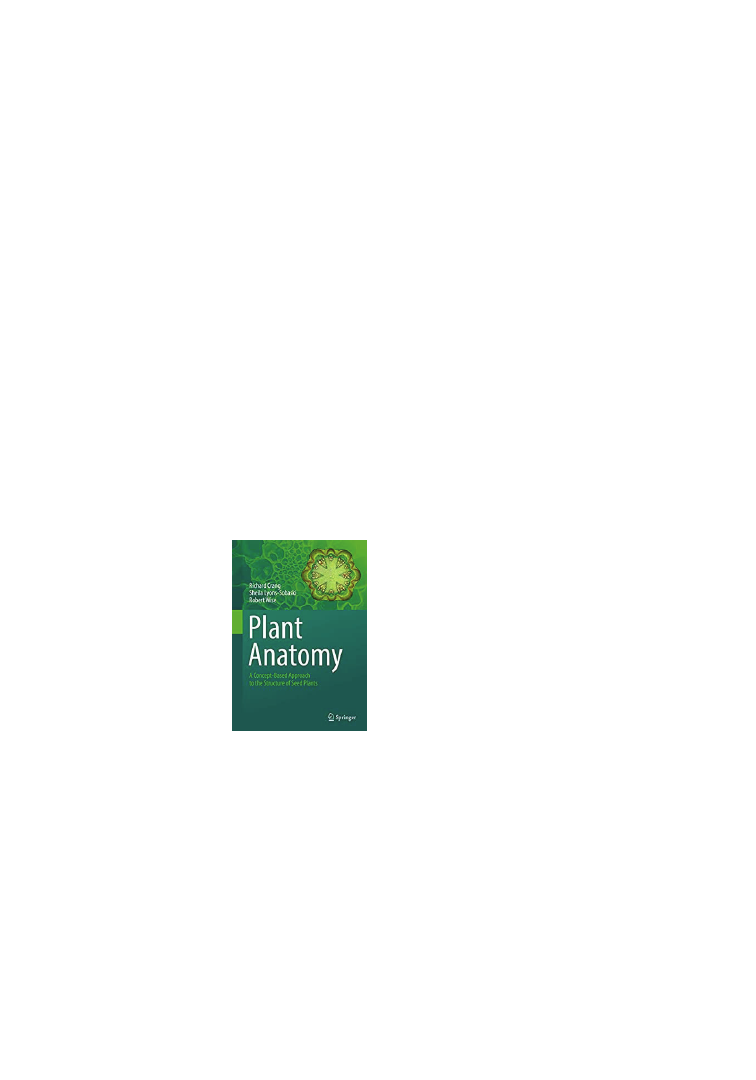
PSB 66 (3) 2020
261
strategies is no longer theory but a real
possibility. The writing is accessible, and
reference lists at the end of each chapter can
further guide readers who are unfamiliar
with the philosophy and science of ecosystem
assessment. This book should be added to
the toolkit of anyone directly involved in
natural resources policy, including educators
and science communicators who seek to
share information about developments in
conservation finance.
LITERATURE CITED
Potschin, M. and R. Haines-Young. 2016. Ecosystem
services in the twenty-first century. In: M. Potschin, R.
Haines-Young, R. Fish, and R.K. Turner (Eds.), Rout-
ledge Handbook of Ecosystem Services (pp. 1-9). Rout-
ledge.
—Andrea G. Kornbluh, Member, Botanical
Society of America
Plant Anatomy: A
Concept-Based Ap-
proach to the Structure
of Seed Plants
Richard Crang, Sheila Lyons-
Sobaski, and Robert Wise
2018. ISBN: 978-3-319-
77208-0
e-book: 51 €. 725 pp.
Springer
Plant Anatomy: A Concept-Based Approach
to the Structure of Seed Plants by Crang,
Lyons-Sobaski, and Wise is a beautifully
illustrated, 600+-page textbook highlighting
the wonderful diversity of anatomical form
in plants. The layout of the chapters follows
many traditional plant anatomy textbooks, as
one would expect from a book designed for
the classroom. Plant Anatomy begins with an
overview of plant morphology and proceeds
through evolutionary time and across systems
(Chapter 1: The Nature of Plants) before
zooming into the microscopic, internal world
of plant structures and their function (Chapter
2: Microscopy and Imaging, through Chapter
8: Phloem). Quite fortunately, historical
context is described throughout these sections,
highlighting seminal studies that have shaped
the plant sciences over the past 300+ years.
The book includes an overview of the
fascinating diversity of the major plant
groups, stunning microscopic images that
scientifically and artistically present the
comparative shapes and structural proportions
across groups. My attention was focused on
photos and microscopy images so much (e.g.,
Fig. 2.9 of autofluorescence of a blade of grass)
that I almost missed some of the interesting
biographical sections of founders of the
field. For example, Katherine Esau was an
immigrant due to war who worked to develop
a disease-resistant sugar beet before being
recruited to graduate school, after which
she wrote multiple, foundational textbooks
in plant anatomy and received the National
Medal of Science in 1989. Plant anatomy
students will easily engage with this historical
overview and introductory material but
should be encouraged to focus on microscopy
images and ensure they understand them early
on since they are a prominent component
throughout the textbook.
The vegetative structures section (Chapter
9: Epidermis, Chapter 10: Roots, Chapter
11: Stems, Chapter 12: Leaves) includes
contemporary studies and goes deeper into
function than similar textbooks in plant
anatomy. Each chapter includes colorful
photographs to show living examples of the
anatomical characteristics and functions
being described. Most chapters also include
diagrams and microscopy images of major
characteristics and important, sometimes
recent findings in the field. All readers

PSB 66 (3) 2020
262
will appreciate the bolded text indicating
corresponding definitions in the substantial,
20+-page glossary.
The most interesting and engaging chapter
describes the structural diversity of external
and internal anatomical features that secrete
oil, tannins, resins, salts, etc. from trichomes,
cavities, ducts, and idioblasts (Chapter 13:
Secretory Structures). This might be the most
interesting chapter because of how easy it is to
anthropomorphize plants when reading about
and seeing microscopy images of physical
defense structures including trichomes,
colleters, and stinging hairs. Or maybe it’s
reading about and seeing floral nectaries of a
milkweed plant, learning how they manipulate
pollinator behavior with complex anatomical
structures that force the pollinator to remain
on the flower long enough to ensure pollen
will likely transfer to the next flower it visits.
This chapter might also be the most engaging
because of the images of calcium oxalate
crystals that are illuminated with polarized
light, showing the sharp, pointed, almost fear-
inducing structures that, when consumed, “…
can lead to a severe numbing of the mouth
and throat and a temporary loss of speech.”
Each chapter concludes with a Chapter
Review section including a Concept Review
subsection, which does exactly that. These
sections also have standard quiz-like review
questions, some multiple-choice answers or
free response, and some with fill-in image
identification or matching definitions to
representative images. The value of visual aids
in recalling information and definitions in the
Chapter Review is clearly demonstrated when
reading about diagnostic characters in wood
(Chapter 15: Wood: Economics, Structure,
and Composition). A challenge here is to go
through microscopy images for 10 species and
match the images to descriptions one would
use to identify species or products, possibly for
forensics in the global furniture and lumber
economies. Readers will learn the difficulty
of taxonomic identification with fine-scale
descriptions including, “Diffuse-porous;
solitary and radial multiples; large to very large
pores in no specific arrangement, very few;
tyloses abundant; parenchyma vasicentric,
lozenge, confluent, and marginal; narrow to
medium rays, spacing normal.” Fortunately,
the authors make the process of learning plant
anatomy concepts non-burdensome since
the layout and progression of the chapters
allows instructors to slowly build on concepts
presented in previous chapters.
Overall, Crang, Lyons-Sobaski, and Wise
clearly created Plant Anatomy to make the
topic accessible and engaging to students at
both undergraduate and graduate levels. The
gorgeous pictures and colorful diagrams draw
attention to interesting patterns and processes
in the plant world and act as the backdrop to
well-written, engaging, and contemporary
text that will enable readers to enjoy learning
about the structure of seed plants.
Author’s note: Any use of trade, firm, or product
names is for descriptive purposes only and does
not imply endorsement by the U.S. Government.
-Daniel E. Winkler, Research Ecologist, U.S.
Geological Survey, Southwest Biological Sci-
ence Center

PSB 66 (3) 2020
263
Plant Names: A Guide
to Botanical Nomencla-
ture, Fourth Edition
Roger Spence and Rob Cross
2020.
ISBN-13:
978-1486311446
Hardcover, US $29.95.
212 pp.
CSIRO Publishing,
Clayton,
Victoria, Australia
The rules and requirements surrounding the
naming of plants can be quite daunting: the
language is full of jargon and terms in Latin,
the smallest difference in spelling can mean a
big difference in plants, and the names seem
to be constantly changing. Plant Names: A
Guide to Botanical Nomenclature, Fourth
Edition lays out the complications associated
with naming plants in a clear, concise, and
beginner-friendly manner. Roger Spence and
Rob Cross, horticultural botanists at the Royal
Botanic Garden Melbourne, carry on the work
originally started by the late Peter Lumley, to
whom this latest edition is dedicated. This
book is separated into four main sections
that address different aspects of botanical
nomenclature.
Part one is dedicated to the naming of wild
plants. The authors discuss the historical and
cultural uses of common names as well as the
utility of Latin or scientific names. Multiple
examples help the reader understand both
the value and confusion that can arise with
both types of names. This section moves
on to discuss the International Code of
Nomenclature for Algae, Fungi, and Plants, and
the fourth edition includes references to the
updated ICN. This section also explains the
hierarchical nature of biological classification,
the naming of new taxa, and what to do with
name changes. Overall, part one is a great
primer for plant systematics.
In the second section, the authors discuss the
naming of cultivated plants, or cultigens. This
includes detailed definitions (including the
differences between “cultivated plants” and
“cultigens”), as well as the details of introducing
and naming new cultigens, with references to
how this process differs from wild plants. They
also discuss aspects of marketing names, plant
breeder’s rights, and trade designations. The
fourth edition includes new information on
intellectual rights as they relate to cultigens.
I enjoyed the historical illustrations found in
this section and learned quite a bit about the
cultigen side of plant names!
The third part discusses the usage of plant
names, including a short section on writing
and pronouncing plant names, proper usage of
capitalization, italicization, and punctuation.
The basic guide to Latin pronunciation was
helpful, and I appreciated the caveat that
there are no strict rules when it comes to
pronouncing these plant names. The final
part is a list of various resources to assist
the reader in future endeavors, including
books and websites for accurate and up-to-
date names, the naming codes, and guides
to pronunciation, classification, and plant
breeder’s rights. Many of these are divided
and organized by region of the globe, and thus
are accessible to a broad readership.
This book is extremely aesthetically pleasing,
as the authors harness their knowledge of the
wonderful flora of Australia to highlight plant
names and features stunning photographs of
some of these iconic plants. The tables are
extremely helpful, and flowcharts elegantly
outline the decision-making process for
various questions related to plant names.
Within the main text there are also useful
“boxes” for additional information, asides,
and real-world examples.
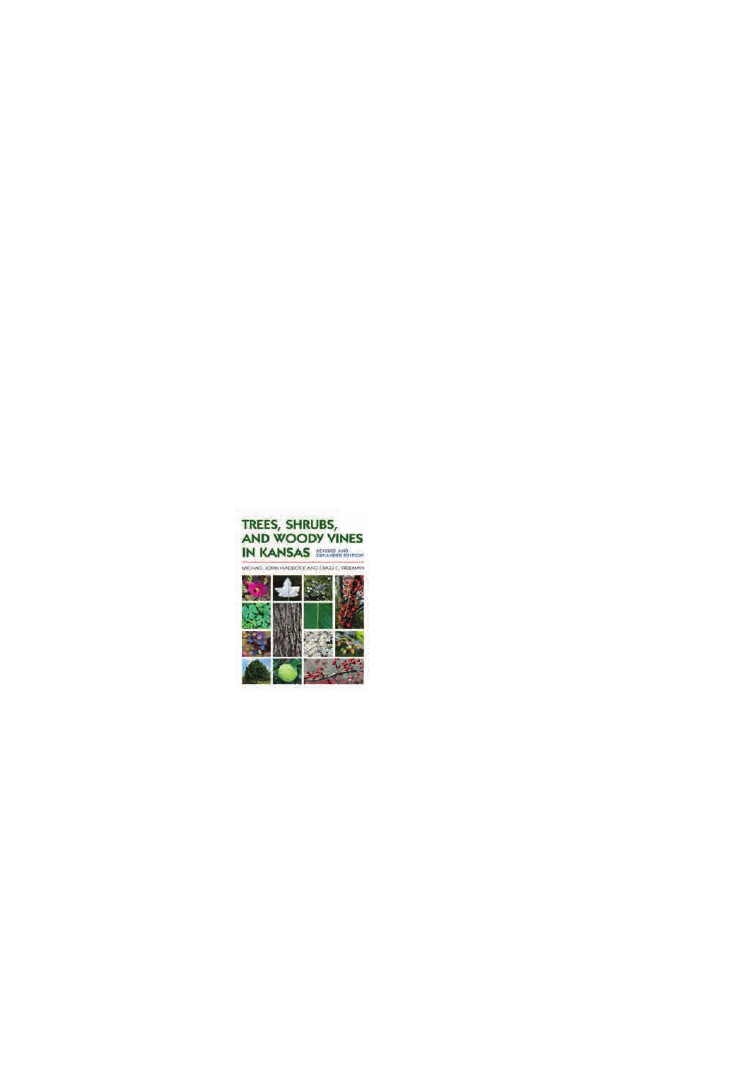
PSB 66 (3) 2020
264
I believe that this book is a handy resource for
anyone interested in plant diversity, including
both wild and cultivated plants. It is extremely
useful for both teachers and students of plant
systematics or horticulture and is also written
in a way that is accessible to a much broader
audience of plant enthusiasts interested in
gardening, house plants, or agriculture. This
updated fourth edition not only reflects the
most recent naming codes, but also includes
conventions regarding intellectual rights and
reading plant labels, which deal with the
industry aspects of plant names. This book
was a pleasure to read cover-to-cover and will
also serve as a great resource in the future.
—Nora Mitchell, Department of Biology, Uni-
versity of Wisconsin – Eau Claire, Eau Claire,
Wisconsin, USA
Trees, Shrubs, and
Woody Vines in Kansas
(revised and expanded
edition)
Michael John Haddock and
Craig C. Freeman
2019.
ISBN: 9780700627684
Paperback, US$26.95.
428 pp.
University Press of Kansas
H.A. (Steve) Stephens’ 1969 first edition of this
book is well known, and well used, in Kansas
and has gone through seven printings. Finally,
we have an attractive, revised, and updated
edition thanks to Haddock and Freeman.
The authors have expanded the treatment
from the 114 species in the original to 166,
primarily by adding full treatments for the 49
species Stephens specifically excluded because
they were not native. They also provide brief
notes, within species descriptions, to nearly
100 additional related woody species found
in the state and include a brief enumeration
of 28 “other Woody Species” at the end of the
book. Even these are included in the keys to
species at the beginning of the book, unless
they are rare ornamentals that do not appear
to be capable of reproducing and spreading.
The general format remains the same except
that color photos replace the black-and-
white images of the original edition. Most
species are treated in two facing pages with a
distribution map and descriptive paragraphs
for key characteristics of twigs, leaves, flowers,
fruits, trunk, and some general comments on
the top of each page and representative images
filling the lower half of the treatment. The
authors updated the distribution maps and
added several useful new categories including
the general Habit and Habitat, as well as
Inflorescence description and the status of the
plant: is it native or naturalized? With regard
to the latter, the authors list four plants in the
introduction that have become weedy pests:
Elaeagnus umbellate, Euonymus fortunei,
Lonicera maackii, and Pyrus calleryana. It
would be useful to include this in the Status
information on the respective species pages.
The general comment discussions have been
rewritten rather than just edited. I think this
strikes both ways. For instance, for Maclura
pomifera (Osage Orange), Stephens informs
us that the early American geologist William
McClure is honored by the genus name and
pomifera refers to “fruit-bearing”—some
interesting “tidbits” for a general reader.
Haddock and Freeman tell us that a current
theory is that fruits and seeds may have
been distributed by extinct megafauna—
again interesting to the general reader, but
also to specialists. This is actually a good
representation of the main difference in
focus of the new vs. the older edition. The
original definitely targeted a lay audience and
technical terms were kept to a minimum. It
would be especially useful for middle school

PSB 66 (3) 2020
265
and high school biology or nature-study
students. For instance, Stephen’s description
of the shape of the leaves as “egg-shaped, with
long, tapered tip, rounded or bluntly tapered
base…” becomes “blade ovate to ovate-
lanceolate or elipitic lanceolate…base cuneate
to rounded or subcordate…” in Haddock and
Freeman. Similarly, the only taxonomic key
in the original was to Kansas oaks, although
there was a general guide based on a few leaf
characters. Haddock and Freeman provide an
extensive, but very workable, key to species,
dividing first into major groups and providing
genus keys where appropriate. Appended
to the end of the book is an extensive, but
succinct, glossary of terms and a bibliography
of more than 80 works cited in the text. As
a professor at one of the state universities, I
much prefer the new edition as a resource for
my students.
The obvious audience for this book lives
in Kansas, but it will also be a very useful
reference for anyone living in the prairie or
plains region of the U.S. or Canada and an
excellent addition to herbarium libraries
and the libraries of botanists interested in
taxonomy and plant distribution.
—Marshall D. Sundberg, Department of
Biology, Emporia State University, Emporia,
Kansas
Vanishing Beauty: Native
Costa Rican Orchids
Franco Pupulin and 18 Col-
laborators
2020.
ISBN 978-3-946583-12-7
Hard cover: $280.
Color and line drawing illustra-
tions,
pages 425-1003 (previous
pages are in volume 1),
16 unnumbered pages.
Koeltz Botanical Books, Oberreifenberg, Germany
Despite being a small country, Costa Rica
(19,730 mi
2
or 51,100 km
2
) is reported to
have more than 1600 orchid species. The first
volume of this series, which I reviewed in
2006 (Arditti, 2006) covered Acianthera to
Kegeliella.
This, the second volume [33.7 (h) × 2 (w)
× 3.5 (thick), 4.28 kg] covers Laeaena to
Pteroglossa. It is as magnificent as the
first and now, like its predecessor, one of the
most beautiful books in my orchid library,
even when compared to the old tomes from
Victorian England, which are illustrated with
watercolor paintings. (Full disclosure: Franco
and I have been friends since my visit to Costa
Rica in 2003 to participate in an orchid lecture
series.) It is certainly one of heaviest because
of the very high-quality paper on which it is
printed.
Every genus is described clearly and in
detail. The descriptions include historical
information, classical taxonomy details, and,
when available, recent molecular findings.
These data are followed by a discussion
of the genus in Costa Rica. Horticultural
information is included for species that are
in cultivation (for example, Lankesterella).
The results in each case are scholarly essays
of varying length and content, which should
satisfy even the most demanding readers.
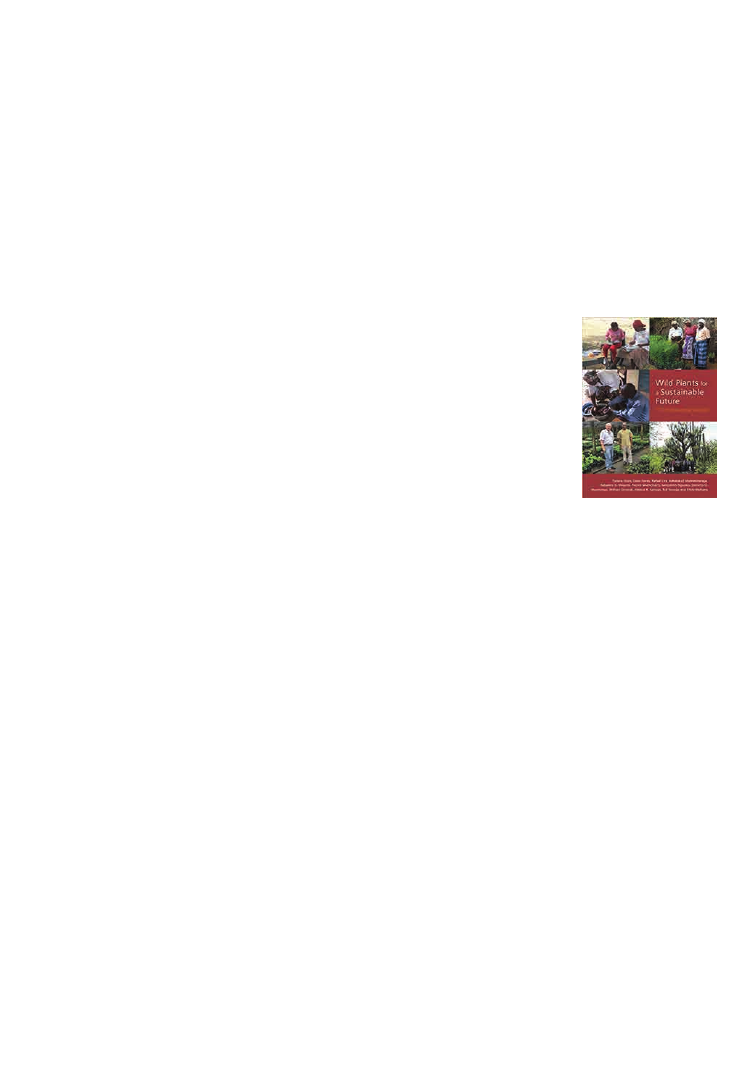
PSB 66 (3) 2020
266
Species are illustrated by at least one
photograph and in some cases by line
drawings. There are several photographs
of species, which have more than one form
(color, shape, size). For example, there are
four photographs of Laelia rubescens (pp. 428,
430, 431).
Great care was taken in photographing (for
details, see pp. 986-987) the orchids (with a
Nikon D200 camera), which are described
in this volume. The results are magnificent
photographs of very beautiful orchids. Sadly,
printing of some photographs does not always
do justice to their photographic excellence
and several illustrations are fuzzy (pp. 525,
598, 716, 838, 895, 957, and some others).
All authors can do is provide their publishers
with high-quality photographs. If these
photographs are not printed properly, the
responsibility is solely the publisher’s.
Many of the statements in the books are well
referenced. Cited literature is on pages 992–
995. The number of literature-cited pages
does not seem large, but due to the large page
size of this book, they contain more references
than usual.
The book concludes with two indexes:
taxonomic novelties (p. 906) and scientific
names (pp. 997-1003). As a rule, I do not
consider an index that contains only species
names to be sufficient, but since this is a flora,
additional indexing is not needed.
For its size and quality, Vanishing Beauty is
not expensive. It would be an excellent book
to acquire for private book collections or
coffee tables, give as a present, or, at the least,
recommend its purchase (and also volume
1) by institutional libraries. It is a good book
to have, give, refer to, and use as an example
of what an orchid flora should be. The only
problem I have with it is the need for someone
to help me lug it from my desk to a shelf in my
library. It is heavy!
LITERATURE CITED
Arditti, J. 2006. Vanishing Beauty. Plant Science Bul-
letin 52: 105.
–Joseph Arditti, Professor of Biology Emeritus,
University of California, Irvine
Wild Plants for a Sus-
tainable Future: 110
Multipurpose Species
Tizinia Ulian, César Flores,
Rafael Lira, Avhatakali
Mamatsharaga, Kebadire K.
Mogotsi, Patrick Muthoka,
Samodimo Ngwako, et al.,
Eds. 2019.
ISBN 9781842466735;
e-ISBN 9781842466742
Hardcover, £40.00. 490 pp.
Royal Botanic Gardens, Kew
https://www.kew.org/sites/default/files/2019-04/
Sustainable%20wild%20plants.pdf
Kew’s Millennium Seed Bank Partnership has
produced a noteworthy volume intended for
practitioners in governmental institutions and
non-governmental organizations working in
Africa and Latin America. The publication
forms one of the main dissemination
achievements of the MGU-Useful Plants
Project, to conserve and use sustainably wild
plants important for rural communities.
Institutional partners led the project in
each country, involving rural communities,
local authorities, and schools. The name
MGU reflects the support provided by the
philanthropist who funds the work of the
Useful Plants Project.
Since 2007, the Useful Plants Project has
been working collaboratively to conserve
useful species in seedbanks, propagation

PSB 66 (3) 2020
267
South Africa and Zimbabwe, Africa’s south;
and Mexico represents Latin America. The
deliberations upon which species included are
not stated, but the project mission provides
the following goals:
Targeting and prioritizing useful plants
with local communities. Enhancing the
propagation of native useful plants in
communities to support income generation
through the sustainable use of plants or
their products. Seed collections of useful
plants have been made and seed lots
stored in-country with duplicates tested
in Kew’s Millennium Seed Bank (MSB).
The capacity of communities to conserve
and use sustainably a wide range of plant
species has been enhanced through training
workshops and the improvement of local
facilities: useful plant gardens have been
established and plant nurseries enhanced
with the provision of materials and seeds.
As a result, species have been propagated
in partner countries and planted in local
community and school gardens involving
farmers and students.
The project generated research including
ethnobotanical, phytochemical, plant
physiological, and plant population studies,
and DNA profiling and in vitro propagation
that has been carried out on priority species.
Information about the uses, conservation, and
propagation of the species has been compiled
in leaflets, booklets, technical information
sheets, and posters that have been disseminated
within the country, to conserve and safeguard
the associated traditional knowledge. The
project has worked with village schools,
leading to the establishment of environmental
clubs, plant nurseries, and gardens.
I am personally gratified to learn that some
captivating plants appear here about which
in community nurseries and planting in
community gardens, woodlots and forests,
addressing the UN Sustainable Development
Goals “to end poverty, protect the planet and
ensure prosperity for all.” The Useful Plants
Project helps communities become better
equipped to face such challenges by improving
their livelihoods and using the surrounding
resources in a more sustainable way.
The book presents detailed species profiles
of 110 plants selected for their importance
to communities and livelihood for everyday
needs such as food, medicine, fuel, and
building materials. The profiles are presented
in a structured format, providing information
on taxonomy and nomenclature, plant
descriptions, fruit and seed structures,
distribution, habitat, uses, known hazards and
safety, conservation status, seed conservation,
propagation, and trade, with literature
references. The volume is organized into five
sections, presented by country, compiled by
experts from each. The rationale is a response
to the range of threats that plants face,
including climate change, over-exploitation,
shortage of water, habitat loss, and invasion of
exotic species. Most are trees and shrubs, along
with cacti, sub-shrubs, and several perennial
and annual herbs. Illustrations feature images
of the plants in the wild, associated habitats,
seed morphology, and cultivation. A glossary
of botanical terms completes the book, with
index of botanical names, list of common and
vernacular names, and graphic presentation
of habit and usage of each species.
The authors are based at universities,
agricultural, forestry, and natural resource
institutes, and although the book does not
define the selection criteria about which
countries were spotlighted, presumably they
are the home countries of the participants. East
and West Africa exemplify Kenya and Mali;

PSB 66 (3) 2020
268
I had been told there was no known use in
Sudan, such as Citrullus lanatus (Thunb.)
Matsum. & Nakai, and Ocimum gratissiumum L.
Illustrations are among the volume’s most
indispensable contributions, helpful to
consultants and broadly to future researchers.
As species entries were written by multiple
authors, there is some variation among
the chapters. A few references cited are
unpublished reports and theses that might
not be widely available in practice; others are
web resources, hence problematic in locations
where internet services are unavailable or
expensive. That aside, this input should help
to build the capacity of local communities to
successfully conserve and use these species
sustainably.
–Dorothea Bedigian, Research Associate,
Missouri Botanical Garden, St. Louis, Missouri,
USA
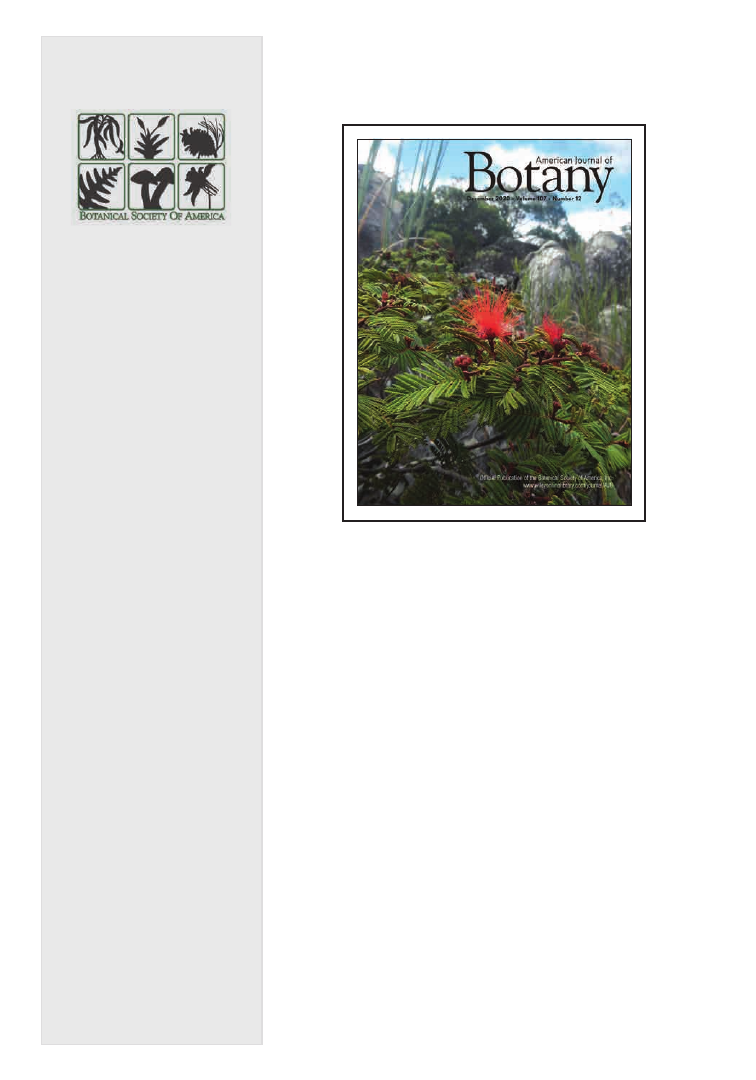
Plant Science Bulletin
The Botanical Society of
America is a membership soci-
ety whose mission is to: pro-
mote botany, the field of basic
science dealing with the study
& inquiry into the form, func-
tion, development, diversity,
reproduction, evolution, & uses
of plants & their interactions
within the biosphere.
ISSN 0032-0919
Published 3 times a year by
Botanical Society of America, Inc.
4475 Castleman Avenue
St. Louis, MO 63166-0299
Periodicals postage is paid at
St. Louis, MO & additional
mailing offices.
POSTMASTER:
Send address changes to:
Botanical Society of America
Business Office
P.O. Box 299
St. Louis, MO 63166-0299
bsa-manager@botany.org
The yearly subscription rate
of $15 is included
in the membership
Address Editorial Matters (only) to:
Mackenzie Taylor, Editor
Department of Biology
Creighton University
2500 California Plaza
Omaha, NE 68178
Phone 402-280-2157
psb@botany.org
Plant Science Bulletin
Fall 2020 Volume 66 Number 3
As the pages of the Plant Science Bulletin this year have
reflected, the events of 2020 have had profound impacts
on the research, the plans, and mental well-being of your
colleagues and friends in the BSA and the botanical
community. The lessons from this past year are still being
learned, and we hope that positive outcomes are in our
collective future. Here's to uniting globally and relying on
each other in 2021.
In that spirit, we end the year with a splash of color
from the final American Journal of Botany of 2020:
a mimosoid legume courtesy of Dr. Erik Koenen!
(See his related article at https://bsapubs.onlinelibrary.
wiley.com/doi/10.1002/ajb2.1568.)

PSB 66 (3) 2020
270
Enrich your remote teaching with free
sequence analysis software for your students
Preparing students for a career in
science can be challenging enough
without the hurdle of online teaching.
Help your students get more hands-
on experience at home by giving them
access to professional sequence
analysis software.
“Not sure what we would have done without it in this
pandemic era, with so much remote learning. Giving
students access to such a powerful tool really opened
up what we were able to teach them, and improved
the students’ understanding of difficult concepts.”
Lindsay Leahul
Mount Royal University
To learn more about our free educational software,
visit us at www.dnastar.com